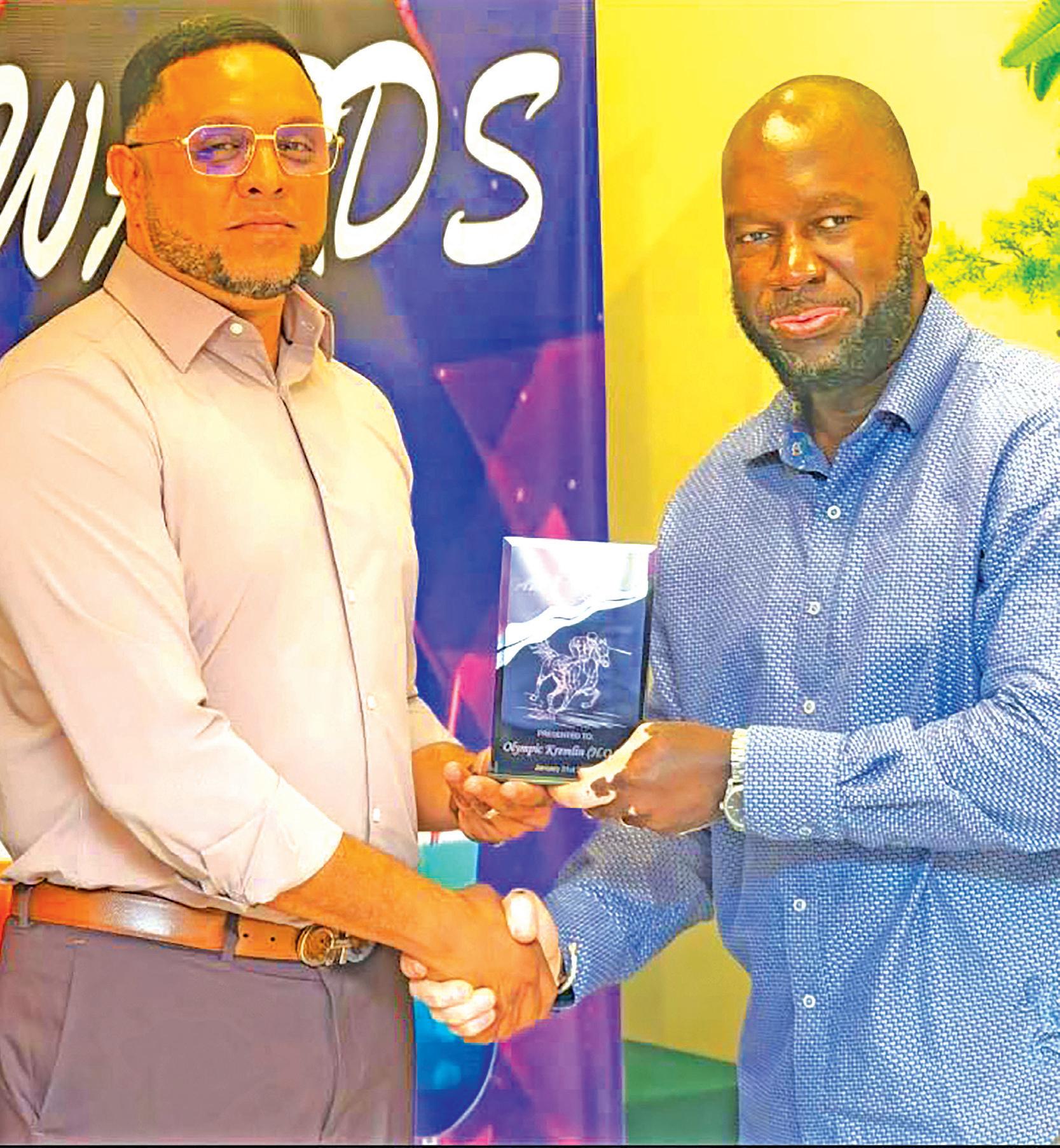




Drought presents challenges, but not fatal to hydro development – Jagdeo ...says hydropower outcompetes wind energy, solar energy as base load UNEP calls on Caribbean to strengthen commitment to wetland protection
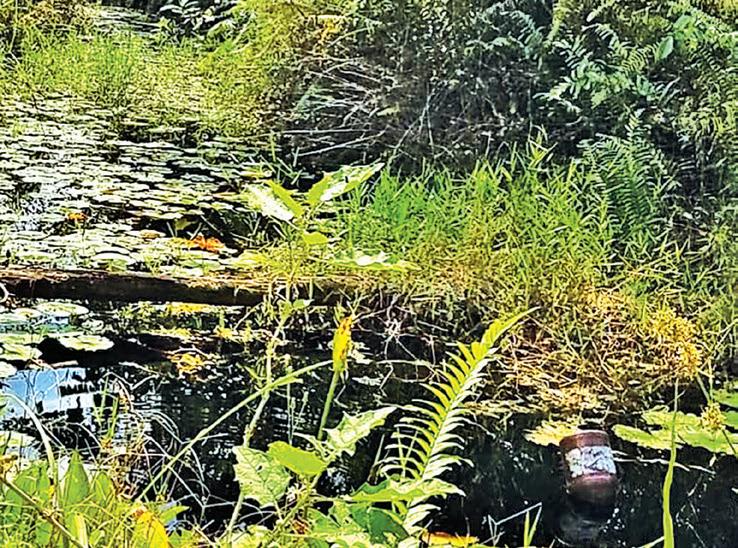
– more locals from BIT, CNOOC partnership to also find work in oil & gas

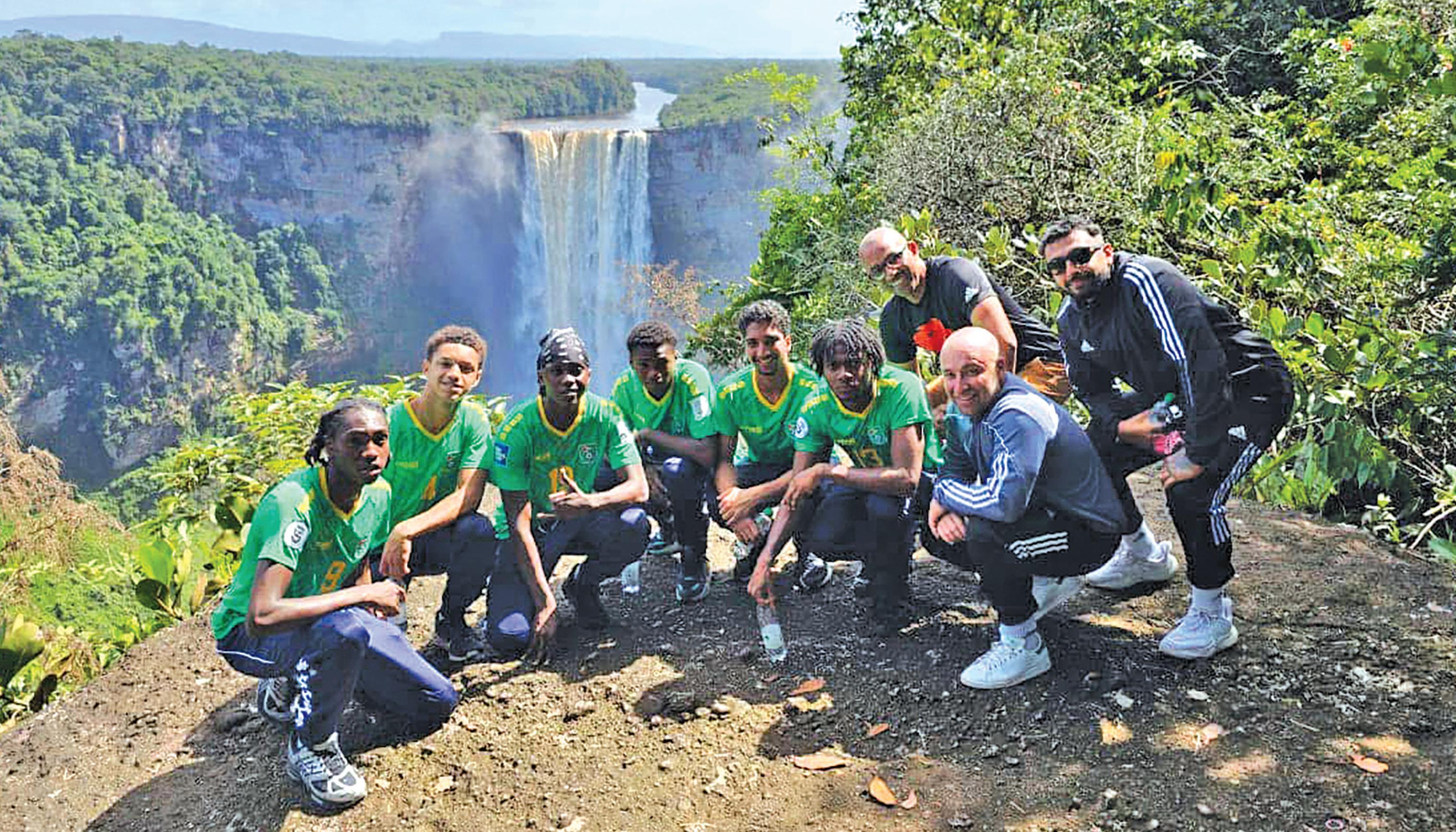
GuySuCo “working aggressively” to reduce cost of production – Mustapha

Ministry of Housing to build 133 core homes this year – Croal
Linden Town Council mulls expanding services online through MMG app
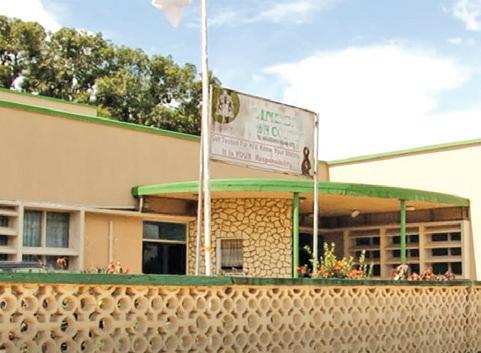
2 men convicted for murder of vendor during armed robbery


Weeder walks free after paying restitution in stolen motorcycle case

Commemorating World Neglected Tropical Diseases Day 2025

Homes on Aubrey Barker Road reserves hindering expansion
...Govt committed to supporting residents in relocation efforts – says steel and cement subsidy programme to continue through 2025 ...says $B spent to restore industry after coalition’s destruction
Guyana to implement number portability service Feb 10

Recognising that drought conditions pose certain challenges, Vice President Dr Bharrat Jagdeo believes these would not be fatal to hydropower development in Guyana.
Currently, Guyana’s South American neighbour – Suriname – is on the brink of what has been described as a “severe power crisis” after critically low reservoir water levels have caused the Dutch-speaking nation’s hydroelectric power station to experience a reduction in output.
The People’s Progressive Party/Civic (PPP/C) Administration has been keen on reviving the 165-megawatt (MW) Amaila Falls Hydropower Project (AFHP) which has been on the cards since 2011 but was blocked by the APNU+AFC (A Partnership for National Unity+Alliance For Change) Coalition both in and out of office.
During his weekly press conference on Thursday last, Jagdeo was asked about Government’s plans to update its hydrology studies including climatic predictions before investing

in any such large-scale hydropower project.
According to the Vice President, “…you have to, out of necessity, look again at hydrology [and] hydrology risk. But the model also, that we have pursued in the past, and we intend to pursue places the risk to some extent, on the investor because they will not be paid for energy. They may be paid for capacity, but not energy, for the period when they don't supply power. And since that facility will not be owned by the Government of Guyana, then we share the risk…
But clearly an investor, if they're coming in to invest and needs a sort of return to justify the investment, they would have to examine that [risk] themselves to see because it's their money that they'll be using.”
As the Guyana Government looks to revive the Amail Falls Hydropower Project, it has been adamant about doing so under a Build-Own-OperateTransfer (BOOT) model to lessen the investment risks on the State.
While the Vice President acknowledged that climate change has posed challeng-

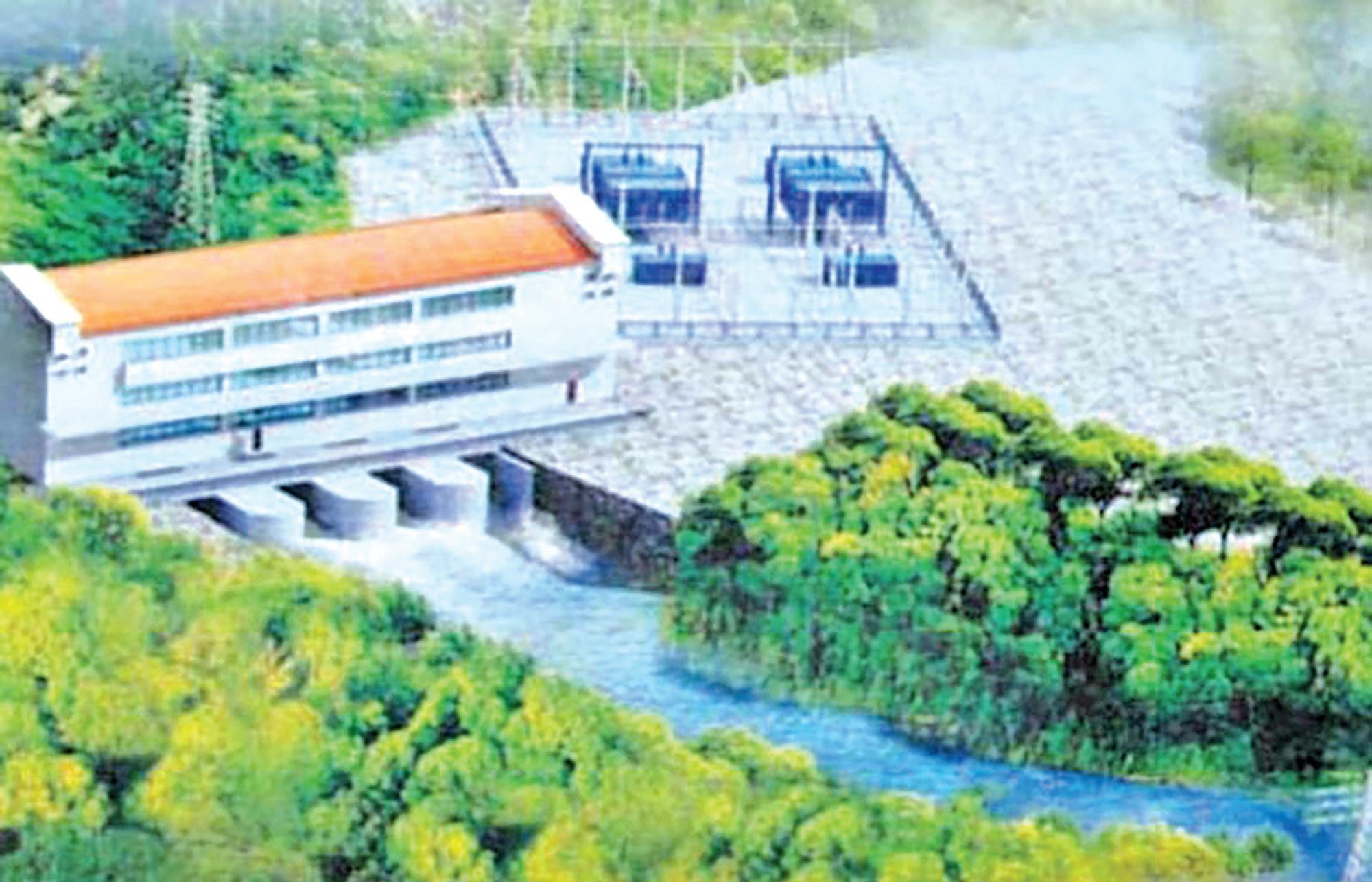
es for hydropower development, he believes that this is still a viable energy source.
“I don't think you can stop building hydros globally… You have the challenge of more variable weather patterns globally so I think this will impact on water supply… This will have implication for reservoir size and your backup capacity. So, if you build it and you have a period where you have drought then you have to have adequate backup power to fill the energy demand of the country in the period when you have the drought. So, [drought] does present challenges, but I don't see it as fatal to the development of hydropower. But of course, when you develop it, you have to ensure that your studies are done and updated,” he posited.
Jagdeo went on to point out that not only is hydropower more cost-effective but also more stable than other energy sources such as solar and wind.
“I don't think you can beat hydropower at this stage in terms of cost and being base load at the same time. Notice I said base load, because you can get maybe solar power cheaper, but it's not base load and what I mean [is that] it doesn’t run 24 hours a day continuously. If you put in the batteries [for solar], then the cost goes up significantly. So, if you do a grid tie-in system, you might get it fairly around the same price as the hydro, but that means you can only get it in sunlight when there is sunlight. If you go to put in batteries the cost goes up
significantly. So, hydropower, at this point in time, today, will out-compete wind energy and solar as base load, and still be competitive in terms of price of energy,” he contended.
The 165-megawatt (MW) AFHP was the flagship initiative of the Bharrat Jagdeo-crafted Low Carbon Development Strategy (LCDS). However, the project failed to take off despite having a developer in United States-based Sithe Global, which was backed by investment major – The Blackstone Inc.
In August 2013, Sithe Global announced that it was pulling out of the project, which it said was too large to continue without national consensus, and had cited the lack of consensus in Parliament. At the time, the then APNU and AFC oppositions, holding majority seats in the National Assembly, had both voted down key pieces of legislation which consequently halted the project.
Then during its term in office from 2015 to 2020, the APNU/AFC Coalition Administration again shelved the project.
The revival of the 165MW hydropower project was one of the promises made by the ruling PPP/C in its 2020 Manifesto. In November 2021, the AFHP was awarded to China Railway First Group (CRFG) in November 2021 but those talks fell through after the company wanted to change the BOOT model which Government rejected.
A revised Request for Proposals (RFP) was is-
sued in 2023 and four companies – Rialma S.A. (Grupo Rialma) from Brazil; China International Water & Elec. Corp; Lindsayca CH4 Guyana Inc., and a group made up of OEC, GE Vernova and Worley – had submitted tenders to be pre-qualified for the Amaila Falls Hydro project.
However, last month VP Jagdeo told the Guyana Times that Government would have to re-tender the project after much attention was not placed on the bids that came in.
“We didn’t focus on it [so] we’d have to re-tender that project,” he stated. While this project would now roll over to the PPP/C’s 2025 Elections Manifesto, Jagdeo, who is also the General Secretary of the party, explained that it is part of a continuous energy mix that his Government is pursuing.
“What we’ve committed to is an energy mix that is sustainable and hydropower is part of that energy mix so it has to be part of our ongoing plan. So, it is a combination of gas, wind, solar and hydro – that’s the energy mix of the future. Clearly, we’re moving to the gas, which you saw will cut our emission profile. We’re doing some solar. We’re examining some wind but for smaller communities, and hydro will be a part of it. So, [the AFHP] will have rollover as part of our commitment to a cleaner energy mix for the future as part of our energy transition,” the Vice President told this newspaper at a January 2 press conference.



The Demerara Harbour Bridge will be closed to vehicular traffic on:
Monday, February 3 –21:00h-22:30h and Tuesday, February 4 – 21:30h-23:00h.
The Berbice Bridge will be closed to vehicular traffic on:
Monday, February 3 –07:25h-08:55h and Tuesday, February 4 – 08:10h-09:40h.

Parika and Supenaam departure times – 05:00h, 10:00h-12:00h, 16:00h, 18:30h daily.





Thundery to light showers are expected throughout the day and at night, interrupted by sunshine in the late afternoon. Temperatures are expected to range between 23 degrees Celsius and 29 degrees Celsius.
Winds: North-Easterly to East North-Easterly between 2.23 metres and 4.92 metres.
High Tide: 07:57h and 20:24h reaching maximum heights of 2.66 metres and 2.58 metres.
Low Tide: 13:55h reaching a minimum height of 0.56 metre.










– more locals from BIT, CNOOC partnership to also find work in oil and gas

The first batch of 24 graduates from the Guyana Technical Training College (GTTC) have already found employment on board the Liza Unity Floating Production Storage and Offloading (FPSO) vessel, with a number of other upcoming graduates from Government sponsored programmes expected to find employment in the oil and gas sector.
This was explained by Natural Resources Minister Vickram Bharrat, during the recent consideration of the budget estimates for his agency. The Minister was at the time explaining the programmes available for Guyanese to be trained to work in the oil and gas sector, including the Petroleum Programme at the University of Guyana (UG) which is now free.
“So that means, any young Guyanese that wants to study in the field, can go and register at University of Guyana, free of cost. Besides that, we are building out the Guyana Technical Training College in Berbice. And that Technical Training College has already graduated. I personally was at one of the graduations, where 24 Guyanese from across the country graduated and they’re working on the Liza Unity FPSO as we speak.”
“Recently another 25 were graduated from that programme. And we will continue to see young people graduating from the Guyana Technical Training College, to work in the oil and gas sector, besides the free University education. And there is a petroleum programme at the
University of Guyana,” Bharrat also explained.
Added to this, there are Guyanese currently studying at China, under a scholarship programme in which the Government of Guyana partnered with Stabroek block co-venturer CNOOC. In addition, there is the Board of Industrial Training (BIT).
“We have about 10 young Guyanese, through a partnership with CNOOC, who are studying in China presently on a scholarship programme. And they will re-
turn soon to work in the oil and gas sector in Guyana,” the Minister explained.
“As well as a number of other persons who are studying through the BIT programme and other scholarship programmes, who will offer services to the oil and gas sector. That is what we are doing with regards to training, so that young Guyanese can be certified and trained to work in the oil and gas sector.”
The 24 students who graduated from Port Mourant, Region Six (East
Berbice-Corentyne) based GTTC, also known as the ‘Oil and Gas Institute’, had completed courses in instrumentation, production, electrical, and mechanical fields.
The first phase of the state-of-the-art facility was commissioned on February 9, 2024– an initiative largely led by SBM Offshore Guyana, Stabroek block partners ExxonMobil, Hess and CNOOC, and the Government of Guyana.



Editor: Tusika Martin
News Hotline: 231-8063Editorial: 231-0544, 223-7230, 223-7231, 225-7761
Marketing: 231-8064Accounts: 225-6707
Mailing address: Queens Atlantic Industrial Estate Industrial Site, Ruimveldt, Georgetown
Email: news@guyanatimesgy.com, marketing@guyanatimesgy.com
As we continue to set the foundations of our development, we will have to confront implications of the philosophical bases immanent in those foundations which remain implicit and not given much thought.
The following is excerpted from the book, “Cities made differently” by Nika Dubrovsky and David Graeber, in which they analogise societies to cities, of which we consider two: A City ?f Runners and a City as a Family. We should reflect on creating a middle ground for Guyana.
“The people who live in the City of Runners city believe that real life is all about constant competition. They find it fascinating or even necessary to keep track of who among them is more important, who is richer, smarter, more beautiful, or more worthy. There are many ideas about how the city came to have habits like this.
“One of the city’s revered philosophers, Thomas Hobbes, believed that the natural state of human beings is to seek violent domination over their neighbours, and that society without the authority of the sovereign would quickly turn into a battle of all against all. Constant competition between people is thus seen as an enjoyable game as compared to real war, which is always lurking around the corner.
“Naturally, in cities like this, there must be some who are poor, ugly, and unhappy. Just as in some children’s games, there are winners and losers. People living in the city of runners foster an admiration for winning in their kids, and an ambition to surpass their peers in all areas. Children in the city of runners have no interest in learning together, sharing, or mutual aid. Helping someone pass an exam is considered “cheating” and is strictly punished. All their lives, adults are engaged in constant competition over beauty, skill, and wealth. Runners believe that people who live differently from them and who refuse to play their games simply choose to be losers
“Then there is the City as a Family. Imagine a city without any strangers, where everything is shared, and everyone looks after each other. There are no shops, no money, and no danger at all. We think of the family as a group that practices “basic communism”: from each according to his ability to each according to his needs. Any family is thought to be protected by bonds of kinship from the cruel laws of the outside world. Unlike businesses, rarely will a family throw out a sick child or an elderly parent because they are no longer “revenuegenerating assets”.
“According to Roman law, which still underlies the value system of Western societies, a family was all those people living within the household of a paterfamilias or father whose authority over them was recognised as absolute. Under the protection of her father, a woman might be spared abuse from her husband, but their children, slaves, and other dependents were his to do with as he wanted.
“According to early Roman law, a father was fully within his rights to whip, torture, or sell them. A father could even execute his children, provided that he found them to have committed capital crimes. With his slaves, he didn’t even need that excuse. The patriarchal family is also the model for authoritarianism. In ancient Rome, the patriarch had the right to treat his household members as property rather than as equal human beings.
“The Enlightenment philosopher Jean-Jacques Rousseau believed that humankind originally lived in small bands of hunter-gatherers composed of close friends and relatives until big cities and agriculture emerged, and with them wars, greed, and exploitation.
“However, archaeology shows us numerous examples of how people in different times and across different parts of the Earth lived in large metropolitan areas while managing their collective affairs on a fairly egalitarian basis. At the same time, there have always been small communities where status inequality prevailed and a privileged minority at the top benefited by exploiting the rest.
“We know from our personal experience that in almost every family there are elements of both authoritarianism and baseline communism. This contradiction never fully goes away, but different cultures handle it differently.”
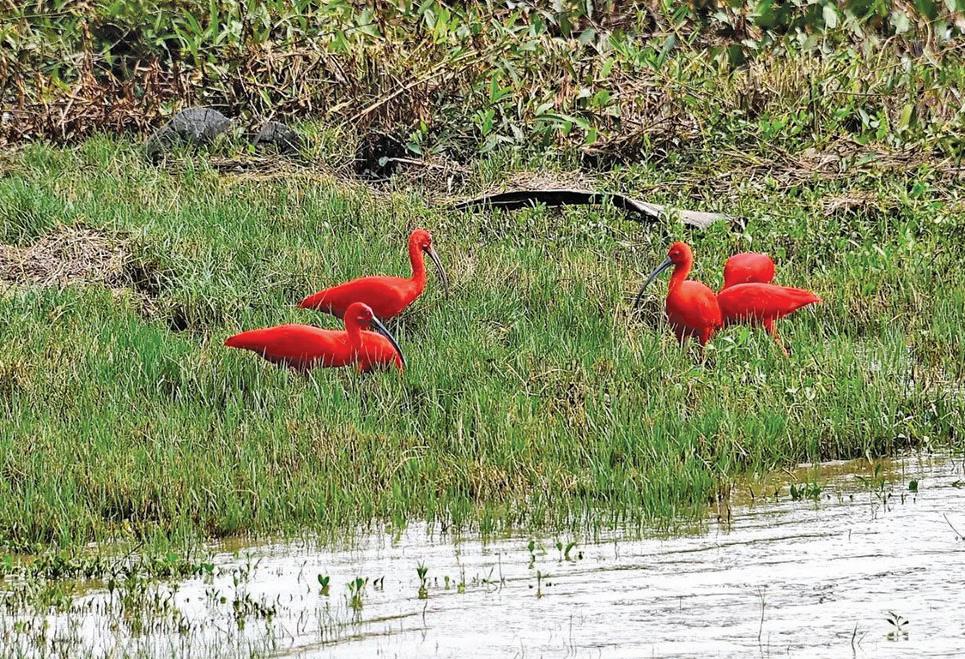
Can science be both open and secure? Nations grapple with tightening research security as China’s dominance grows
By Caroline Wagner
Amid heightened tensions between the United States and China, the two countries signed a bilateral science and technology agreement on Dec. 13, 2024. The event was billed as a “renewal” of a 45-year-old pact to encourage cooperation, but that may be misleading.
The revised agreement drastically narrows the scope of the original agreement, limits the topics allowed to be jointly studied, closes opportunities for collaboration and inserts a new dispute resolution mechanism.
This shift is in line with growing global concern about research security. Governments are worried about international rivals gaining military or trade advantages or security secrets via cross-border scientific collaborations.
The European Union, Canada, Japan and the United States unveiled sweeping new measures within months of each other to protect sensitive research from foreign interference. But there’s a catch: Too much security could strangle the international collaboration that drives scientific progress.
As a policy analyst and public affairs professor, I research international collaboration in science and technology and its implications for public and foreign policy. I have tracked the increasingly close relationship in science and technology between the U.S. and China.
The relationship evolved from one of knowledge transfer to genuine collaboration and competition.
Now, as security provisions change this formerly open relationship, a crucial question emerges: Can nations tighten research security without undermining the very openness that makes science work?
China’s rise in scientific publishing marks a dramatic shift in global research. In 1980, Chinese authors produced less than 2% of research articles included in the Web of Science, a curated database of scholarly output. By my count, they claimed 25% of Web of Science articles by 2023, overtaking the United States and ending its 75year reign at the top, which had begun in 1948 when it surpassed the United Kingdom.
In 1980, China had no patented inventions. By 2022, Chinese companies led in U.S. patents issued to foreign companies, receiving 40,000 patents compared with fewer than 2,000 for U.K. companies. In the many advanced fields of science and technology, China is at the world frontier, if not in the lead.
Since 2013, China has been the top collaborator in science with the United States. Thousands of Chinese students and scholars have conducted joint research with U.S. counterparts.
Most American policymakers who championed the signing of the 1979 bilateral agreement thought sci-
ence would liberalize China. Instead, China has used technology to shore up autocratic controls and to build a strong military with an eye toward regional power and global influence.
Leadership in science and technology wins wars and builds successful economies. China’s growing strength, backed by a state-controlled government, is shifting global power. Unlike open societies where research is public and shared, China often keeps its researchers’ work secret while also taking Western technology through hacking, forced technology transfers and industrial espionage. These practices are why many governments are now implementing strict security measures.
The FBI claims China has stolen sensitive technologies and research data to build up its defence capabilities. The China Initiative under the Trump administration sought to root out thieves and spies. The Biden administration did not let up the pressure. The 2022 Chips and Science Act requires the National Science Foundation to establish SECURE – a centre to aid universities and small businesses in helping the research community make security-informed decisions. I am working with SECURE to evaluate the effectiveness of its mission.
Other advanced nations are on alert, too. The European Union is advising member states to boost security measures. Japan joined the United States in unveiling sweeping new mea-
sures to protect sensitive research from foreign interference and exploitation. European nations increasingly talk about technological sovereignty as a way to protect against exploitation by China. Similarly, Asian nations are wary of China’s intentions when it seeks to cooperate.
Australia has been especially vocal about the threat posed by China’s rise, but others, too, have issued warnings. The Netherlands issued a policy for secure international collaboration. Sweden raised the alarm after a study showed how spies had exploited its universities.
Canada has created the Research Security Centre for public safety and, like the U.S., has established regionally dispersed advisers to provide direct support to universities and researchers. Canada now requires mandatory risk assessment for research partnerships involving sensitive technologies. Similar approaches are underway in Australia and the U.K. Germany’s 2023 provisions establish compliance units and ethics committees to oversee security-relevant research. They are tasked with advising researchers, mediating disputes and evaluating the ethical and security implications of research projects. The committees emphasize implementing safeguards, controlling access to sensitive data and assessing potential misuse.
Dear Editor, Laughter is sometimes recommended by the doctor to be a good medicine for stress relief, and one of the best providers is the National Assembly of the Parliament of Guyana, where the 2025 Budget debates are taking place.
The PNC once again proved that their party remains dead meat, the worst possible alternative, without substance, insignificant and the centre of attraction for comedy. The toxic Opposition is living up to their poisonous legacy of being unable to run a cake shop, their devastating history of being proud enablers of vitriolic debates and their fervent duty of religiously spewing venom.
Hailed as a bigger budget with better benefits to allow bolder breaks, Budget 2025 is yet another ground-breaking trillion-dollar budget, closely following the footsteps of the pacesetter, the trillion Dollar Budget 2024.
Yet, most of the malicious members of the mendacious PNC, cannot find anything good about the budget to support it. But hark, a moment of hope did glimmer with the conscience of a few who dared to antagonize the PNC in defiance and deviate to support the Budget because they found it good for the people of Guyana.
A few good women and men on the other side of the bench did not follow the ‘quick sand’ policy of the PNC as they recognized, acknowledged and endorsed the right side of development. Will this be consequential for the rebels and viewed as a mutiny or a revolt?
The Opposition is once again washing their dirty laundry in the public, showing how volatile they are in skulduggery by distorting facts. The young, budding and bright economist needs to acknowledge that the graphics of the country reflect real growth. They ex-
posed themselves so that Dave can see all the way to Arizona by tainting the truth.
It was the downside of the PNC’s 33 years of mismanagement which created the downsizing of Guyana’s economy. The young ones should undress themselves from the PNC circus. Unable to calculate the half of 65, imagine how mind boggling it must be to handle a trillion-dollar figure. They have the “GADZOOKS” to then tread on Minister Priya Manickchand’s territory, and want to talk about educating the children of Guyana.
APNU/AFC has the temerity to talk about resuscitating sugar after murdering the industry and drinking the blood of the workers. Imagine, the Opposition now debating about APNU/ AFC wanting to revive and develop GuySuCo after vandalizing and destroying the Corporation during their last tenure, by closing four
estates and putting over seven thousand sugar workers on the breadline!
This statement certainly tickled the ribs of the PPP/C Parliamentarians, which produced roars of laughter that spelled sarcasm and mockery. This devastated move by a heartless PNC Government, certainly brought tears to the workers, destroying the livelihood of over forty thousand people, creating social disorders and even suicides.
As a nation mourned the death of sugar in 2016, the PNC danced away and sang the praises of a devious Granger leadership while the workers, business, farmers, suppliers and families plummeted into poverty and bankruptcy. “Sugar will not die,” boasted the PNC in their 2015 election campaign as Naga and Janjat coerced the people to vote for the AFC.
And now the Opposition has the “CHUTZPAH” to feign compassion for the
Japan’s 2021 policy requires researchers to disclose and regularly update information regarding their affiliations, funding sources – both domestic and international – and potential conflicts of interest.
A cross-ministerial R&D management system is unrolling seminars and briefings to educate researchers and institutions on emerging risks and best practices for maintaining research security.
The Organisation for Economic Co-operation and Development keeps a running database with more than 206 research security policy statements issued since 2022.
Emphasis on security can strangle the inter-
national collaboration that drives scientific progress. As much as 25% of all U.S. scientific articles result from international collaboration. Evidence shows that international engagement and openness produce higher-impact research. The most elite scientists work across national borders.
Even more critically, science depends on the free flow of ideas and talent across borders. After the Cold War, scientific advancement accelerated as borders opened. While national research output remained flat in recent years, international collaborations showed significant growth, revealing science’s increasingly global nature.
The challenge for re-

search institutions will be implementing these new requirements without creating a climate of suspicion or isolation. Retrenchment to national borders could slow progress. Some degree of risk is inherent in scien-
FROM PAGE 4
tific openness, but we may be coming to the end of a global, collaborative era in science. (Courtesy of The Conversation) Caroline Wagner is Professor of Public Affairs, The Ohio State University

workers and to ask Guyanese to trust them. How can Guyanese trust the PNC when they turn around and stab you in the back? How can you trust them when they failed to deliver on their promise to increase sugar workers’ wages? How can workers trust the PNC when the poor workers were sent home without any compensation for months? Without a Ministry of Labour, no wonder workers were left outside in the cold.
The bombastic PNC had the audacity to talk about integrity. Yet, it was the same PNC who attempted to subvert the will of the people in their brazen attempt in front of the eyes of the world to rig the 2020 general and regional elections. Yes, Guyanese and the world at large will remember them and will not forget when election 2025 comes around. When the wicked PNC ruled from 2015 to 2020, they squatted for two years and refused to hold an election when it was due three months after the No Confidence Motion was passed in 2018.
Caught with their pants down, the young PNC members were misled and forced to sing their shenanigans for their supper, only to be ultimately ridiculed, as they were found wanting by the PPP/C who educated them with facts, figures and formulas. The heist of shame was very presumable as the
presumptuous PNC delivered their expected load of malarkey with unreserved impertinence. Wanting to showcase their achievements, the PNC left the door wide open to remind Guyanese how their squander-mania brought Guyana to its knees.
The PNC wants the nation to know the PPP/C Government by their “Deeds.” A slip of the tongue from the learned friend? What a compliment the opposition paid to an administration, which has crossed the border to fulfil its Manifesto and keep their promises they made during the 2020 General and Regional Election.
The PPP/C has fulfilled their obligations and Guyana can now depend on President Ali and the PPP/C to continue the transformation of Guyana from poverty to prosperity, from destruction to development, from hindrance to headway and from ruckus to repose.
The PNC has once again shown their sharp steel and have failed to temper their sword of nescience. With their tarnished track record not based on truth, trust nor tranquillity, they will unavoidably and understandably be debating Budget 2026, sitting on the same side of the bench.
Sincerely, Jai Lall



1. If the pattern continues, which two figures will have a total of 13 marbles?
(A) Figures 3 and 4
(B) Figures 3 and 5
(C) Figures 4 and 5
(D) Figures 4 and 6
2. Which of the following statements describes an empty set?
(A) Factors of 4
(B) Months with 31 days

(C) Vowels in the English alphabet
(D) Prime numbers between 7 and 11

3. Which of the two sets above are equal?
(A) K and L
(B) L and S
(C) S and M
(D) K and M
4. Given that Set A = (months of the year beginning with letter J), which of the following sets is equivalent to Set A?
(A) (B)
(B) {C, D)
(C) (W, X, Y)
(D) (P, Q, R, S}



5. (7+14) x2-17 = (A) 11 (B) 10 (C) 22 (D) 25


6. Which of the following numbers is exactly divisible by 3?
(A) 162 (B) 166 (C) 169 (D) 172
7. If 525 sweets were shared among 5 girls, how many sweets would each girl receive? (A) 25 (B) 105 (C) 110 (D) 125
8. What is the average of 13, 19 and 28? (A) 3 (B) 19 (C) 20 (D) 60

9. What is 0.2 expressed as a fraction?






By Lewis CarroLL

How doth the little crocodile Improve his shining tail, And pour the waters of the Nile On every golden scale! How cheerfully he seems to grin, How neatly spreads his claws, And welcomes little fishes in, With gently smiling jaws!


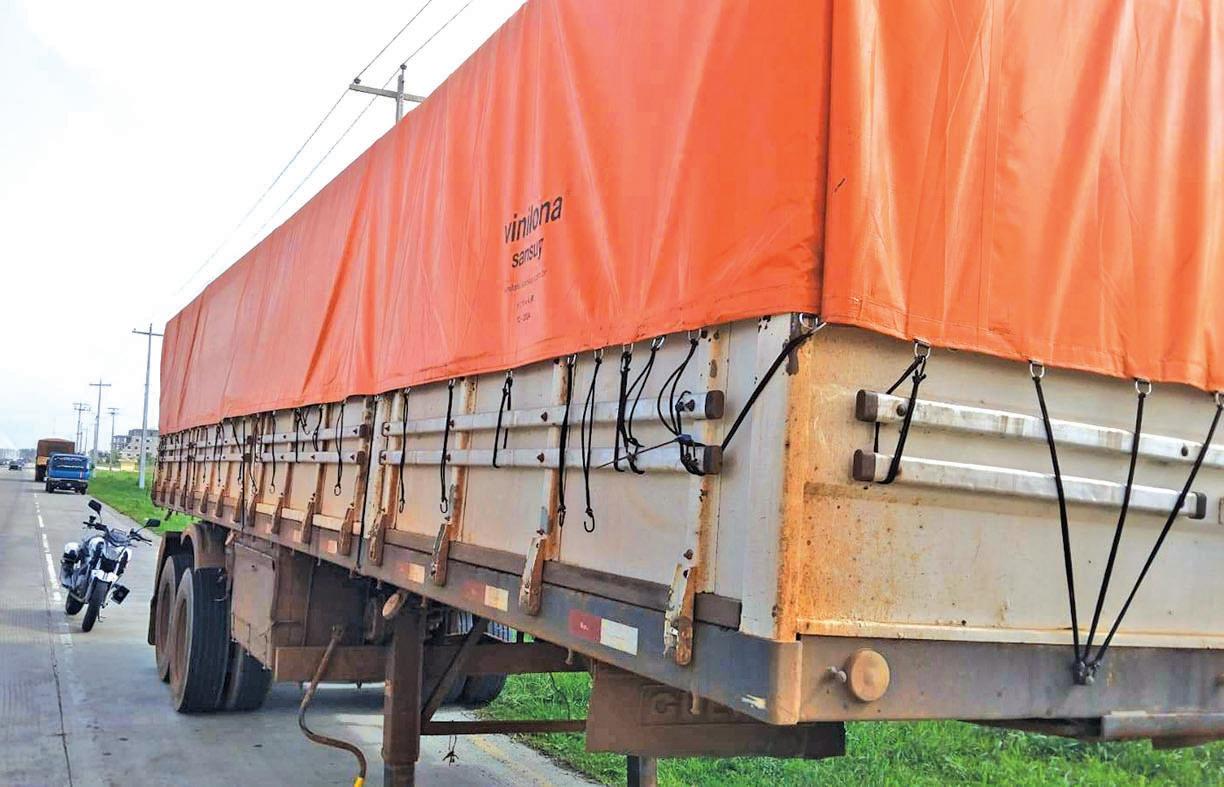
The Guyana Police Force (GPF) has intensified its efforts to address the ongoing issue of unlit, laden, and unregistered trailers parked along public road shoulders, particularly on the Mandela to Eccles Interlink in Georgetown.
This practice poses significant safety risks to mo -
torists, especially during nighttime.
Traffic ranks are actively identifying the owners and operators of these trailers to enforce appropriate actions.
The police have observed that both local and foreign operators are culpable, often leaving their trailers without proper lighting or
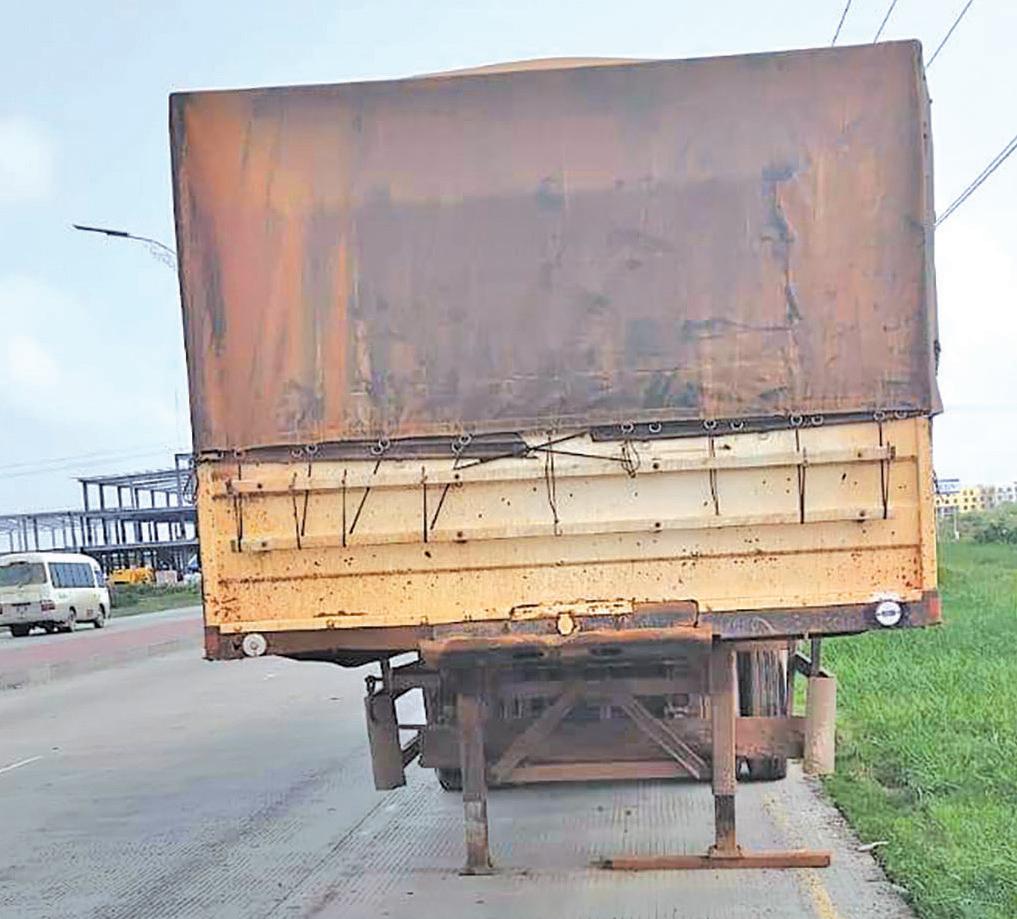
registration, thereby endangering road users.
This crackdown follows several incidents in 2024 involving parked vehicles leading to accidents.
Notably, in November 2024, a truck laden with sand toppled on the Mandela to Eccles Interlink, causing significant traffic delays.
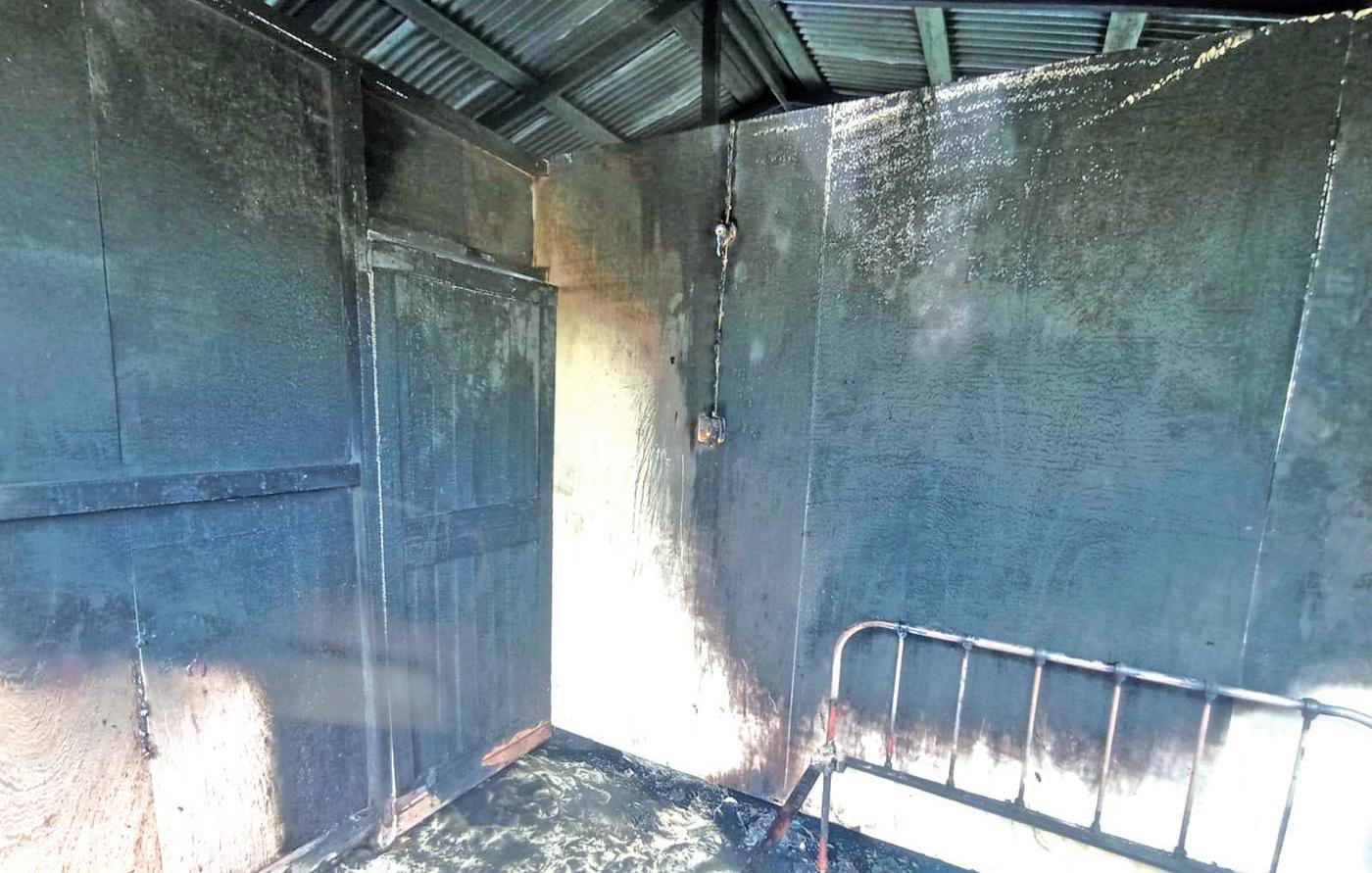
Two separate fire incidents in different parts of the country on Friday highlighted the importance of fire safety, as quick action by residents and passers-by helped prevent potential disasters.
Fire officials have since renewed their warnings about electrical hazards and kitchen-related fires, urging the public to take precautions to avoid similar incidents.
In Westbury Village, Jonestown, Essequibo Coast, a community effort saved the home of 71-yearold Selena Biedder, after a fire erupted due to a makeshift drop cord with a loose connection. The blaze ignited nearby combustible materials, putting the household at risk.
Firefighters responded to the call at approximately 13:26h, but by the time they arrived, public-spirited neighbours had already formed a bucket brigade and extinguished the flames.
However, the fire did cause damage to the northeastern walls of the home, along with several household items, including a wardrobe,

Earlier that year, concerns were raised about the dangers of parked and unlit vehicles on poorly lit roads, contributing to the rising number of road accidents and fatalities.
The GPF is urging all vehicle operators to adhere strictly to traffic regulations. They emphasise the importance of proper vehi -
cle lighting, valid registration, and the avoidance of parking on road shoulders to ensure the safety of all road users.
Motorists are encouraged to report any hazardous parking practices to local authorities. The police have reiterated their commitment to maintaining road safety and have
warned that violators will face stringent penalties. As part of broader efforts to enhance traffic management, the introduction of an electronic ticketing system for the Mandela to Eccles Highway is anticipated soon. This initiative aims to modernise traffic enforcement and reduce road infractions.
(GFS) have since urged residents to use proper electrical connections, and avoid makeshift drop cords, which can easily overheat and cause fires.
Authorities also reminded the public to refrain from overloading sockets and power strips – a common cause of household fires.
Later that evening, at approximately 20:33h, another fire scare occurred at Stall

two full-sized mattresses, and window curtains.
Biedder, along with several occupants—including Keisha Payne, 21, Eon Marks, 37, Kerry Biedder, 20, Seon Payne, 18, Jermaine Williams, 15, Annializa Marks, 8, Alisha Torrenton, 12, and Emily Torrenton, 16—escaped unharmed.
The Guyana Fire Service
22D, Stelling View, Stabroek Market, Georgetown.
That blaze was reportedly caused by a two-burner gas stove that had been left unattended with a pot on a burner.
The stall, owned by 74-year-old Michael Hughes of Lot 133 Friendship, East Coast Demerara (ECD), narrowly escaped damage
thanks to the quick response of nearby passers-by.
Witnesses managed to turn off the gas supply and remove the burning pot, tossing it through an open window before the flames could spread.
Fire officials are once again cautioning citizens about the dangers of leaving cooking appliances unattended, stressing that
gas stoves should always be monitored when in use. They also advised that gas cylinders be properly turned off after use to prevent potential explosions or fires.
With two fire-related incidents occurring on the same day—one caused by electrical hazards and the other by an unattended stove—the GFS is warning the public to be more vigilant. Authorities
emphasised that early intervention, such as those taken in Essequibo and Stabroek, can make the difference between a minor incident and a devastating blaze.
Citizens are urged to take fire safety seriously, ensuring that electrical wiring is secure, power sources are not overloaded, and kitchen appliances are never left unattended.


Justice has finally been served for Troy Ramalho, the cheese and sausage vendor who was brutally murdered at Bourda Market, Georgetown, in 2018. On Friday, a jury convicted Akeem Morris, known as “Dig Out,” and Roy Sandiford, of murder in furtherance of a robbery, delivering unanimous guilty verdicts after nearly five hours of deliberation.
The courtroom remained tense as the verdict was read, with family members of the slain vendor visibly emotional. The conviction marked the end of a trial that had seen intense arguments from both the prosecution and the defence, as well as shocking revelations

chest, causing him to collapse instantly.
As the vendor lay bleeding, Morris reportedly rushed over, removed the jewellery from his body, and

about the events of that fateful night.
On August 15, 2018, at approximately 23:05h, Ramalho had just finished his nightly business at Bourda Market when he was attacked. He had been wrapping up his sales for the night, dressed in his usual work attire, and wearing three gold rings, along with three chains wrapped around his arm.
According to eyewitness accounts and evidence presented during the trial, Sandiford, armed with a firearm, approached Ramalho’s stall and ordered him not to move. Without hesitation, he fired a single gunshot that struck Ramalho in the
quickly fled the scene along with Sandiford and their accomplice, Nya John. They disappeared into a waiting getaway car driven by George Paton, which had been strategically parked a short distance away.
A post-mortem examination conducted on Ramalho’s body two days later by forensic pathologist Dr Nehaul P. Singh, confirmed that Ramalho had died from haemorrhage and shock caused by a single gunshot wound to the chest.
The bullet had entered the left side of his chest, approximately eight centimetres (cm) from his armpit, before tearing through his left lung, and then passing


through his right lung. It eventually lodged between his second and third ribs, where investigators later recovered a metal object, believed to be the fatal bullet.
There was no evidence of close-range firing, as no gunpowder residue or soot was found on the body.
Following the murder, police launched an aggressive investigation, which quickly led them to the suspects.
Morris was the first to be arrested on August 26, 2018, and was later placed in an identification parade where an eyewitness positively identified him as one of the men involved in the robbery.
Sandiford was taken into custody a few days lat-
murder.
The attorney also pointed out that Morris had previously been arrested in February 2018 for another murder but was never charged, suggesting that he was being unfairly targeted.
Sandiford, represented by attorney Dexter Todd, also challenged the identification process and claimed he was being framed by an eyewitness due to a past conflict.
He further attempted to establish an alibi, presenting two witnesses who claimed he had been at a Superbet Shop in Albouystown, Georgetown when the murder occurred.
However, under cross-examination, the defence arguments appeared to crum-

er, on September 1, 2018, and was also identified in a police lineup.
During the trial, which began on January 22, 2025, the prosecution, led by State Counsel Christopher Belfield and Muntaz Ali, relied heavily on surveillance footage that captured Morris and Sandiford approaching Ramalho’s stall before the attack and running away moments later.
Witness testimonies also played a critical role in painting a clear picture of what had transpired that night.
The defence however, attempted to cast doubt on the prosecution’s case. Morris, through his attorney Kishwana Jefford, argued that the identification parade was unfair, and claimed Morris was home with his one-year-old daughter at the time of the
ble.
Sandiford’s supposed alibi witnesses struggled to recall key details and admitted that they had never provided this information to the police nor was it ever presented in the Magistrate’s court.
Their sudden appearance during the trial raised suspicions about the credibility of their statements. Furthermore, prosecutors highlighted that the police had initially received information from one of the accused, who had implicated both Morris and Sandiford in the robbery and murder.
After a gripping trial, the jury returned with unanimous guilty verdicts for both men.
They now await sentencing, which is scheduled for March 5, 2025, where they could face severe penalties under the law.

Well…this is it: Trump’s crossed the Rubicon!! Just like Caesar knew crossing the Rubicon River into Italy with his troops, was declaring war against the Roman Republic, Trump knows that keeping his promise and slapping a 25% tariff on goods from Mexico and Canada – it’s “war break”!! He also slapped a 10% tariff on Chinese goods – but everyone expected that, including the Chinese Commies!! He’d done so during his first term and even Sleepy Joe had selectively continued with that policy.
China’s the enemy trying to take on, take down and take out the USA, innit?? Even Mexico wasn’t totally unexpected – they’re coloured, right – like with dropping the first atomic bomb on Japan rather than Germany!! But Canada??!! Jeez…that’s like America stabbing its own kid brother – who’d only decided to live with Mommy England a bit longer than they had!! Run into a Canadian abroad and most folks can’t tell them apart from a Yank!! Remember that rescue of six Americans from Iran during the 1979 hostage crisis when they were passed off as Canadian citizens – dramatized in the movie Argo with Ben Affleck?? Anyhow, we now know that while some figured Trump was talking tough as a bargaining ploy, he wasn’t bluffing – as we’d seen on the deportation of “undocumented” foreigners!! This is Trump’s take on “How to win friends and influence enemies”!! It should be clear to all and sundry (especially the “sundry”!) that Trump feels America was –and is – being taken advantage of by its friends. And he’s gonna “put America first” – to Make America Great Again”!! While some may snicker at the seemingly simplistic policy formulations, they should make life easier for players in the international arena. They don’t have to think and double think – what they hear is what they’ll get from Trump!! But just as THEY’d promised, Mexico and Canada responded with retaliatory tariffs!! Game on!! WE now have a three-way Mexican Standoff between America and its two neighbours. We just gotta wait and see who’s gonna blink first! With reciprocal tariffs slapped in both directions, all three countries will now see prices escalating domestically on those goods affected – as importers and retailers pass on the tariffs as cost!! Each leader expects their citizens to tighten their belts – and open up their wallets – as inflation kicks in. The question is whether Trump’s expectation happens – that American businesses will step up to the plate and start producing the targeted goods domestically!!
He ain’t up for re-election – this is his last hurrah –unless he really believes he can reintroduce a third-term exception!! Meanwhile, Trump’s threat to Russia to end the Ukraine War; to BRICS to quit trying to replace the dollar; to purchase Denmark are next!!
…with PNC
Just when your Eyewitness thought it was safe to go back into the water, up comes Simona “Boom Out” Broomes announcing a new party to contest the upcoming elections – the “Assembly For Liberty and Prosperity (ALP)”!! We know there’ll never be too many dull days with Simona on the campaign trail!! Remember when she went berserk on the guard when her fried rice order was delayed by him at Amazonia Mall? Or when her driver Boogie Dex were arrested and placed in custody for the brutal beating they inflicted on two men??
Anyhow – even though she denied it when asked – this is definitely a move to cut down Aubrey Norton as head of the Opposition. Everyone and their uncle know that Broomes ain’t getting no Indian or Amerindian votes – even though she did help Mona when her 15 minutes of fame turned sour!! The question is, why split the PNC votes?? It’s just a stick to force Aubrey to allow another leader step in as leader!!
…on Essequibo Beauty Maduro ain’t letting up!! While everyone was looking at Trump’s representative Grenfell negotiating with him, he sent a Beauty Queen representing 'Guayana Esequiba' – which he said he’s annexed – in the Miss Reina Hispanoaméricana Pageant in Bolivia!!


Guyana’s rice sector has witnessed a remarkable recovery fuelled by a combination of strategic initiatives.
Rigorous efforts to expand export markets coupled with substantial financial support and timely relief measures have revived the industry as well as stimulated transformation across the value chain.
Minister of Agriculture
Zulfikar Mustapha has once again emphasised the Government’s continuous drive to reverse the damage inflicted on the sector from 2015 to 2020.
He called out the opposition’s hypocrisy in declar-
ing support for the rice industry when this very sector was denied critical support during its tenure and described as ‘private business.’
During an interview with the Department of Public Information (DPI) on Sunday, the Minister said the A Partnership for National Unity + Alliance For Change (APNU+AFC) Coalition promised a series of measures in its 2015 manifesto, all of which resulted in failure.
He said the previous Government failed to demonstrate to the people of the country the duties of an effective Government. This is evident in the lack of in-
vestment in seed paddy production and the promise to restructure the Guyana Rice Development Board (GRDB) that never materialised.
“No effort was made to recoup outstanding payment for rice sold to Panama. After six years, the Panamanian debt was paid amounting to GYD $1.5 billion. This resulted in the closure of seven rice mills. They said they would pay special attention to increasing yields, but they stopped farmers’ field day and abandoned the Paddy Bug Management Programme,” he said.
Additionally, the coalition Government added taxes to crucial inputs, placing
The Committee of Supply on Friday approved $679 million to support the operations of the Board of Industrial Training (BIT), as part of the $1.6 billion allocated to the Ministry of Labour to strengthen the workforce while ensuring safety and stable industrial relations.
This funding will enhance comprehensive training programmes, helping to bridge critical labour gaps in key economic sector, a Department Public Information (DPI) news report stated.
Approximately 2,397 persons will receive extensive training in 177 lucrative and technical fields, significantly bolstering the operating capacity of Guyana’s labour force.
In every region, millions of dollars have been earmarked to train scores of people, preparing many for success in Guyana’s dynamic job market.
According to the DPI, with these allocations, the Ministry of Labour is now poised to embark on the important endeavour of transforming lives and sustaining Guyana’s dynamic job market.
Minister of Labour Joseph Hamilton speaking at the ongoing Budget Debates at Parliament, this initiative is only one of the several ambitious training efforts undertaken by his Ministry.
The Ministry continues to actively engage international and local agencies to source funding for other groundbreaking training opportunities.
Minister Hamilton told the house “Additional to what BIT will be doing is several collaborations that are happening with other agencies, whether Government or international agencies.”
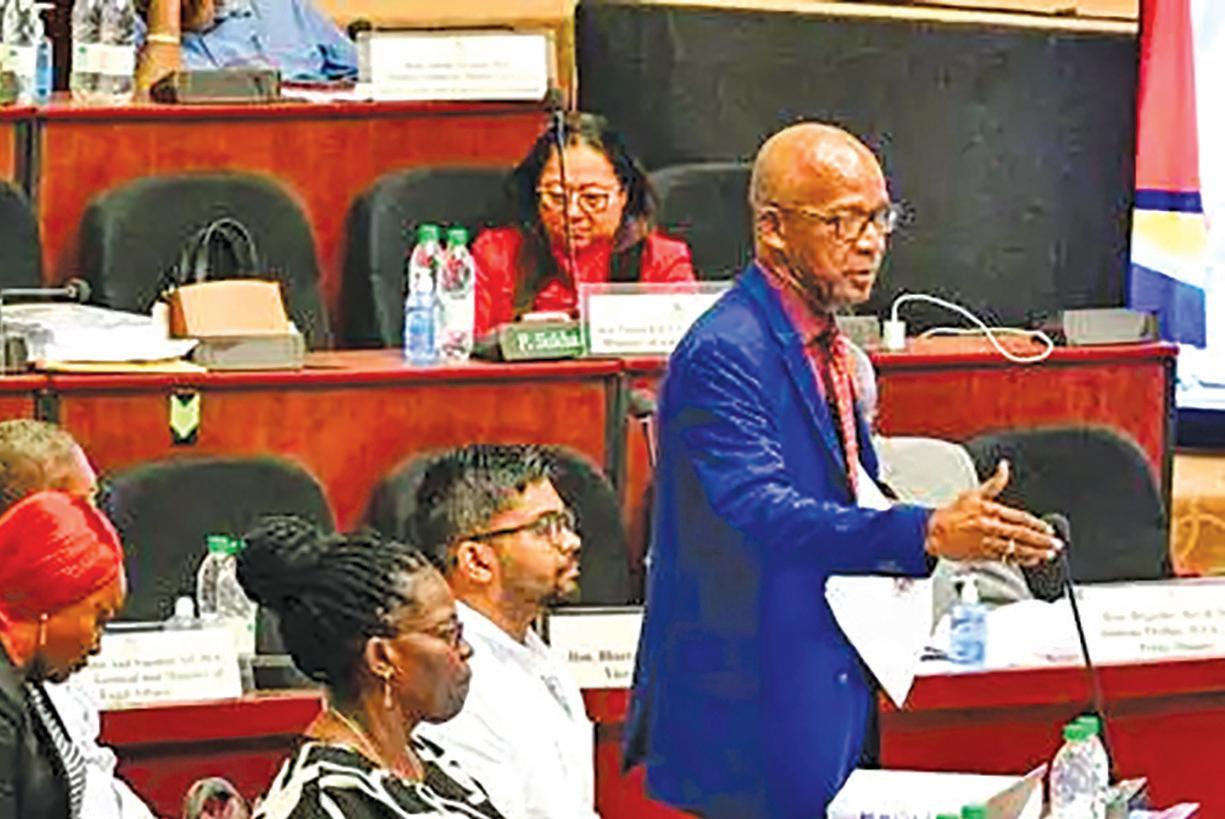
Recently, the Ministry inked an agreement with the World Bank to supply funding to train 20 women, two from each administrative region, in solar photovoltaic (PV) at the highest level.
Further, 1,200 Guyanese will be trained to work in one of Guyana’s largest gold mines, located in Region Seven.
While inputting their concerns, the opposition questioned the Minister about the Ministry’s ability to effectively garner information on the country’s labour needs.
In response, the
Minister assured that the Government is not “sitting on their hands” but actively collaborating with businesses and industries to identify workforce needs and curate suitable interventions.
He said, “We have several areas where data is there that we are utilising to do the work and to plan as regards to what training to do at BIT,” eh explained.
Efforts are also on the ground to establish a statistical department in the Ministry, with facilities already in place to accommodate the department.

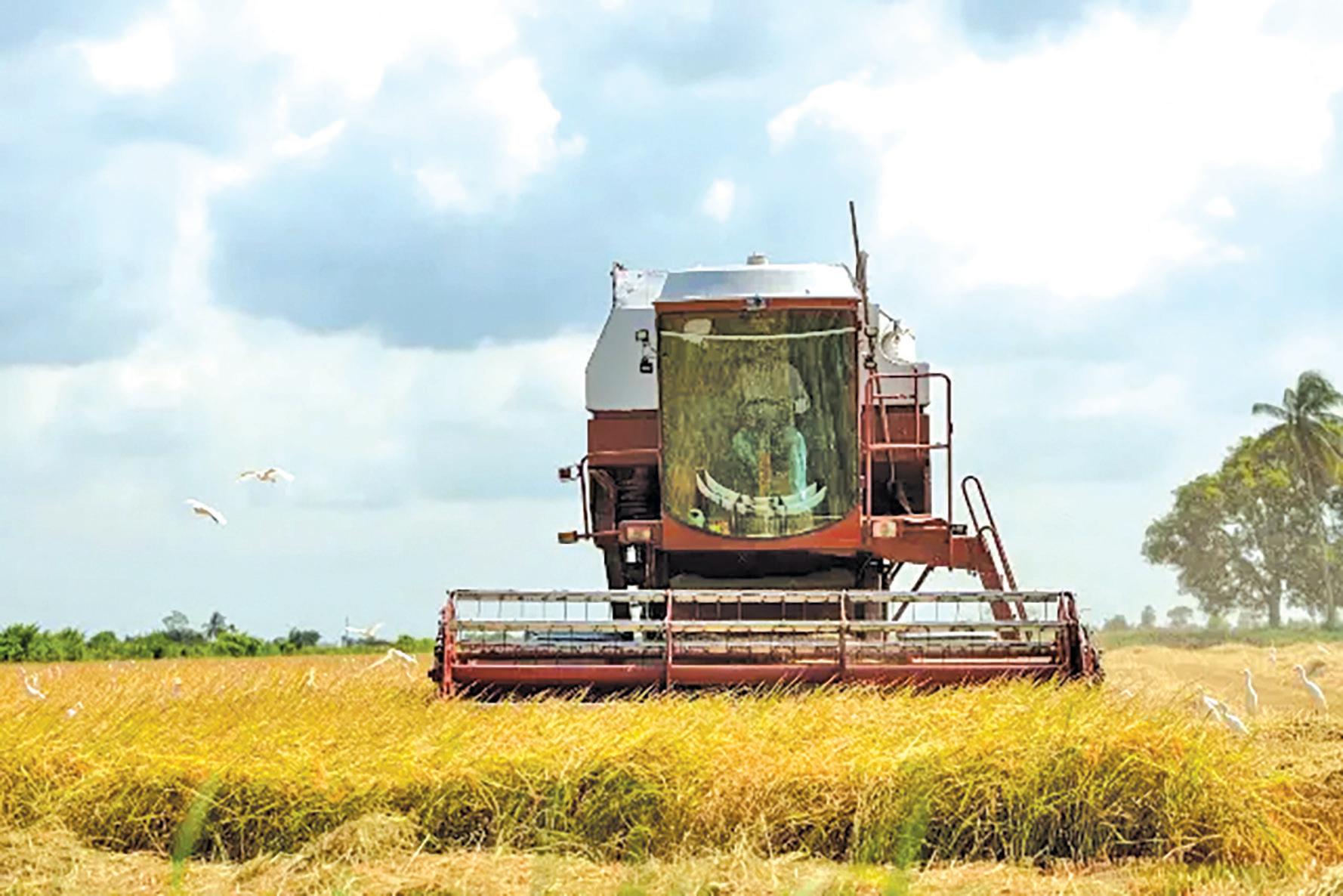
significant financial burdens on farmers.
“The PetroCarbie rice deal with Venezuela collapsed under the APNU administration – after nine years, the PPP/C Government paid 27 farmers and five millers $437 million in outstanding payments in 2024,” the Minister disclosed.
In addition to the removal of value added tax (VAT) on machinery, agrochemicals, fertilisers and pesticides, the Government has allocated over $1.8 billion to farmers from 2022 to 2024. Another $2 billion will be distributed to these farmers as fertiliser subsidy this year.
“We have also reduced
the commission paid to GRDB by exporters from US$8 to US$6 per metric tonne, effective April 1 2022, and sales commission was removed for the first crop of 2023. This allowed farmers to benefit from higher prices of paddy: $4,500 per bag,” Minister Mustapha added.
New markets were also accessed in Latvia, Hungary, British Virgin Islands, Slovenia, Estonia, Lebanon, Angola and Sierra Leone.
Guyana produced a record-breaking 725,282 tonnes of rice in 2024, largely due to the introduction of new rice varieties over the past four years.
This builds on the successes of the last four years.
In 2021, Guyana produced a total of 569,789 tonnes of rice.
The amount increased in 2022 to 610,595 tonnes and in 2023, 653,706 tonnes of rice was harvested.
This uphill trend is expected to continue in 2025 with a production projection of 804,000 tonnes or a 12.4 per cent increase.
The $430.9 million allocation for rice in 2025 will see the expansion of storage capacity at the Number 56 Seed Facility.
This investment will also see the introduction of specialised broadcast equipment, promoting precision agriculture and improving crop management efficiency.


Last year, some $45 million was spent by the Government of Guyana to remove derelict vehicles from the roadways, and this year, the Government will be continuing its crack down on a number of road management issues such as derelict vehicles and trucks that are parked in a way that encumbers traffic.
This was explained by Minister of Public Works Juan Edghill, during the examination of the budget estimates, where he noted that these derelict vehicles, once removed will likely be processed and sold for scrap metal. He also made it clear that if persons return more derelict vehicles to spots that have already been cleared by the Government, they will be charged.
Minister Edghill gave as an example a businessman who has been dumping vehicles on the Kitty, Georgetown, Railway Line, in the vicinity of the Alliance For Change (AFC) headquarters.
According to the Minister, action was taken in collaboration with the Guyana Police Force (GPF) just last week.
“Notice was served to that gentleman last week Thursday afternoon. We have removed derelicts from there and it has returned. And in the presence of the
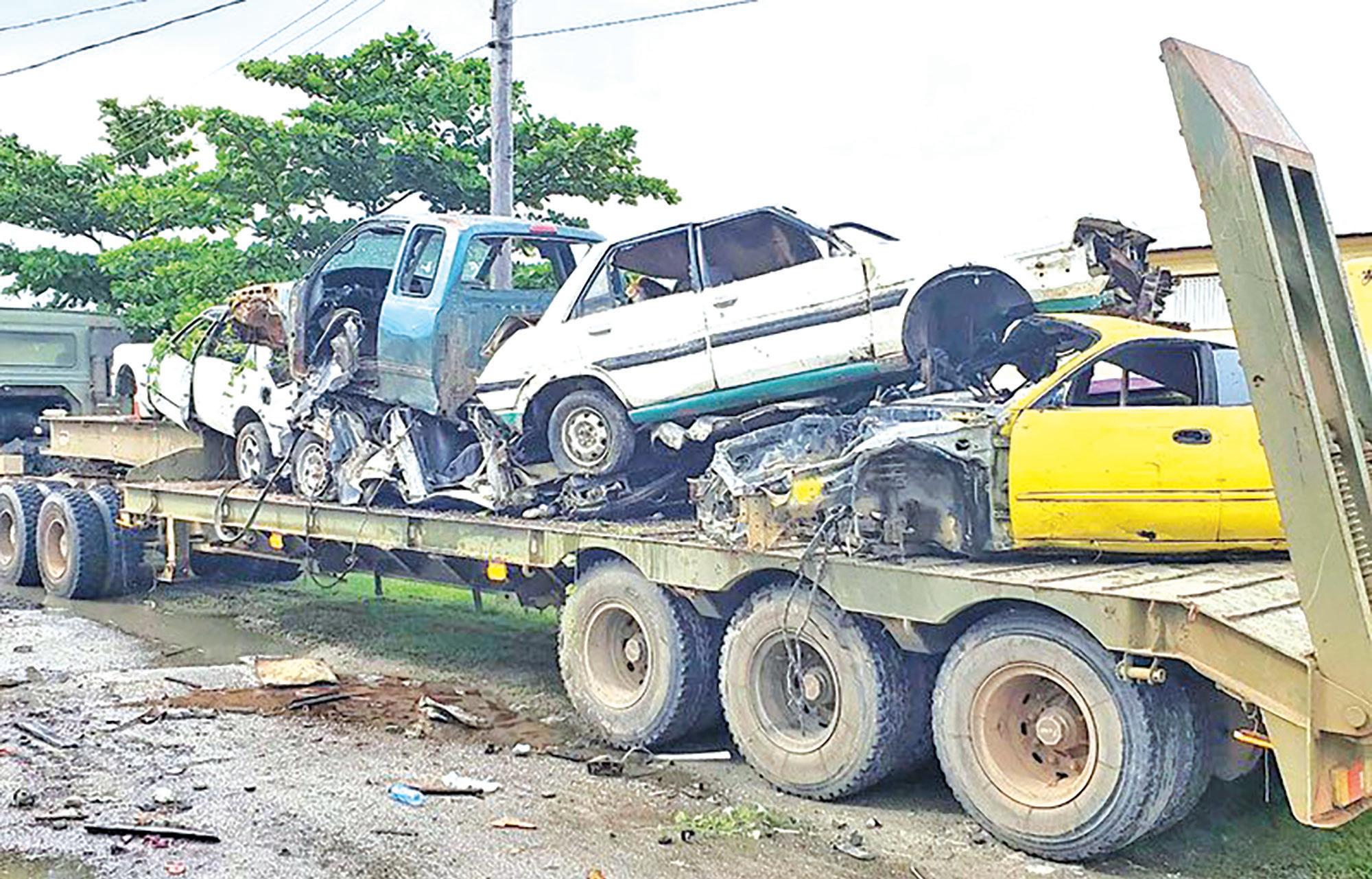
Commander of the Division, we said to him, if you bring back derelicts – and this goes for everyone – you will be charged and placed before the court.”
“We would have spent about $45 million last year moving derelicts in Region Six, Five, Four, Three, Two; on the Linden/Soesdyke Highway. And we have to get this under control. We don’t want to take bread out of people’s mouth, but certainly, safety,” Edghill explained.
Another issue, according to the Minister, is that the Ministry has had to move sand from the East Bank of
alleges
Demerara (EBD) thoroughfare. And just like heaps of sand presents a road hazard to commuters, so too are trucks parked on the roadway.
“It is important to note, to assist the police, just the other day we handed over to them 50-wheel clamps for cars. And we are procuring 200 clamps for trucks. And that is for a particular reason,” Edghill said.
“Once you make them immobile and shut them down and leave them for a while, when people’s pockets start being affected, they come into compliance. And there will be tough mea-
sures. That is why we have the policy paper, at the cabinet subcommittee, which we will be discussing.”
Edghill emphasised that this toughening of measures is not meant to target anyone, but rather to return the country to a “place of decency, where we could operate in a safe manner”.
The matter of mechanics who leave their customers’ derelict vehicles on streets within communities for months on end was also raised in the National Assembly by Member of Parliament Jermaine Figueira.
Edghill acknowledged
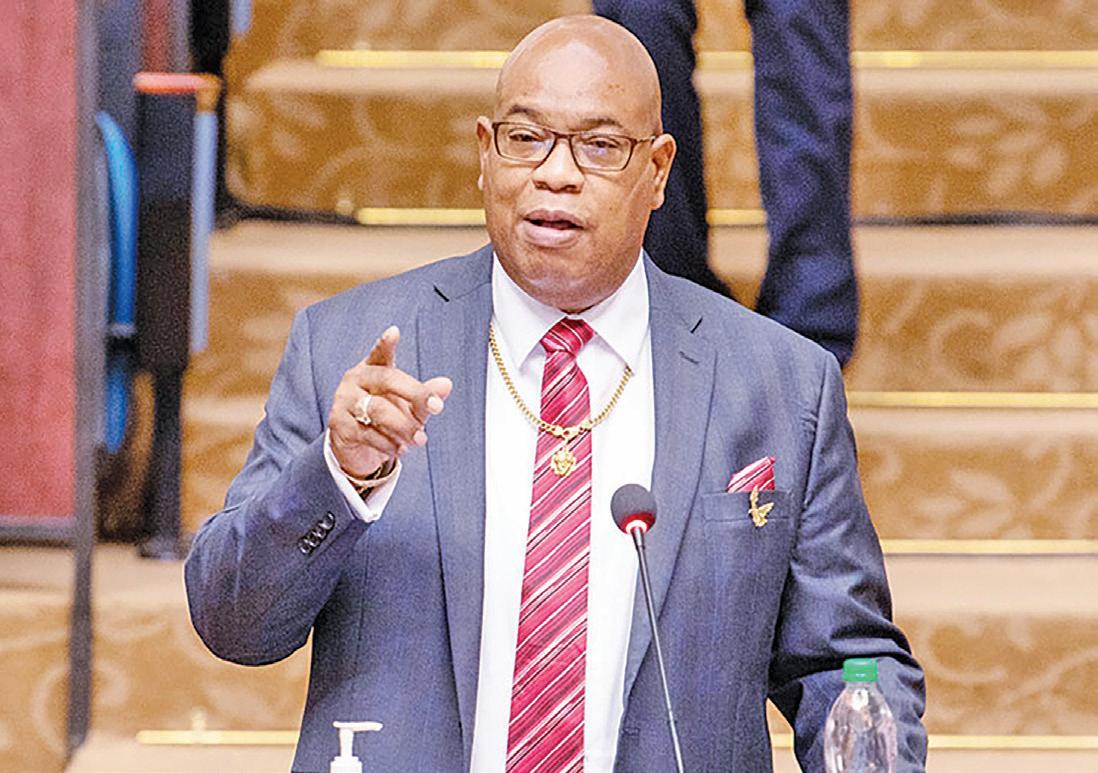
this issue and noted that while it falls under the purview of the relevant Neighbourhood Democratic Council (NDC), central Government has been providing them with assistance to move these vehicles.
“The responsibilities of those inner streets are the responsibility of the municipalities and NDC’s. They have said to us that they don’t have the resources, the two trucks and so on. And what we’ve been doing, is getting them to serve the notice in keeping with the law and when it’s not complied with, then we go in and help,” Edghill said.
“This is also a good time to make a call. Because I get letters from NDC’s, as well as citizens, of people in communities they’re upset with that they can’t pass (on the
road). And often times, you try to get community engagements because a person working, living in a community and you’re obstructing the flow of your own neighbours. At some point you have to listen to your neighbours,” he advised.
The Minister recalled a time when they had to beg a resident on the East Coast of Demerara (ECD) to move a 40-foot container from the road. But with their pleas falling on deaf ears, it was the Government itself that had to move the container.
Meanwhile, Edghill also said that discussions are ongoing on where they will be mounting traffic lights along roads such as the Heroes Highway and budgetary allocations have been made for this.
– despite legal action taken against him for offences
Twenty-eight year-old Denise Alexis has once again expressed her frustration after her ex- boyfriend, 32-year-old- Jeremy Gordon Smith, allegedly continues to harass and threaten her, months after he was charged with two offences of publishing obscene videos of her in July last year.
Despite legal action being taking against him, the 28-year-old woman in a recent interview with Guyana Times, alleged that Smith continues to harass and threaten her.
According to the victim, Smith has been continuously sharing explicit pictures of her via a popular social media platform. She also revealed that he disclosed her address and personal documents as well.
“And to date, when I say to date, I literally mean to date, he is still posting... so the photos and videos that he would have got from my phone he’s posting them... and putting my number and telling men to contact me via WhatsApp, $15,000. So, I’m doing sexual favours for $15,000; he’s putting my address in there; he even dropped my location,” she
claimed.
The woman added. “Two weeks ago, he would have posted... I don’t know how this boy got my ID card, my driver’s licence, my passport. So probably sometime during the relationship, when I used to stay there, he went into my bag and took out pictures of my documents,” she alleged.
Alexis claimed that despite enforcing a restraining order against Smith, he continues to send her threats via multiple phone numbers.
“He’s threatening me by different numbers. Mind you, I have a restraining order against him. He’s not supposed to be making any form of contact with me not supposed to be posting anything about me directly or indirectly,” she said. According to her, currently they’re multiple cases against Smith in the Magistrate’s courts.
These continuous acts of harassment Alexis said she believes is to intimidate her from proceeding with her cases against Smith. However, the 28-year-old told this publication that she will not stand down until he is held accountable by the
law for his actions.
“He’s trying to intimidate me, him and his mother especially. They want me to drop the matter that I have against him, but I’m adamant when it comes to that I’m not the first, second or third woman he has done this to but I have to be the last he hast to go down,” she alleged.
Alexis told this publication that she decided to part ways with Smith due to his verbal and physical abuse towards her.
Jeremy Smith, a 33-yearold technician who was in the news last year after his ex-girlfriend accused him of posting her nudes and damaging her property, has been slapped with two charges and released on bail.
Smith of Lot 139 Meadow Brook Gardens, Georgetown, was brought before Magistrate Clive Nurse in the Georgetown Magistrates’ Court. The first charge alleged that between March 11 and May 6, 2023, at Meadow Brook Gardens, Smith intentionally and without a lawful excuse, acquired electronic data, being videos and photos, from Denise Alexis’ WhatsApp
messages.
It was further alleged that Smith, between May 27 and July 16, 2024, at the same location, used a computer system to publish electronic data of his ex-girlfriend that was obscene, vulgar, profane, rude, or indecent and caused emotional distress to Alexis. The prosecution did not object to bail. As such, Smith was placed on $150,000 bail.
Meanwhile, just last week Smith’s mother Ann Smith, a 67-year-old woman from Meadowbrook, Georgetown was found guilty of attempting to obstruct the course of justice and was fined $100,000 by Magistrate Annette Singh at the Georgetown Magistrate’s Court on Friday.
Smith was convicted of the offence after being accused of attempting to hide her son, Jeremy Smith, from police who were seeking to arrest him in connection with a serious criminal matter.
The charge stems from an incident on July 8, 2024, at Lot 139 Silverballi Road, Meadowbrook, where Smith allegedly interfered with police officers’ efforts to ar-

Jeremy Gordon Smith
rest her son, who was facing charges related to the publication of obscene photographs and videos of his ex-girlfriend.
The case had garnered public attention following Jeremy Smith’s arrest, and Ann Smith’s actions were seen as an attempt to prevent the law from taking its course.
During her court appearance in August 2024, Smith pleaded not guilty to the charge of attempting to obstruct justice.
In the courtroom, the prosecution did not object to granting her bail, but a request was made for the Magistrate to ensure that she surrendered her pass-
port and reported to the Criminal Investigation Department (CID) twice a month.
Smith’s attorney, Eusi Anderson, made the case that his client needed her passport for medical reasons, specifically to seek treatment in the United States (US).
The court agreed to allow her to retain her passport but ordered her to report to the CID as a condition of her release.
Following her conviction on January 24, 2025, Smith was fined $100,000 for her attempt to obstruct justice. In the event of non-payment, she faces a sentence of six months in prison.


Men on Mission (MoM) on Sunday donated a new house to a Berbice single mother, Yamanie Bepot.
For more than 13 years, Bepot – a single mother of three, had been living in dilapidated zinc shack, with leaks in the roof and walls, at Ordnance Fortlands, East Canje, Region Six, (East Berbice-Corentyne).
It was a house where rainwater seeped in, leaving puddles on the floor which encouraged visitors including snakes.
The keys to her new home were handed over on Sunday by Agriculture
Minister Zulfikar Mustapha, a resident of Region Six, on behalf of President Dr Irfaan Ali. The Minister noted that there are many corporate sponsors working with MoM.
“This is just another example where the Government is looking at ways to assist people who are living in vulnerable situations. The Government does have a robust housing programme. Over 35,000 house lots have already been distributed for the last four years. This is another programme to assist vulnerable people in the community,” Mustapha said.
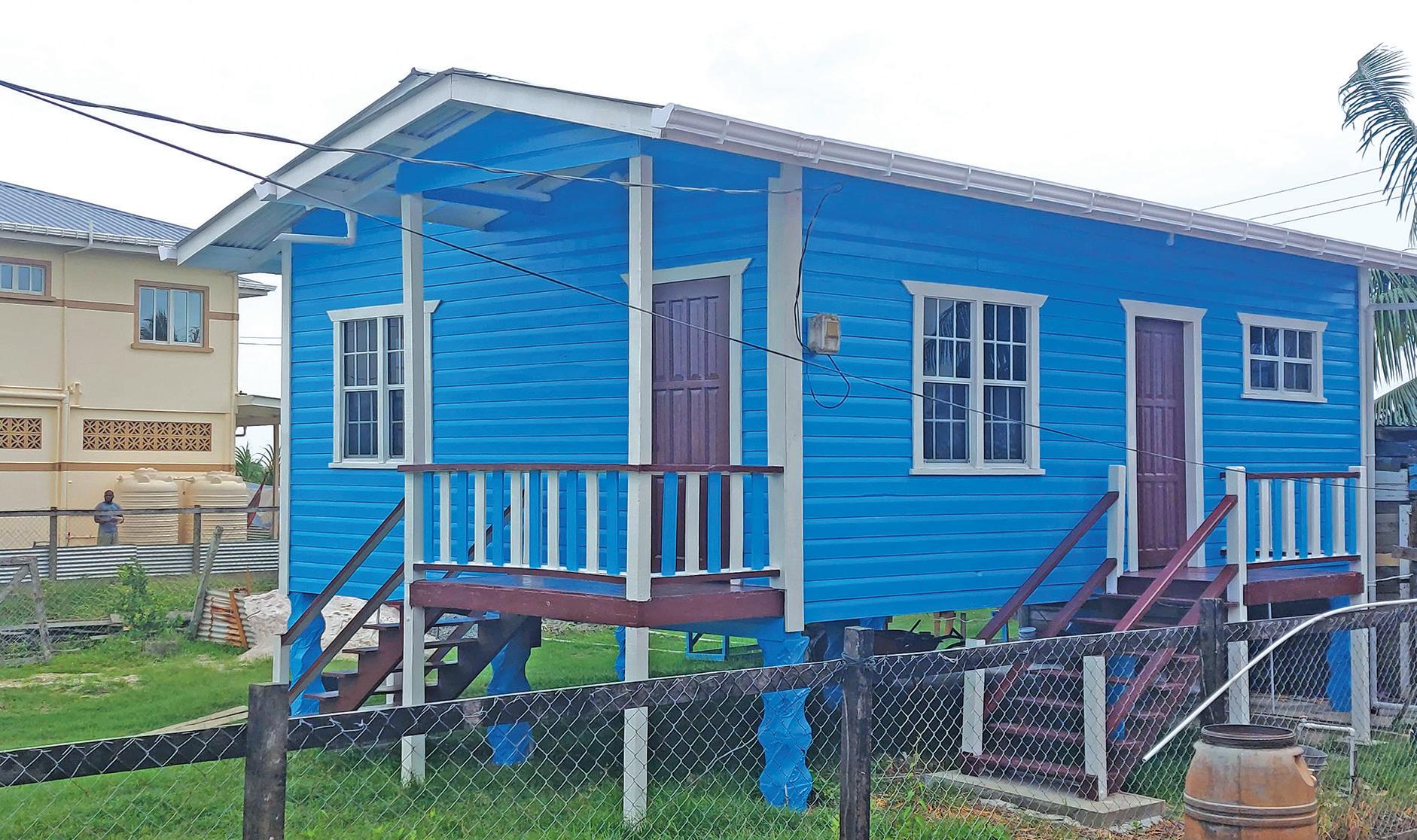
Mustapha applauded the two companies that partnered to construct the home, SAWA Investments and GAICO, noting that the Government has been partnering with private sector to assist communities and individuals.
In late December, Bepot’s living situation was made public through the media, and MoM intervened through Samantha Reid of SAWA and Komal Singh of GAICO.
Bepot and her husband rented a house and were living there. However, when she became pregnant with her third child, the couple
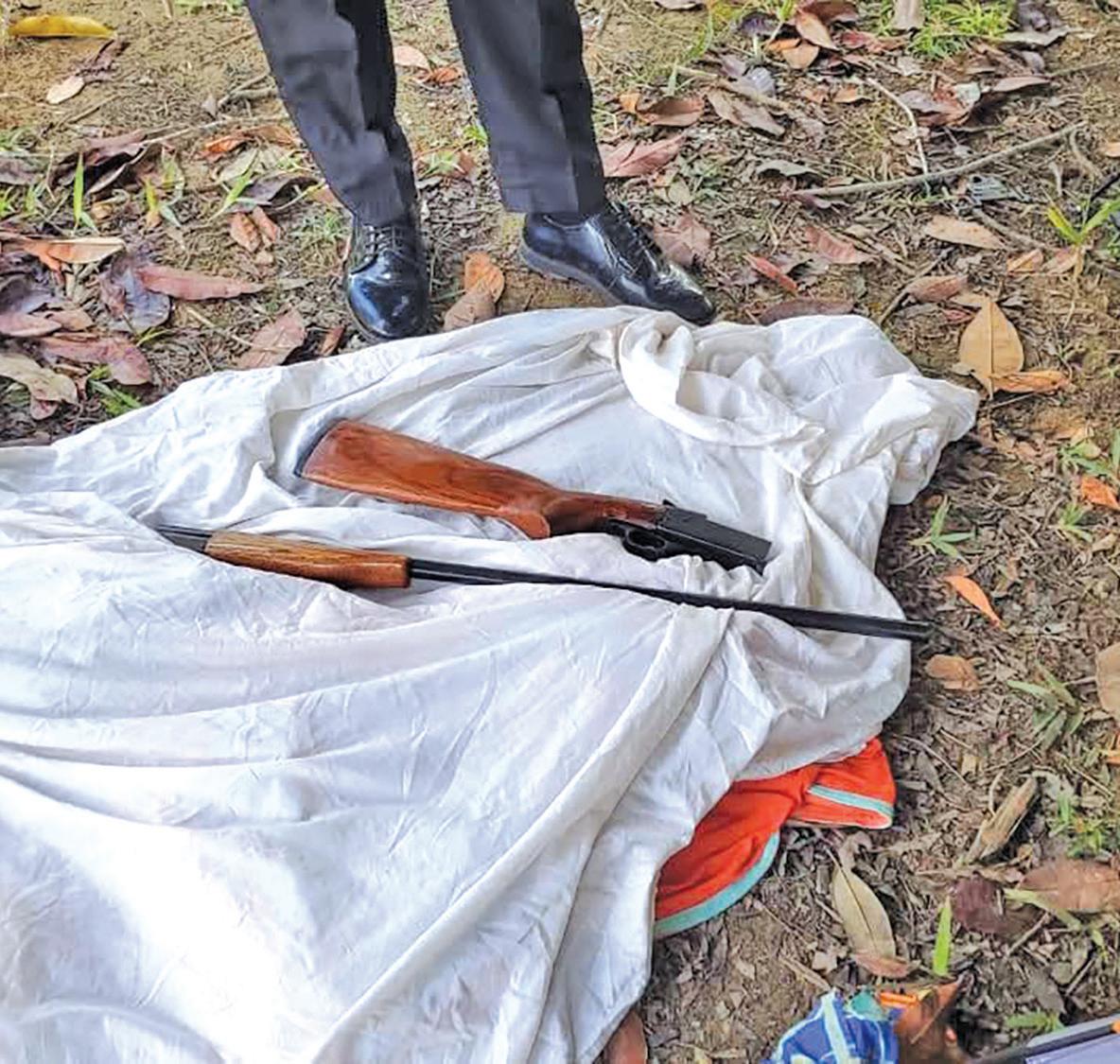
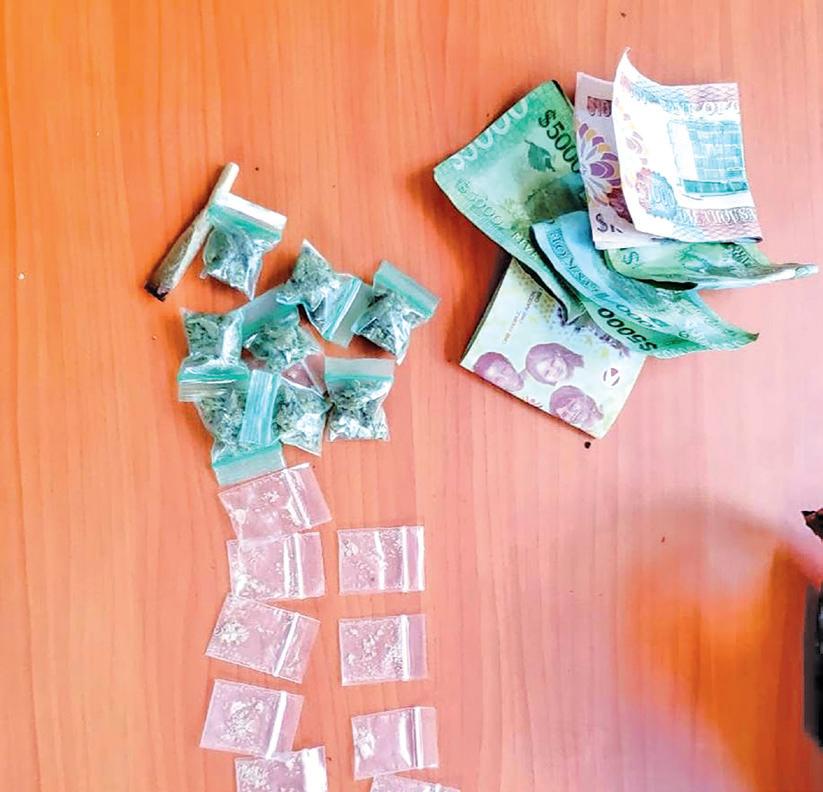
Police in Regional Division #7 conducted mobile patrols over the weekend between Kamarang Landing and Waramadong Village, where a quantity of narcotics and a shotgun were found in the two areas.
According to the police, on Saturday, February 1, during one the mobile patrols, the police team observed Rodinson George behaving suspiciously in Waramadong Village.
A search was subsequently conducted on George, during which several transparent zip-lock bags containing leaves, seeds, and stems suspected to be cannabis (totalling
8 grams) and methamphetamine (totalling 1.7 grams) were found in the pocket of his pants.
George was informed of the offence, cautioned, arrested and escorted to Kamarang Police Station for further processing.
Then about 11:00 h Sunday, February 2 the same police patrol team was on mobile patrol at Kamarang Landing when it received information, leading them to a small, tarpaulin camp near the Kamarang riverside.
Police entered the camp and discovered a long object wrapped in a white sheet under the bed.
The sole occupant, Maxcylen Conrado, claimed the object belonged to her husband, Ramesh Issacs.
Police unwrapped the object and found it to be a 20-gauge single-barrel shotgun with no serial number seen.
Maxcylen was questioned about a firearm licence, and she stated that her husband, Ramesh, owned the firearm.
Ramesh Issacs was contacted and admitted he did not possess a firearm licence.
He was cautioned, arrested, and escorted to Kamarang Police Station and placed into custody.
Investigations are ongoing.
decided that they wanted their own home.
They approached her husband’s uncle who gave them the land and they built the zinc shack to live.
However, before the paper work for the real estate could be done, the uncle passed away and tragically, just a short while after Bepot’s husband fell ill and subsequently passed away, leaving her with three children and no rights to the land she was living on.
However, after her sto-
ry was made public, the Government intervened, and through MoM she now owns the land on which her new home was built.
Mustapha while noting that the new building will provide some amount of comfort for Bepot and her children, committed the donours to assist with providing some furnishing.
Managing Director of SAWA, Samantha Reid, said she was honoured to be able to support the MoM inattentive, noting that this is the
second such project she has undertaken with the first being in Linden, Region Ten (Upper Demerara-Berbice).
“My team worked for two weeks to build this house and it was well built and should be well received,” she said, while thanking GAICO for coming onboard with her company. MoM is the brain child of President Dr Irfaan Ali with the aim of improving the lives of single parents, pensioners, persons with disabilities victims of disasters.


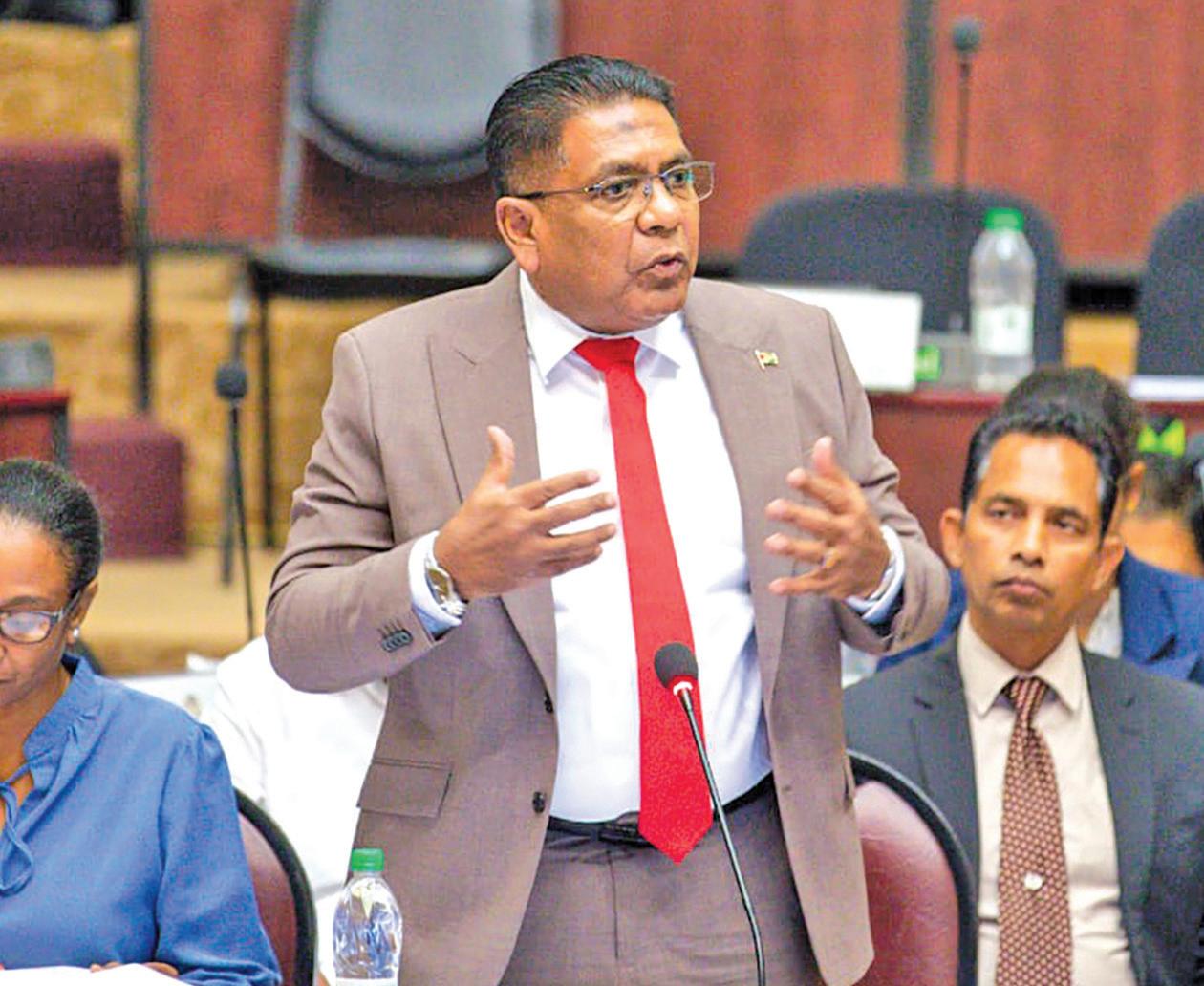
Agriculture Minister Zulfikar Mustapha is confident that the Guyana Sugar Corporation (GuySuCo) will not only achieve its target set for 2025 but also reduce its high cost of production.
The Minister was at the time responding to questions from the Parliamentary Opposition during the Consideration of the Budget Estimates for his Ministry on Friday.
Shadow Agriculture Minister, Vinceroy Jordan, pointed out the state-owned sugar corporation lost almost $30 billion since 2020 and asked how they intended to fix this.
In response, Mustapha reminded of the state of the sugar industry when the People’s Progressive Party/ Civic (PPP/C) took office in August 2020. Between 2016 and 2017, the A Partnership for National Unity/Alliance For Change (APNU/AFC) Administration downsized GuySuCo and closed several estates across Guyana – an action that displaced more than 7,000 sugar workers.
“The industry was in a
state where we had to spend a lot of funds to bring it back to where it is now. Places like Rose Hall, the cultivation was like a forest and we had to clear it up and replant the entire cultivation. Uitvlugt Estate was left at the mercy of nature and probably by the grace of God, it functioned. Albion, the entire system at Albion we have to continue fix it,” he recalled.
Nevertheless, the Agriculture Minister assured that efforts are being undertaken to reduce the cost of sugar production.
“So, we are working to ensure that we have maximum capacity at these estates so that they can crush the canes. We are having better canes now; we are planting back new canes and better varieties of canes. So, we are working very aggressively to reduce that cost of production. So, the losses that the Honourable Member would have alluded to, that would be reduced tremendously. And also, we must look back at not only the destruction that was done to GuySuCo but also the cost [incurred]
in 2021 when almost the entire cultivation was destroyed by floods,” he stated.
Currently, sugar is being produced at US$1.131 per pound and is sold at US$0.171 (17 cents) per pound.
“We are working to reduce tremendously the cost of production. Apparently, GuySuCo has been advised that they are looking at 51 cents reduction this year... As long as we produce more sugar, and sugar is not a thing where if we produce more you pay more. If you produce sugar more, the cost of production will be reduced,” the Minister noted.
The sugar sector contracted by 21.8 per cent in 2024 with GuySuCo producing 47,103 tonnes from the 63,276-tonne target. The low production was as a result of the impact of El Niño, compounded by labour shortages across the industry throughout last year.
However, the sugar industry is poised to turn around this year with an ambitious target of 101,000 tonnes is set for 2025.
When questioned about the plan to achieve this target, Mustapha pointed out that 40 per cent of GuySuCo’s operation is mechanised, and they have worked to enhance yields from the sugar canes.
“So, we’re taking less canes to make the amount of sugar. GuySuCo indicated to me that with the amount of canes that they have and with the factories now being rehabilitated that they will make the sugar [target] of 101,000 tonnes,” he added.
He credited the contributions of the technical experts from Cuba and India
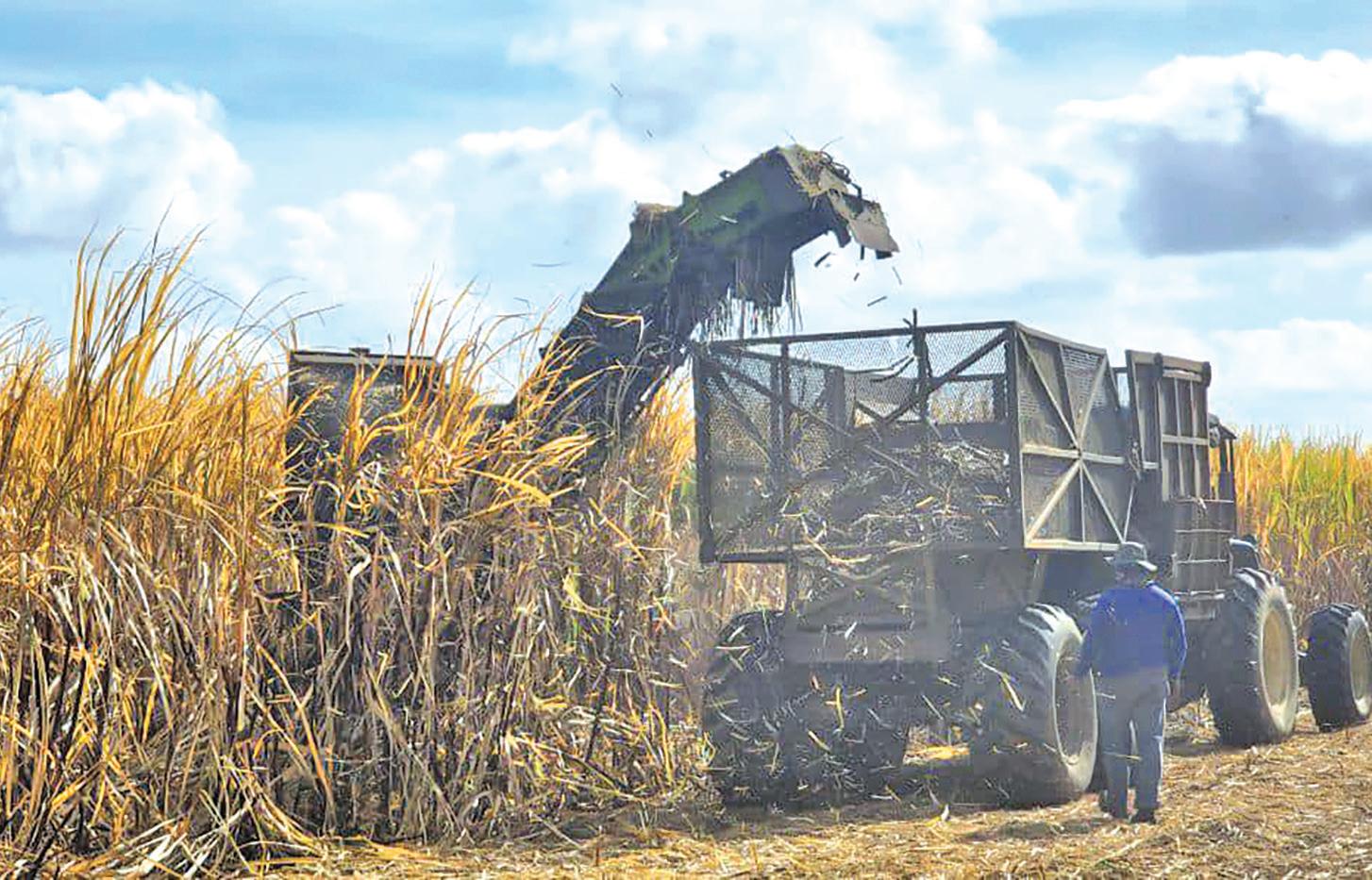
who were brought here last year to support GuySuCo’s revitalisation efforts, focusing on areas such as field management, agro-management and crop management.
“The technical persons that came from Cuba and India are making a valuable impact and working along very closely with the local people… They bring good expertise to use and we are very optimistic that with the kind of expertise that they have and with our people, we will turn around GuySuCo,” the Minister added.
The Agriculture Minister went on to disclose to the Committee of Supply in the National Assembly on Friday that GuySuCo is spending approximately $150 million annually for the technical experts – 11 from Cuba and seven from India.
“So, I am not too bothered when people who are not performing, and they were relieved of their duty; making all kinds of remarks.
So, I want to say… already, 40 per cent of the cultivation has been mechanised. These people are also helping us with the factories,” he stressed.
Mustapha was referring to recent comments made by a former Technical Director of Operations at GuySuCo, who criticised the hiring of these experts, saying the Cubans have not made any tangible contributions –something which GuySuCo has already dismissed.
Last year, some $15.5 billion was expended on support to the sugar industry, including the acquisition of six new cane harvesters; conversion of 2,734 hectares of land for mechanised cultivation and harvesting, and rehabilitated critical revetment works.
In 2025, an additional 3,068 hectares of land will be converted to support mechanisation. Key investments will be made to acquire additional field equipment, rehabilitate field infrastructure,
and construct over 17 kilometres of all-weather roads across the industry.
For these efforts, some $13.3 billion was approved on Friday – as part of the Agriculture Ministry’s $104.6 billion budget – to support and rehabilitate the sugar industry this year.
Earlier this month, Minister Mustapha said estate managers have already been warned to cease their “boss-boy attitudes” and work closely with the workers in order to boost morale.
“I know there are still problems there, and I instructed GuySuCo that they must work very closely with the workers, so they can build their morale. We must not have this kind of ‘boss boy’ attitude on the estates. I told them this already. I myself will be visiting some of the estates and see what is going on, without announcing I’m going in there,” the Agriculture Minister had noted.
A35-year-old weeder, Orlando James, of Lot 31 Bent Street, Werk-En-Rust, Georgetown, walked free from the Georgetown Magistrates’ Court last week after he compensated the rightful owner of a stolen motorcycle.
James, a single father of four, appeared before Acting Chief Magistrate Faith McGusty, unrepresented by legal counsel, to answer to a charge of simple larceny.
The prosecution alleged that between May 15 and May 16, 2024, he stole a motorcycle valued at $175,000, the property of Shai Stephens from Robb Street, Georgetown.
James, however, pleaded not guilty, maintaining that

he had purchased the motorcycle without knowing it was stolen.
The prosecution while objecting to bail, outlined that Stevens had reported his bike missing and later received information that it was spotted at a location on Camp Street. Upon arriving there, Stephens saw James driving the bike toward a wash bay. Recognising his property by its identification number, he immediately contacted the police.
Officers arrived at the scene and arrested James, who initially told them that he had purchased the bike from a child but had no knowledge of the child’s whereabouts.
However, when given the chance to speak in court,
he changed his story, stating that he had bought the bike from a man who originally asked for $60,000, but he only had $40,000. The man, he claimed, accepted the lower amount and sold him the motorcycle.
During the proceedings, Stephen informed the Magistrate that while he was able to recover the bike, it was no longer in good condition. The brakes were damaged, and it was not functioning properly.
He estimated that repairs would cost around $40,000 and indicated that he was open to receiving compensation for the damages rather than pursuing further legal action.
James’ family members, who were present in
court, quickly provided the $40,000 in cash to Stevens. Their actions led the Magistrate to address James directly, warning him about the dangers of purchasing vehicles or any high-value items without proper documentation. She emphasised the importance of obtaining receipts and verifying ownership to avoid similar legal troubles in the future.
Acknowledging his mistake, James apologised to Stephen, stating that he had simply seen the bike and purchased it without thinking twice. After the restitution was made, the Magistrate dismissed the case, allowing James to leave without further consequences.

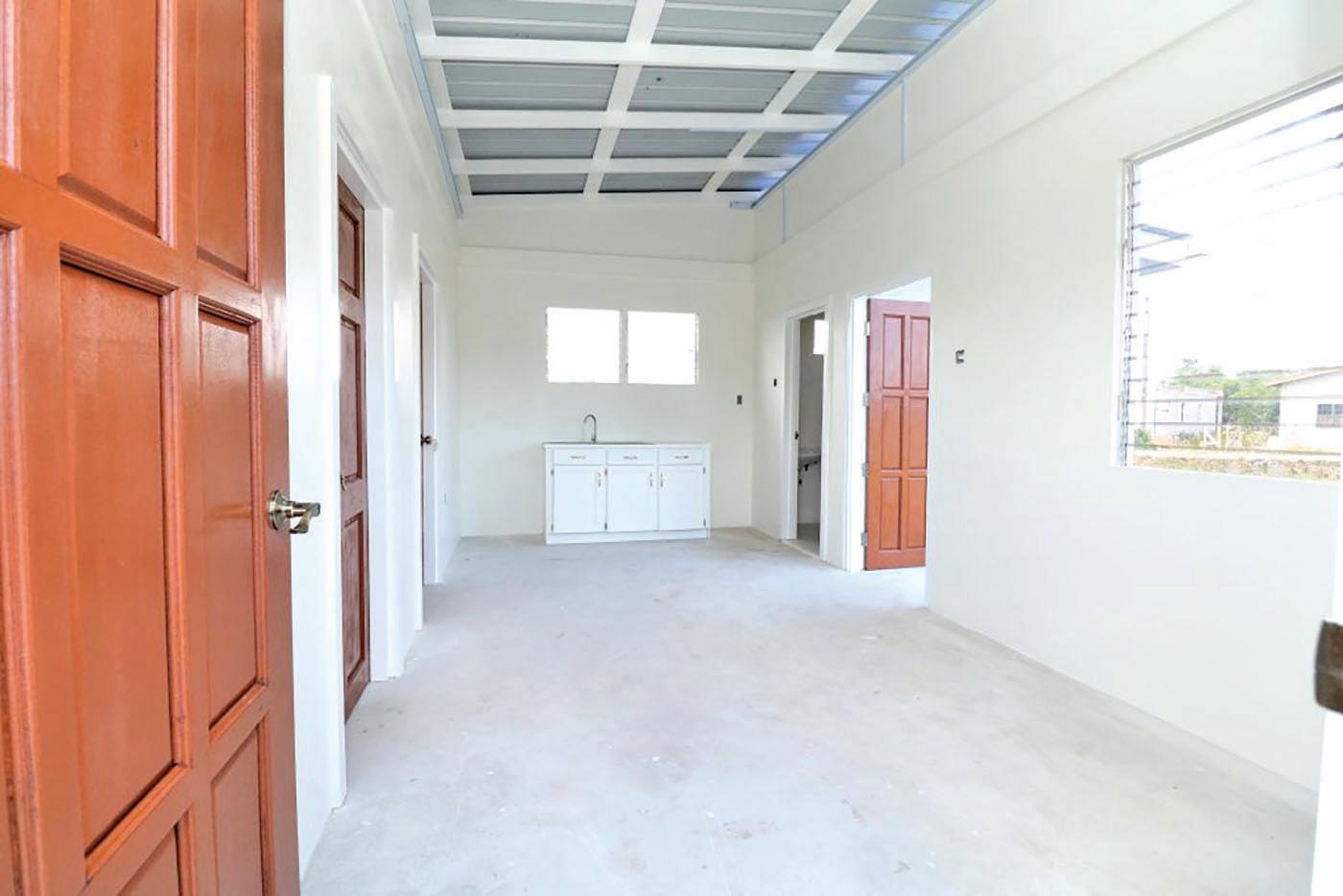
While the Ministry of Housing and Water is aiming to distribute 25,000 house lots this year, it also has an ambitious target of delivering more than 130 core homes this year, for persons who are desirous of the Government constructing homes on their behalf.
This target was provided by Minister of Housing and Water Colin Croal, while
he was being questioned by opposition Member of Parliament Volda Lawrence, during the consideration of the budget estimates for his Ministry on Friday.
“The core home programme, which is under the adequate housing and urban accessibility programme –for this year we have 133 core homes to be constructed,” Minister Croal informed the National Assembly.
According to the Core Homes Support initiative, families will be given the opportunity to have a new 20ft by 20ft, two-bedroom concrete house built for them with only a nominal contribution of $100,000.
The programme is catered for under line item 1903900 ‘Adequate Housing and Urban Accessibility Programme’, in the budget estimates, which lists un-
der the legend the “provision for quality housing and basic infrastructure solutions – IDB (Inter-American Development Bank).” Based on the estimates, a sum of $1.6 billion was allocated for this programme in 2025.
Minister Croal also acknowledged that there have been issues with some contractors, but noted that the defects liability period is implemented to ensure that any such issues can be fixed by the contractor within the shortest possible time.
“The Ministry has a project department. They have a team of staff that are assigned responsibility for the houses. And they all have defects liability periods. Before a house is handed over, an inspection is done by the bank. And the beneficiary,” he explained.
“We have had issues with some contractors. That’s factual. And I wouldn’t sit here to say we have not had challenges. And one of the major reasons has been because of our deliberate policy to ensure that the houses are not constructed at a profit-making basis. Because they’re kept to a minimum to allow affordability.”
Meanwhile, on the issue of Government subsi-
dies such as the steel and cement initiative, Croal explained that the programme will continue throughout the year. He also noted that the Government is implementing home improvement subsidies in areas such as Laing Avenue, Georgetown.
Phase one of the programme targets 60 families who would receive $250,000 vouchers each, totalling $15 million, to go towards home repairs. The overall goal of the project is to ensure approximately 200 families benefit from it.
“Let me outline the various areas we have some subsidies. You have the Laing Avenue project. There’s also the Lethem Housing project, which those houses are being built to $3 million; $1 million is subsidised through the Government and $2 million by the beneficiary.”
“We have the steel and cement initiative. That was launched at GuyExpo in 2022. And the steel and cement programme continue and will continue. And so that is one aspect. And in terms of other areas, we have not identified other areas, but we’re targeting programmes across the board rather than specific areas,”
Croal also said. The initiative was first developed after meetings that Vice President Bharrat Jagdeo had with residents of Laing Avenue, with the cost of upgrading and repairing their homes one of the concerns raised.
Meanwhile, the Lethem Housing Support Programme is the brainchild of President Ali, targeting 600 low-income families with affordable housing solutions and, specifically, a $1 million subsidy each to offset construction costs, while the beneficiaries would put up the remaining $2 million through bank loans.
Last year December, 20 of these Lethem families were officially handed the keys to their new homes under the Lethem Housing Support Programme. The newly constructed houses, each measuring 550 square feet (ft²), feature two bedrooms, a living room, a kitchen area, and washroom facilities.
The beneficiaries were presented with their keys during a simple ceremony held at their respective homes in Culver City and the new ‘Tract CHPA’ (Poke Bridge) Housing Scheme.
In a bid to make payments and transactions at the Linden Mayor and Town Council (LM&TC) more convenient for Linden consumers, stakeholders at the council are currently looking to expanding more of its services through the Mobile Money Guyana (MMG) app.
This move was discussed at one of the council’s recent statutory meetings last month. Spearheading the meeting was Linden Mayor, Sharma Solomon, who revealed that currently the council only utilises the online banking application for the submission of rates and taxes.
However, in light of digital the transformation taking place within the country, the Mayor highlighted that more of the council’s services should be moved online.
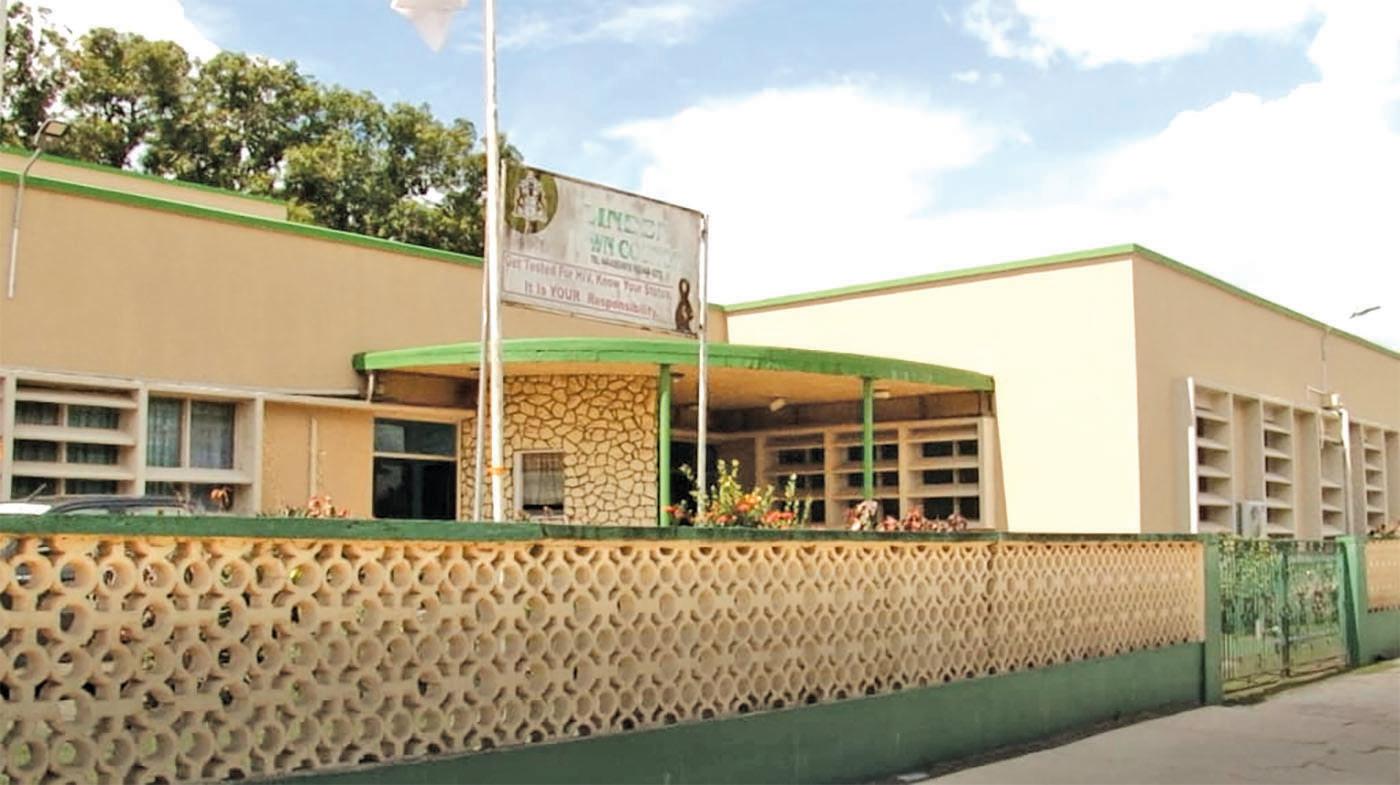
“So, we are at the minimal usage with MMG and I feel this is because we are just having it used with rates, one of the other things that MMG provides is that we can put other services on MMG. MMG is becoming very very convenient now.”
The Mayor added. “It is that accessible that more of our services should be on MMG, so whether people
want to pay for certificates, whether people want to pay for burials… so that we can move more of our services online that people can full out applications and then make their payments by MMG so they won’t necessarily have to come into the council.”
Meanwhile, speaking on the issue regarding the lack of use of the app, councillor Vanessa Kissoon pointed out that more advertising must be done to update residents about the council’s services.
“One of the things also, just like you said, its hard-
ly being used; it’s because in these modern times we also have to advertise our products as a council. So we need to maybe do an ad with somebody talking about they don’t have to go into the town council and then promote it and also do a demonstration because even with the elderly they ask people to pay they can just use the MMG app,” she suggested.
Moreover, public confidence in innovative solutions continues to grow in Guyana as One Communications announced in 2023 that more than 110,000 Guyanese are using its Mobile Money Guyana (MMG+) application to pay bills and conduct other transactions.
In addition to bill payments, MMG+ has diversified the transactions and partnered with stakeholders, including many Government and private organisations to simplify everyday service delivery.
Among the major Government partnerships are the Demerara Harbour Bridge (DHB) toll system (Breeze Pass), the Transport and Harbour Department (T&HD) toll system (Ferry Pass), utility service providers, National Insurance Scheme (NIS), Ministry of Human Service and Social Security’s old age pension and the Guyana Revenue Authority (GRA). Moreover, scores of private institutions have also partnered with One Communications to use MMG+ for payments of bills, including Courts, private education institutions, telecommunication service providers, commercial banks among others.
Moreover, many small businesses have also set up on the MMG+ platform as merchants, to allow their customers to process payments to them with ease, while MMG+ also continues to expand its biller options.

On Tuesday, January 28, Regional Police Divisional Commander, No.2
Pomeroon/ Supenaam, of the Guyana Police Force (GPF), Superintendent K. Shivbaran, spearheaded an outreach and distribution of footwear in Lima Sands Essequibo Coast.
Several children were beneficiaries of various sizes of footwear at the Lima Sands Police
Outpost.
In addition, the regional commander interacted with several residents where they discussed the security needs in their community, and a need for an increase in mobile patrols, along with building community partnerships.
Also discussed was the criteria for certified computer training at ZARA computer centres, and the ongoing recruitment for persons be-
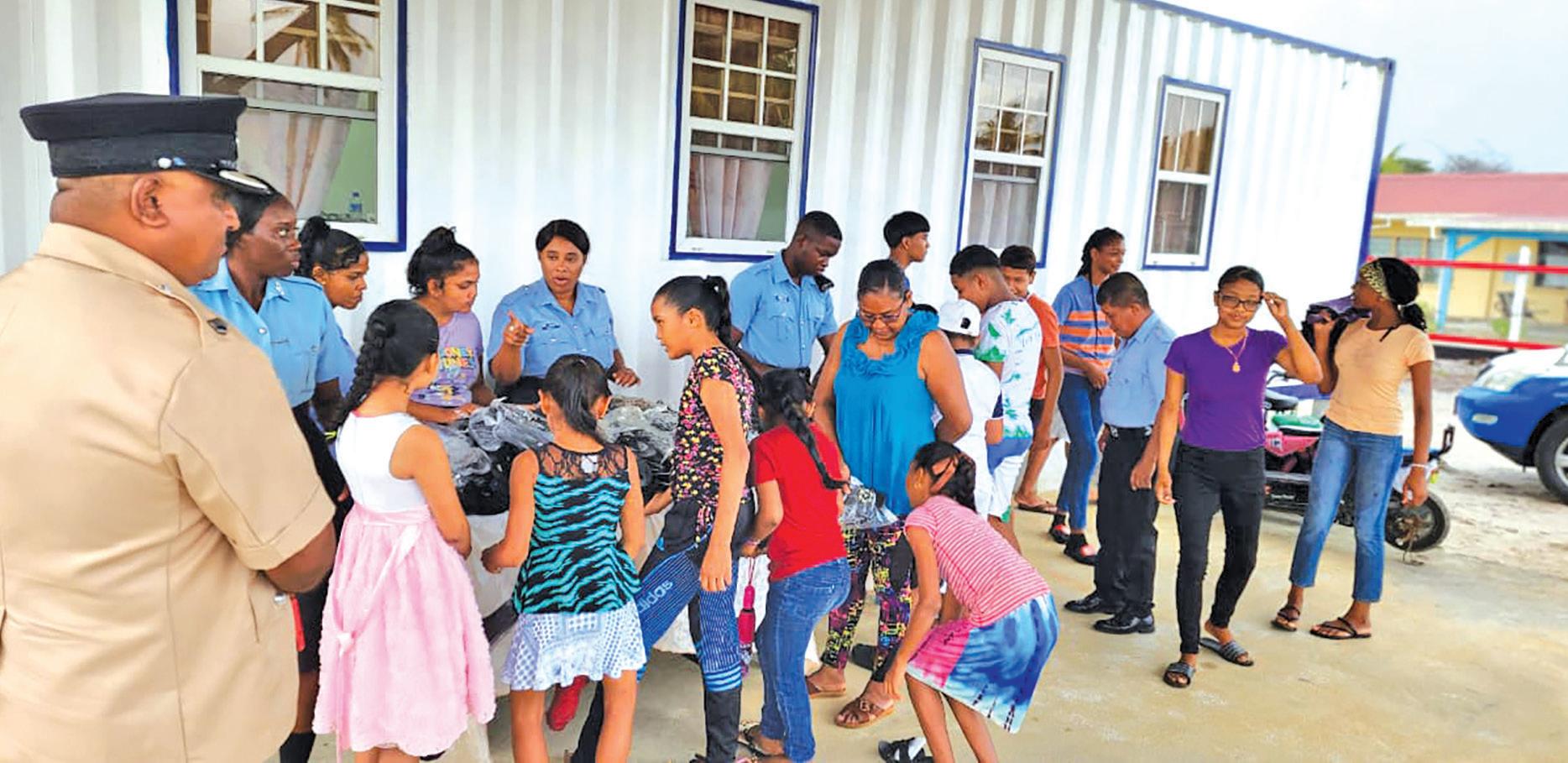
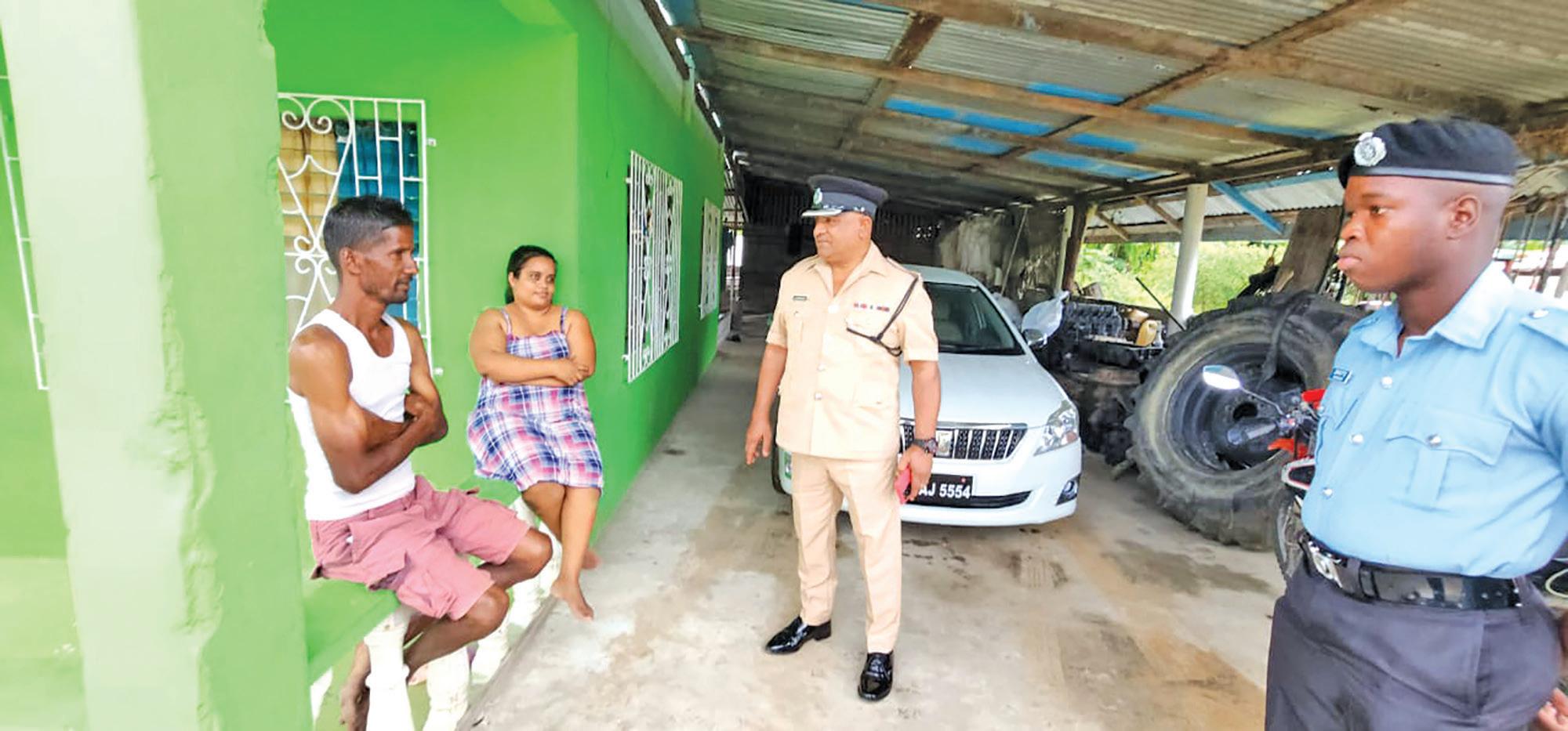
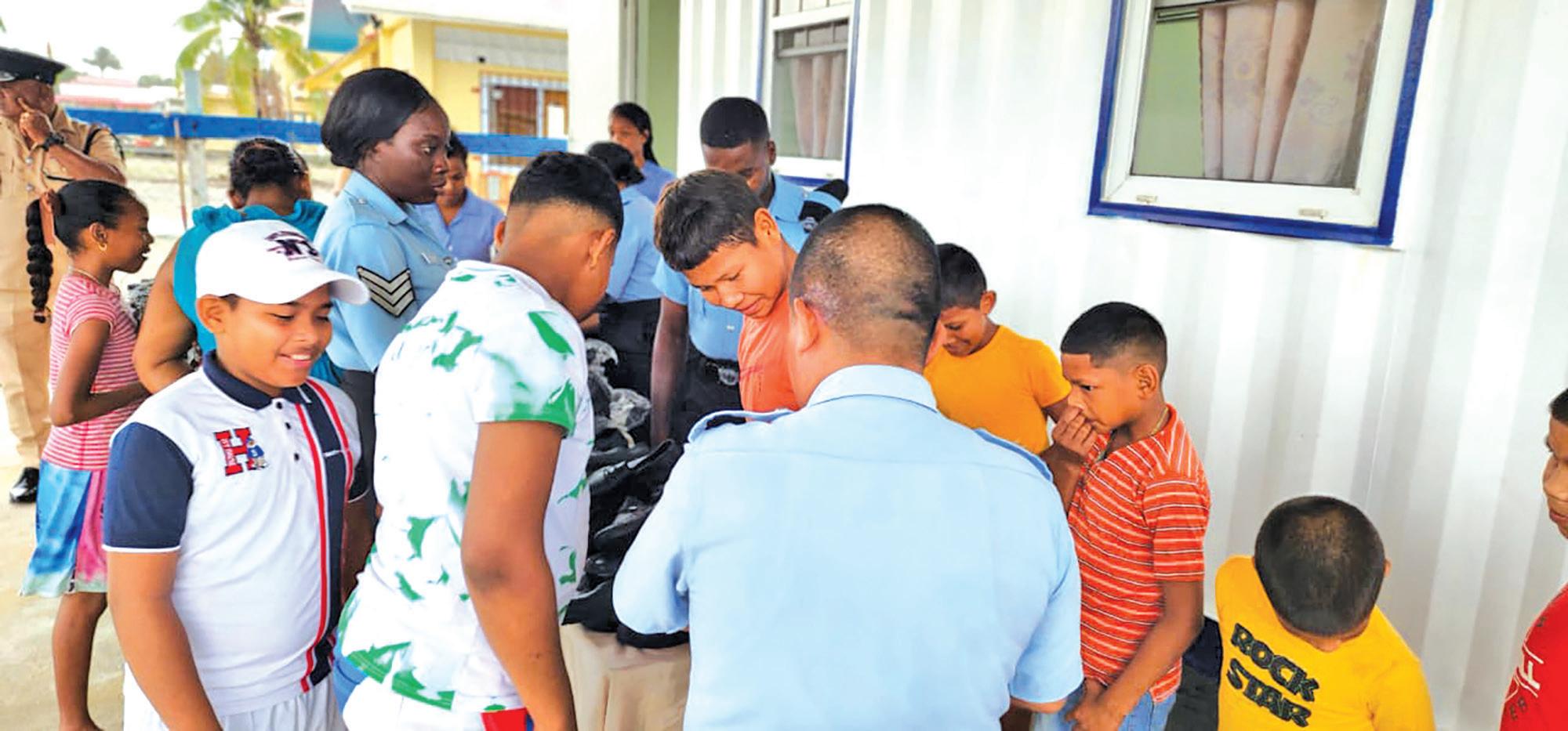
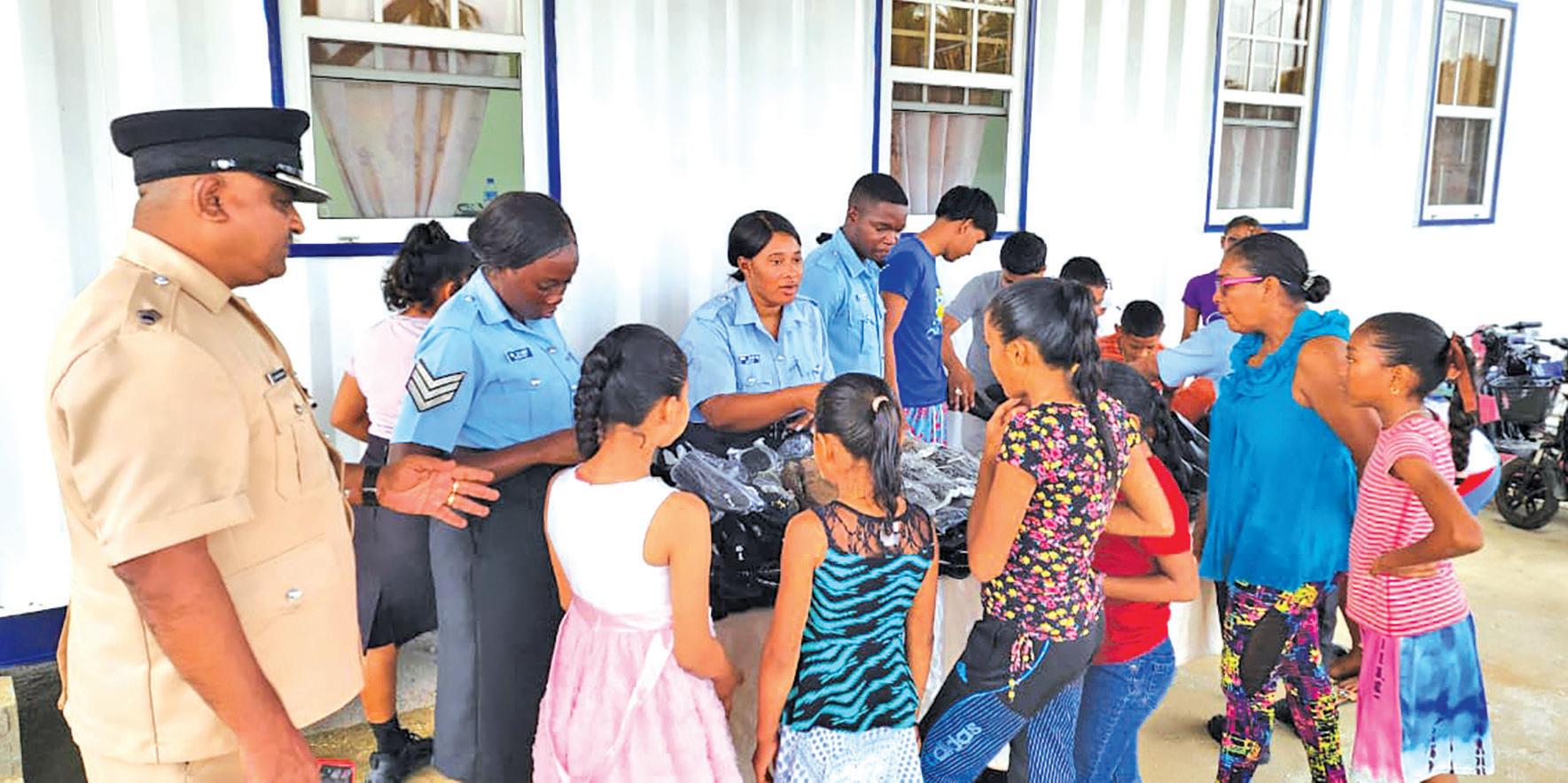
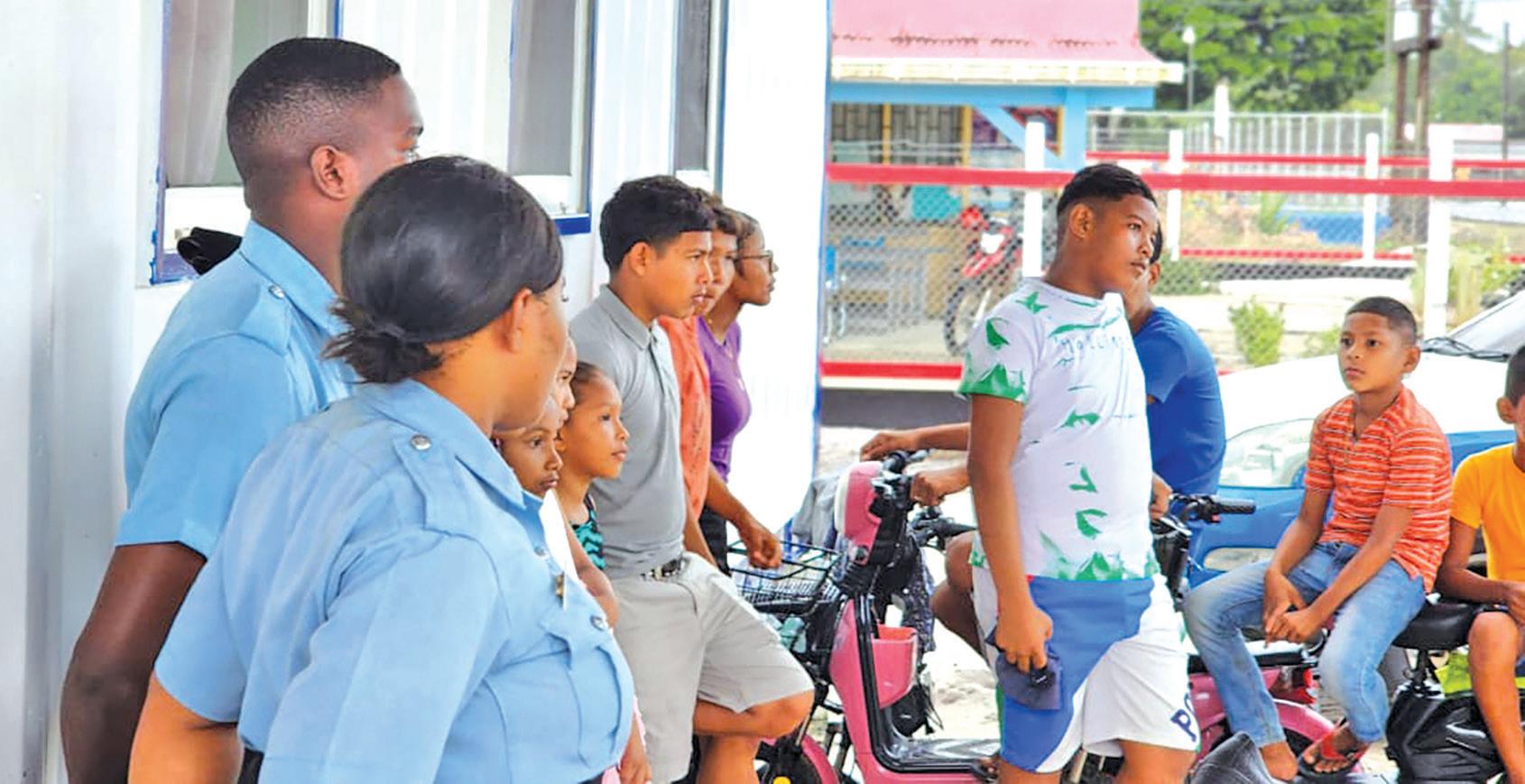
tween the ages of 18 and 30 years to the GPF.
A more efficient approach to community issues, reporting incidents and crime, and timely investigation into their reports were also among the discussions.
Residents focused on noise nuisance and suicide among people, as a result of personal and domestic problems
However, it was underage children driving
electric motorcycles and speeding motor vehicles were also highlighted during the discussions.
The commander informed residents that a mechanism will be in place to curb the trending behaviour.
The photos below shows the outreach and distribution activity while discussions were held at Lima Sands.
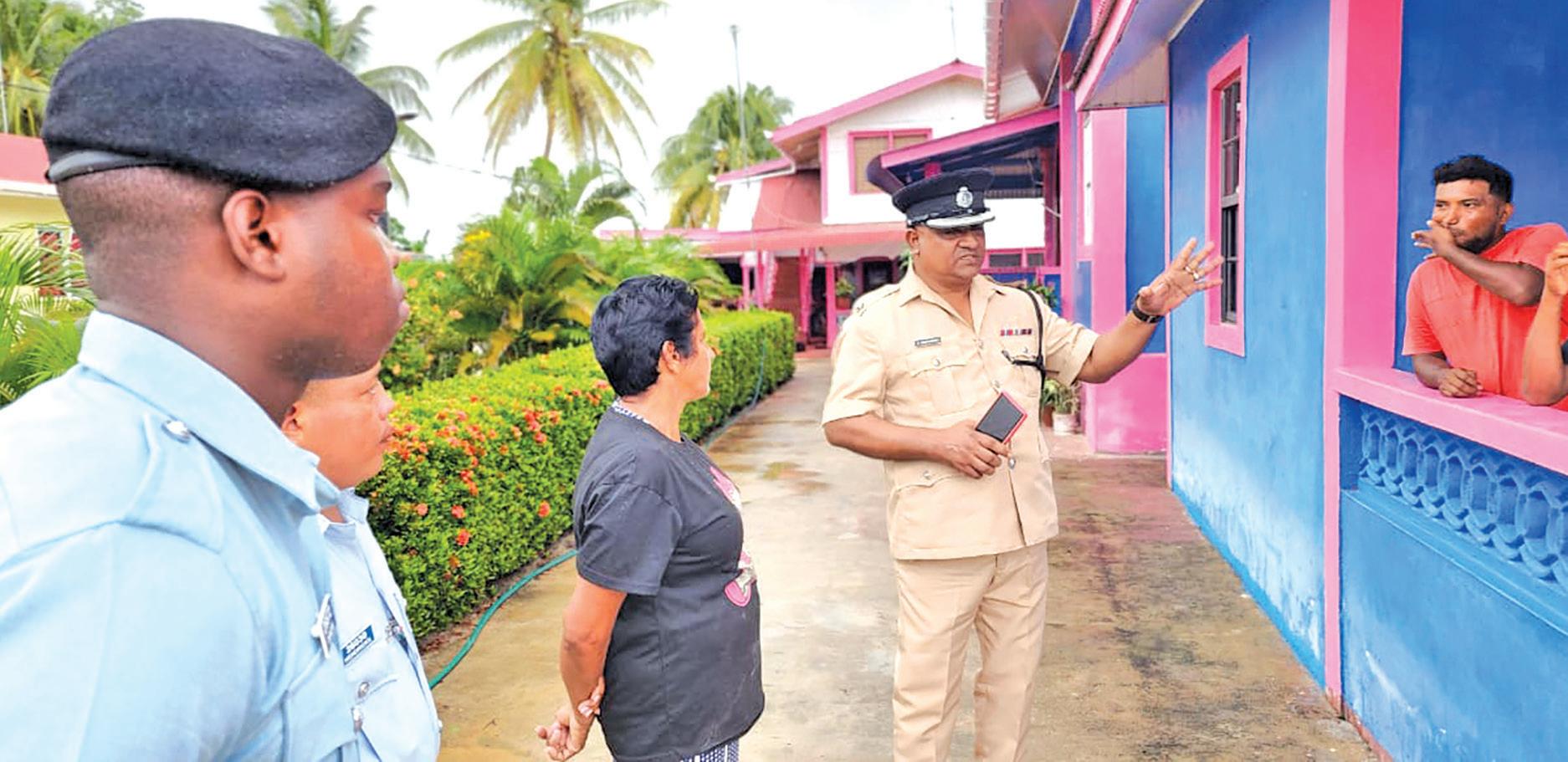





As we celebrate World Wetlands Day 2025, Sunday, February, 2 under the theme “Protecting Wetlands for Our Common Future”, we recognise wetlands' critical role in sustaining biodiversity, human well-being, and climate resilience. In the Caribbean, these ecosystems provide essential services such as water purification, flood regulation, carbon sequestration, and coastal protection while supporting many communities' livelihoods through fisheries, tourism, and agriculture.
Yet, despite their immense value, wetlands continue to face severe threats, including habitat destruction, pollution, overexploitation of resources, and climate change. Globally, it is estimated that over 35 per cent of wetlands have been lost since 1970, and in the Caribbean, many wetland areas are rapidly deteriorating due to coastal development, rising sea levels, and increasing human pressures. This underscores the urgent need for stronger conservation efforts and enhanced collaboration at all levels.
Effective wetland conservation requires coordination at global, regional, and national levels. The Ramsar Convention on Wetlands provides a crucial framework for global wetland conservation and wise use. At the regional level, the Cartagena Convention and its SPAW Protocol (Specially Protected

Areas and Wildlife) complement these efforts by fostering regional cooperation, establishing protected areas, and promoting the sustainable management of wetlands. However, ensuring the long-term protection of these ecosystems in the Caribbean also requires stronger synergies with other Multilateral Environmental Agreements (MEAs), a key priority promoted by the United Nations Environment Programme
Cartagena Convention Secretariat.
The Convention on Biological Diversity (CBD) advances ecosystem-based conservation strategies, the Convention on Migratory Species (CMS) protects migratory species that depend on wetlands, and the Convention on International Trade in Endangered Species (CITES) helps regulate trade in wetland-dependent species to prevent overexploitation.
By enhancing collaboration across these agreements, we can achieve a more coordinated and effective approach to wetland conservation in the Caribbean.
The Importance of Wetlands for Caribbean Biodiversity
Caribbean wetlands provide habitat for numerous species, many of which are listed under SPAW, CITES, and other international conservation agreements. Some
notable examples include:
The West Indian Manatee (Trichechus manatus) – Listed under both the SPAW Protocol Annex II and CITES Appendix I, this gentle marine mammal relies on mangroves and seagrass beds found in Caribbean wetlands for feeding and shelter. Its populations continue to decline due to habitat loss, boat collisions, and entanglement in fishing gear.
The American Crocodile (Crocodylus acutus) –Protected under CITES Appendix I and SPAW Annex II, this species depends on coastal wetlands, mangroves, and brackish lagoons for nesting and feeding. Habitat destruction and illegal hunting remain major threats to its survival.
The Caribbean Flamingo (Phoenicopterus ruber) – A flagship species of Caribbean wetlands, this bird depends on saline lagoons and mudflats for feeding. It is listed under CMS and SPAW (Annex III) and protected in several Ramsar sites across the region.
The Hawksbill Turtle (Eretmochelys imbricata) – Found in seagrass beds and coastal wetlands, this critically endangered species is listed under CITES Appendix I and the SPAW Protocol Annex II. Habitat degradation and illegal trade continue to threaten its populations.
The Red Mangrove (Rhizophora mangle) –A keystone species in
Caribbean wetlands, providing critical habitat for marine life, coastal protection, and carbon sequestration. It is listed under the SPAW Protocol (Annex III) due to its ecological importance and ongoing deforestation and coastal development threats.
These examples emphasise the crucial role of Caribbean wetlands in sustaining regional biodiversity and the interconnectedness of conservation efforts under different MEAs.
Strengthening Commitment to Wetland Protection
On World Wetlands Day 2025, the UNEP Cartagena Convention Secretariat calls on Caribbean countries, organisations, and communities to strengthen their commitment to wetland protection. A key step toward this goal is ensuring full regional participation in the SPAW Protocol, which now has 19 contracting parties, following the recent ratification by St Kitts and Nevis. However, nine countries have yet to join. Achieving universal ratification is essential to establishing a comprehensive and coordinated approach to wetland conservation in the Caribbean.
We urge policymakers in non-signatory countries to prioritise the adoption of the SPAW Protocol, reinforcing regional efforts to protect and sustainably manage these critical ecosystems. (UN Environment Programme)
Govt committed to supporting residents in
The expansion of the Aubrey Barker Road from a two-lane to a four-lane roadway has hit a stalemate, as homes that are currently occupying Government reserves are hindering its advancement, a Department of Public Information (DPI) news report has stated.
According to the DPI, Minister of Public Works, Bishop Juan Edghill on Saturday engaged the affected homeowners and confirmed that none possess legal titles or transport for the land they occupy. He assured them that the Government will work closely with the residents to minimise disruptions while ensuring the project’s completion.
These residents were informed that if they don’t
have a pending housing application, they will need to apply. From there, the Government in collaboration with the Ministry of Housing and Water will render support in their relocation.
Speaking to the DPI, the Minister noted that all affected residents have expressed their willingness to collaborate with the Government.
“All of the residents that we have engaged are willing and ready to work with the Government on finding a solution without exception. All, without exception,” Minister Edghill emphasised.
He also revealed that during the engagement, an individual attempted to stir conflict. It was later revealed that this person was not part of the affect-
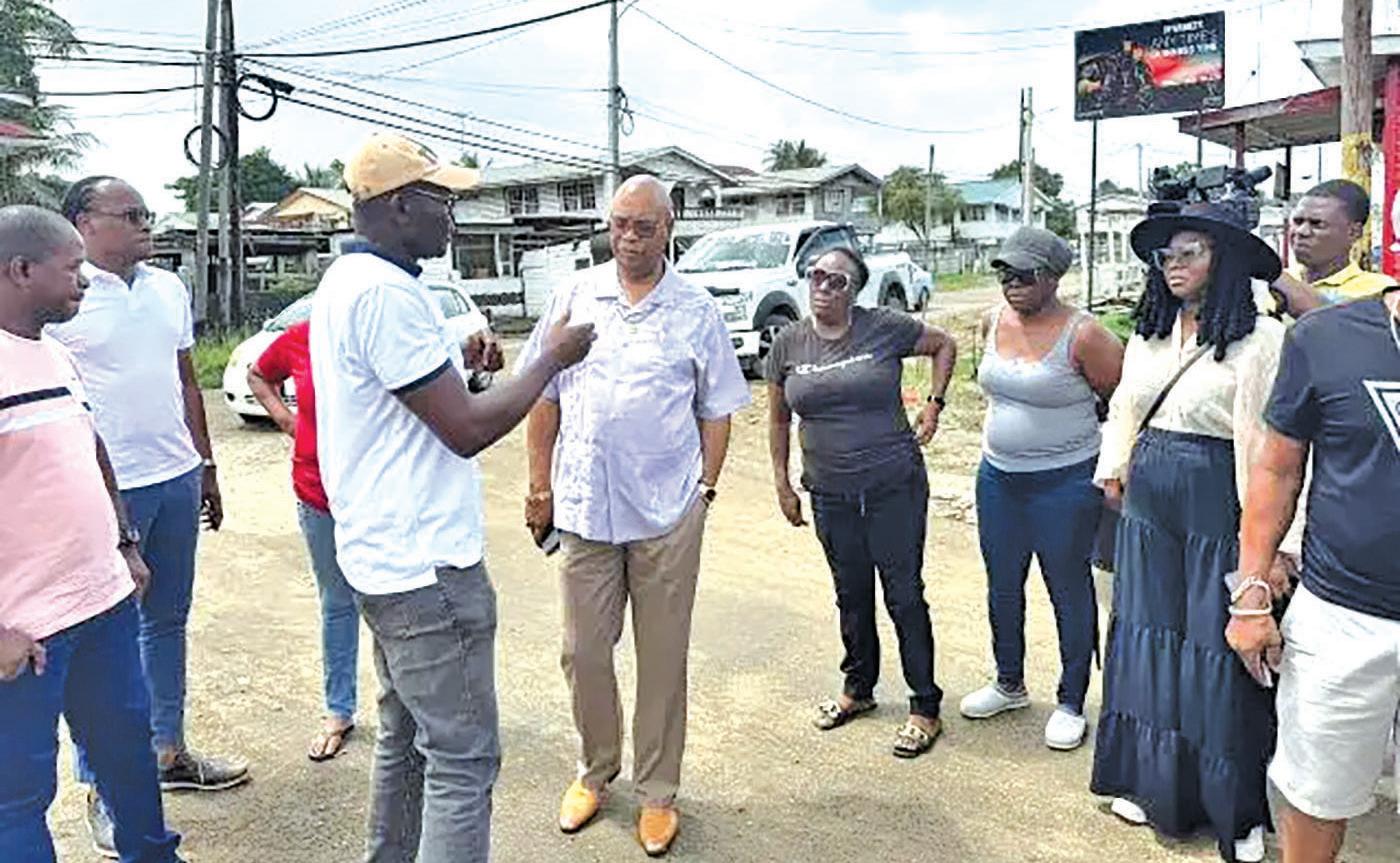
ed group residing on the reserve. The Minister took the opportunity to emphasise the importance of the project, stating, “This Aubrey
Barker Street expansion will extend all the way to Ogle and become a crucial
thoroughfare for improving traffic flow. There is also a major housing development at the back of Cummings Lodge.”
Despite the rapid pace of infrastructure development, he reassured the public that the well-being of Guyanese citizens remains central to all projects.
Additionally, stall owners operating along the roadway were informed of their impending relocation to facilitate construction.
A section of the Government reserve currently used for storing materials and equipment has been identified for upgrading into a tarmac, where the displaced vendors will be relocated, similar to the relocation process in Plaisance.

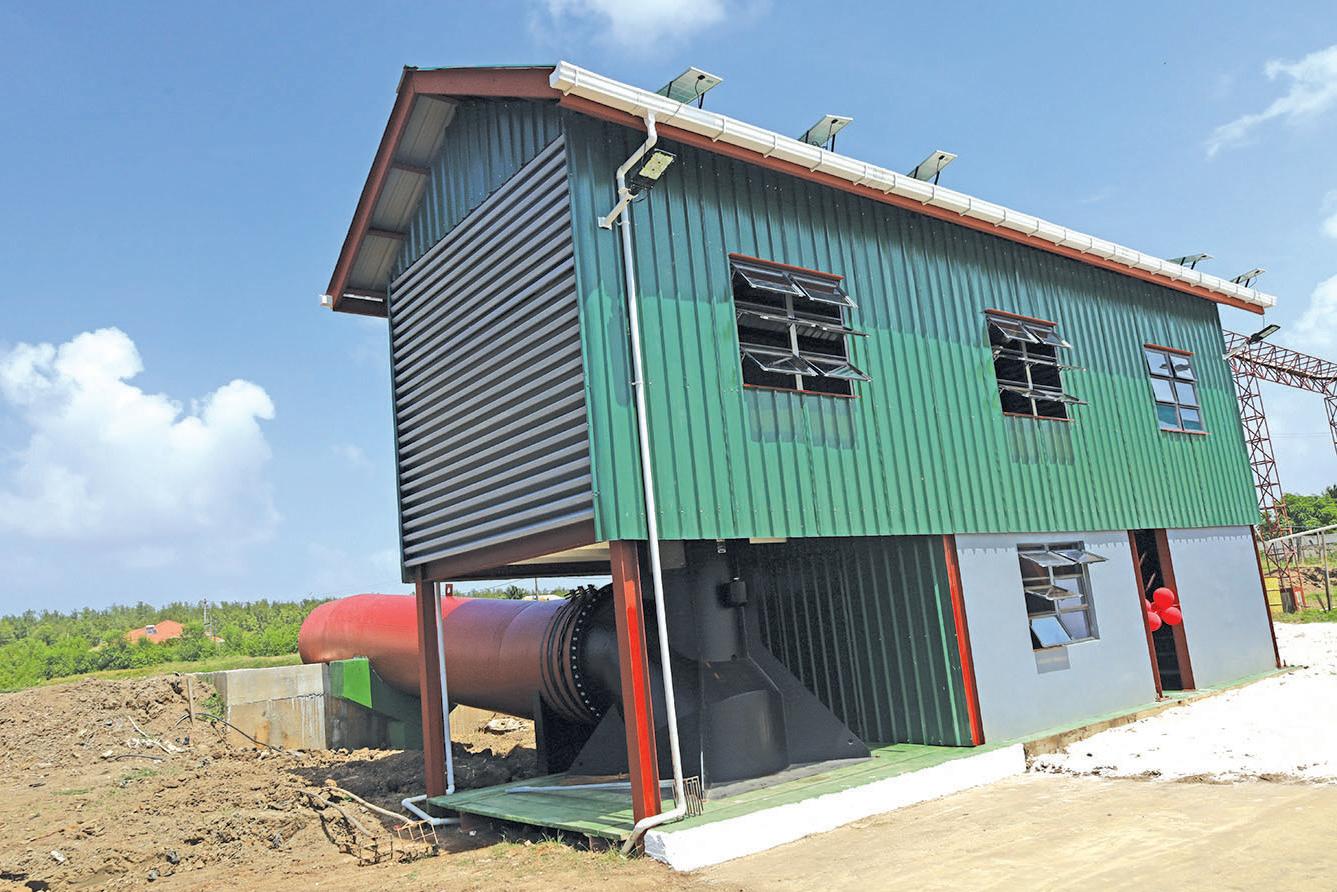
On Saturday, Agriculture Minister Hon. Zulfikar Mustapha commissioned a rehabilitated 200-cusec pump at the Montrose Pump Station on the East Coast of Demerara (ECD).
With an investment valued at approximately $226.7 million, Minister Mustapha said that over 3,549 acres of land, including 920 households and approximately 400 acres of residential area will benefit.
He further stated that the pump station’s additional drainage capacity forms part of the Government’s broader development agenda.
“This structure will not only help the agriculture sector, but it will also help enhance several villages be-
tween Plaisance and Success along the East Coast of Demerara. When we were in Government before 2020, there were massive investments in infrastructure. We want to ensure that we develop the country’s drainage capacity by building an extensive drainage system. This pump station will complement the drainage capacity in the farming and residential areas,” he explained.
The Ministry of Agriculture’s press release also noted that Minister Mustapha said since taking office, the Government has increased investment in drainage and irrigation (D&I) by 760 per cent.
“In just over four years, we’ve increased investment in the D&I system by 760 per cent. That tells us where
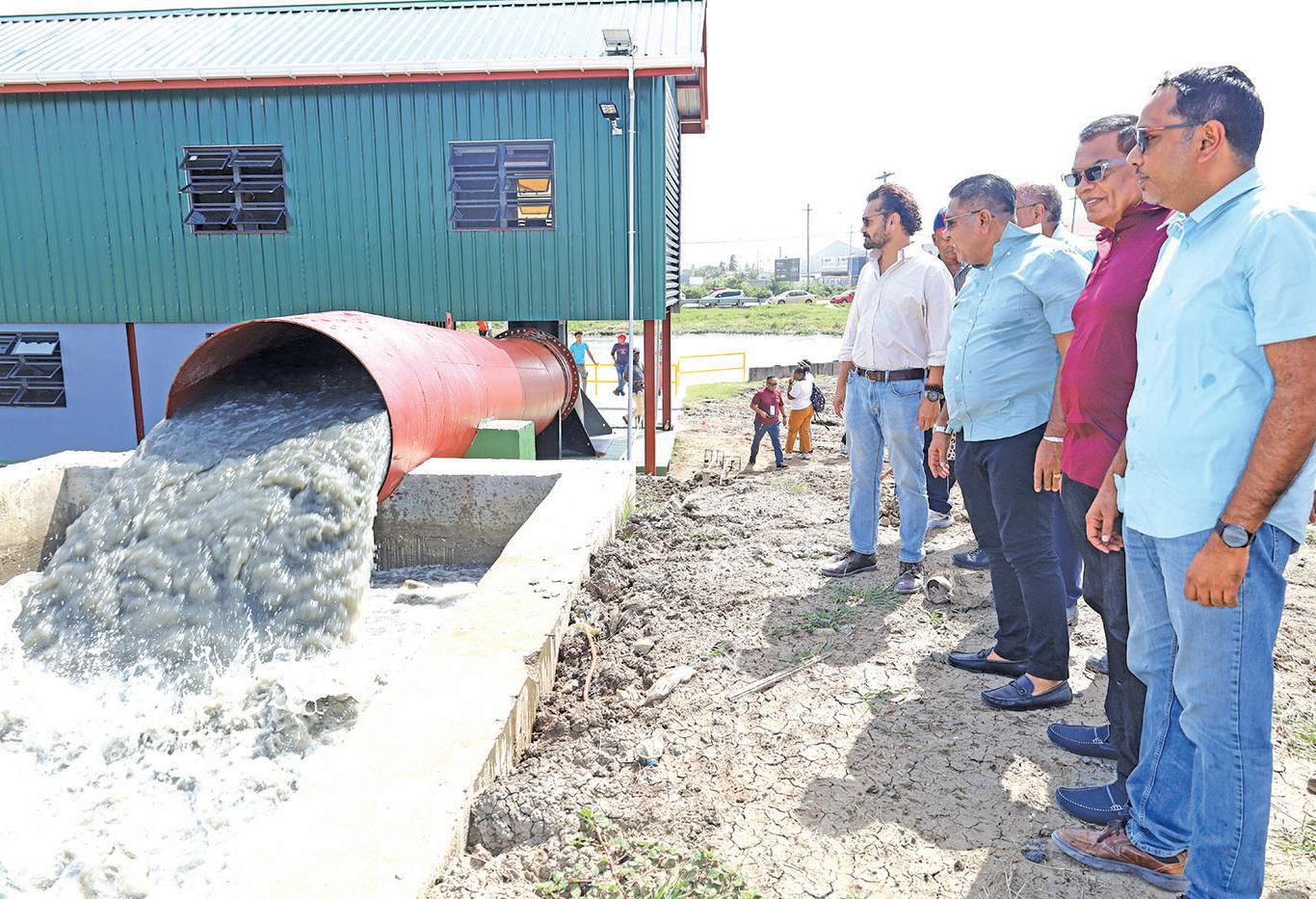
Chairman of the National Drainage and Irrigation Authority (NDIA), Lionel Wordsworth said over the last two years, the NDIA has embarked on a programme to not only put new drainage and irrigation structures in place but to also enhance and upgrade existing structures.
Areas such as Success, Mon Repos, Better Hope, Vryheid's Lust, and Plaisance will now benefit from improved D&I services. $226.7
this Government wants to take Guyana. We cannot be food secure and drive the 25 by 2025 initiative without investing in infrastructure. While we are investing in enhancing the country’s drainage and irrigation system and ramping up production, there is a revolution in the other sectors. Thousands of community roads are being constructed. There are also massive investments in the health, education, and other sectors. We are not only investing in one area. We are investing in all of the sectors so that we can enhance the lives of the people of this country. This investment is not in isolation. When we make these investments, we are making a genuine effort to modernise our country’s infrastructure,” he added.
“Over the last two years, the NDIA started a programme of investment to not only put new infrastructure in place but to also upgrade existing infrastructure as Guyana is exposed to the effects of climate change. If we are to comply with the adaptation strategy, which is very important for us, projects like these where we have existing infrastructure, we have to upgrade them to
manage extreme weather events. Following the 2005 flood, the Government and the World Bank invested to conduct a study. One of the recommendations was to improve and upgrade key infrastructure. Over the last two years, we’ve conducted 28 improvement projects across regions two to six with 37 new pumps being installed at new sites and upgrading some at the existing sites,” he explained.
Permanent Secretary (ag), Dacia Ferguson said the enhanced infrastructure will ensure reliable and consistent access to effective drainage to farmers and residents along the East Coast of Demerara (ECD).
“This marks an important milestone in our ongoing
efforts to strengthen agriculture, enhance food security, and promote sustainable development in our communities. It is not just the completion of a new project but the start of a new chapter for the farmers in this area. With this new infrastructure, we are ensuring reliable and consistent access to effective drainage. This project represents a substantial investment in agricultural infrastructure. Without these key investments in infrastructure, the delivery of critical services may not take place at the desired pace,” she said.
– subscribers now have option to change phone service while keeping existing number
The Public Utilities Commission (PUC) on February 1, announced the implementation of number portability in Guyana, effective February 10, 2025.
The official launch of this service will be shared in a subsequent announcement to be made shortly, it advised in a press release.
Number portability allows both fixed-line and mobile subscribers to switch their services to other service providers whilst retaining their existing phone numbers.
The PUC described the move as a transformative service, designed to foster competition in the telecom-
munications sector, and offers consumers greater freedom to choose providers.
It marks a pivotal step in enhancing consumer choice and driving innovation in the telecommunications industry, the PUC noted.
This milestone is a direct result of the liberalisation of the telecommunications sector on October 5, 2020, and the subsequent issuance of the Telecommunications (Commencement of Number Portability Obligations) Order on July 1, 2021, by the Honourable Prime Minister, Brigadier (Ret’d) Mark Phillips.
In line with the Hon. Prime Minister’s directive, the PUC, tasked with ensur-
ing the smooth implementation of number portability, established the Number Portability Working Group (NPWG) in August 2021.
This group, chaired by the Commission, included representatives from the telecommunications service providers and the Telecommunications Agency.
The NPWG has held weekly meetings to oversee the various testing phases that are critical to the service’s success.
A dedicated technical subgroup, comprising project managers and technical leads from the service providers, was also formed to address specific challenges
and ensure seamless system integration across all networks.
Key accomplishments of the NPWG included the development and approval of the Business Rules, which outlines the operational guidelines for number portability and the contracting of PXS B.V, a clearinghouse provider from the Netherlands, which has been licensed by the Telecommunications Agency to provide number portability administration services in Guyana.
The PUC and the telecommunications service providers have been engaged in numerous technical
testing scenarios to ensure a seamless transition for subscribers and that all technical aspects of the service are functional as intended when it goes ‘live’ on February 10, 2025.
The end result of this is to successfully implement number portability, a service that will be beneficial to all users of telecommunications services in Guyana.
Subscribers desirous of changing their service providers will be required to visit the retail store of the preferred service provider and request the porting of their numbers by completing the relevant porting forms. A valid form of identification is required.
Mobile porting typically takes 1 business day while fixed line porting is expected to take 5 business days.
The PUC has advised that further information on the complete porting process and for answers to frequently asked questions, subscribers may visit the Public Utilities Commission’s website at www.puc.org.gy and its Facebook page at www. facebook.com/pucgy. Alternatively, subscribers may contact the Commission during business hours at telephone numbers 226-7042/ 2272182/336-6077 and via WhatsApp at 623-3222/ 624-6000 for further details.




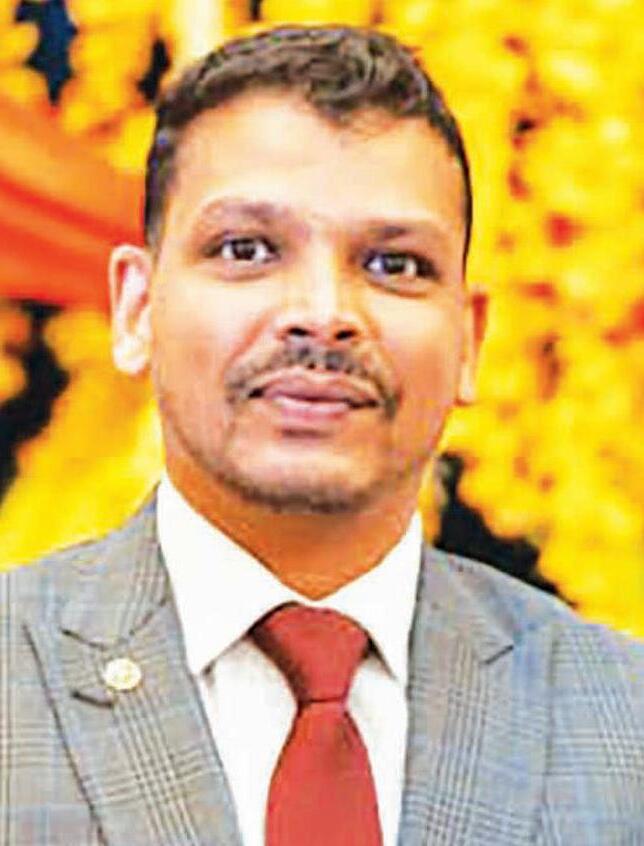
Dr Tariq Jagnarine Fam meDicine, enDocrinology & DiabeTes
Lower back pain is a common cause for visits to the doctor as well as the most common cause of job-related disability. At least 80 percent of persons worldwide will experience low back pain in their lifetime.
Most low back pain is the result of an injury, such as muscle sprains or strains due to sudden movements or poor body mechanics while lifting heavy objects.
Low back pain can also be the result of certain diseases, such as:
Sciatica- Pinch Nerve
• Arthritis of the back Cancer of the spinal cord
• A ruptured or herniated disc
• Kidney infections Infections of the spine
Strains
The muscles and ligaments in the back can stretch or tear due to excess activity. Symptoms include pain and stiffness in the lower back, as well as muscle spasms. Rest and physical therapy are remedies for these symptoms.
Disc injury
The discs in the back are prone to injury. This risk increases with age. The outside of the disc can tear or herniate. A herniated disc, which is also known as a slipped or ruptured disc, occurs when the cartilage surrounding the disc pushes against the spinal cord or nerve roots. The cushion that sits between the spinal vertebrae extends outside its normal position.
This can result in compression of the nerve root as it exits from the spinal cord and through the vertebral bones. Disc injury usually occurs suddenly after lifting something or twisting the back. Unlike a back strain, pain from a disc injury usually lasts for more than 72 hours.
Sciatica
Sciatica can occur with a herniated disc if the disc presses on the sciatic nerve. The sciatic nerve connects the spine to the legs. As a result, sciatica can cause pain in the legs and feet. This pain usually feels like burning, or pins and needles.
Spinal stenosis
Spinal stenosis is when

Acute back pain can last anywhere from a few days to a few weeks, while chronic back pain is pain that lasts longer than three months.
Low back pain is more likely to occur in individuals between the ages of 30 and 50. This is partly due to the changes that occur in the body with aging. As persons grow older, there is a reduction in the fluid content between the vertebrae in the spine. This means discs in the spine experience irritation more easily. In addition, more muscle tone is loss, which makes the back more prone to injury.
WHAT ARE THE CAUSES OF LOW BACK
the spinal column narrows, putting pressure on the spinal cord and spinal nerves. Spinal stenosis is most commonly due to degeneration of the discs between the vertebrae. The result is compression of the nerve roots or spinal cord by bony spurs or soft tissues, such as discs.
Pressure on the spinal nerves causes symptoms such as numbness, cramping, weakness
These symptoms may be felt anywhere in the body. Many people with spinal stenosis notice their symptoms worsen when standing or walking.
• Abnormal spine cur-



vatures
Scoliosis, kyphosis, and lordosis are all conditions that cause abnormal curvatures in the spine. These are congenital conditions that are usually first diagnosed during childhood or adolescence. The abnormal curvature causes pain and poor posture because it places pressure on Muscles, tendons, ligaments, and vertebrae
• Other conditions
A number of other conditions causes lower back pain. These conditions include:
• Arthritis is an inflammation of the joints.
Fibromyalgia is longterm pain and tenderness in the joints, muscles, and tendons.
Spondylitis is inflammation of the joints between the spinal bones.
Spondylosis is a degenerative disorder that may cause loss of normal spinal structure and function.
Although aging is the primary cause of the condition, the location and rate of degeneration is specific to the individual.
Additional health conditions that can cause lower back pain include: Kidney and bladder problems
Pregnancy
• Endometriosis
Ovarian cysts
Uterine fibroids
• Cancer Diagnosis of Back Pain
A complete medical history and a thorough physical examination is done to determine where the pain is felt. A physical exam can also determine if the pain is affecting a person’s range of motion. Reflexes and sensations are also explored to determine if the low back pain is affecting nerves.
Unless there is concerning or debilitating symptoms or neurologic loss, doctor will monitor patient’s condition for
a few weeks before sending for testing. This is because most low back pain resolves using simple self-care treatments. Certain symptoms require more testing, including: Lack of bowel control
Weakness
• Fever Weight loss
• Recent severe trauma to the back
• One sided pain
• A history of cancer or steroid use
• Pain resistant to treatment
Imaging tests such as X-rays, CT scans, ultrasounds, and MRIs may be necessary for underlying severe issues such as:
• Bone problems
Disc problems
Stop any normal physical activities for a couple of days and apply ice to the lower back. Ice is recommended for the first 48 to 72 hours, then switching to heat. Alternate ice and heat to relax muscles. The RICE protocol — rest, ice, compression, and elevation — is recommended within the first 48 hours. Take over-the-counter pain medication, such as ibuprofen or Panadol, Voltaren, to relieve pain.
A warm bath or a massage can often relax stiff and knotted muscles in the back.
Medical treatment
There are a number of possible medical treatments including:
• Medications
Medical gels and ap-
tions
Physical therapy, including:
Massage
• Stretching
Strengthening exercises
Back and spinal manipulation
• Yoga Walking Surgery
For severe cases, surgery may be necessary. Surgery is usually only an option when all other treatments fail. However, if there is loss of bowel or bladder control, or a progressive neurological loss, surgery becomes an emergency option.
There are many ways to prevent low back pain. Practicing prevention techniques may also help lessen the severity of one’s symptoms if presented with a lower back injury.
Prevention involves:
• Exercising the muscles in the abdomen and back
• Losing weight if overweight
• Lifting items properly by bending at the knees and lifting with the legs
• Maintaining proper posture
• Sleep on a firm surface
• Sit on supportive chairs that are at the correct height
• Avoid high-heeled shoes

• Problems with the ligaments and tendons in the back
TREATMENT OPTIONS FOR LOWER BACK PAIN
Home care
Self-care methods are helpful for the first 72 hours after the pain begins. If the pain does not improve after 72 hours of home treatment, then further treatment is needed.
Physical therapy
Some medications include:
Muscle relaxants
• Nonsteroidal anti-inflammatory drugs (NSAIDs)Ibuprofen, Diclofenac, Aspirin
• Narcotic drugs such as codeine for pain relief
• Steroids to reduce inflammation
Corticosteroid injec-
Quit smoking, Nicotine causes degeneration of spinal discs and reduces blood flow.
It is also possible for low back pain to develop with no definitive cause. When this happens, the primary focus is on treating the symptoms rather than the cause of the symptoms and the patient’s overall health.


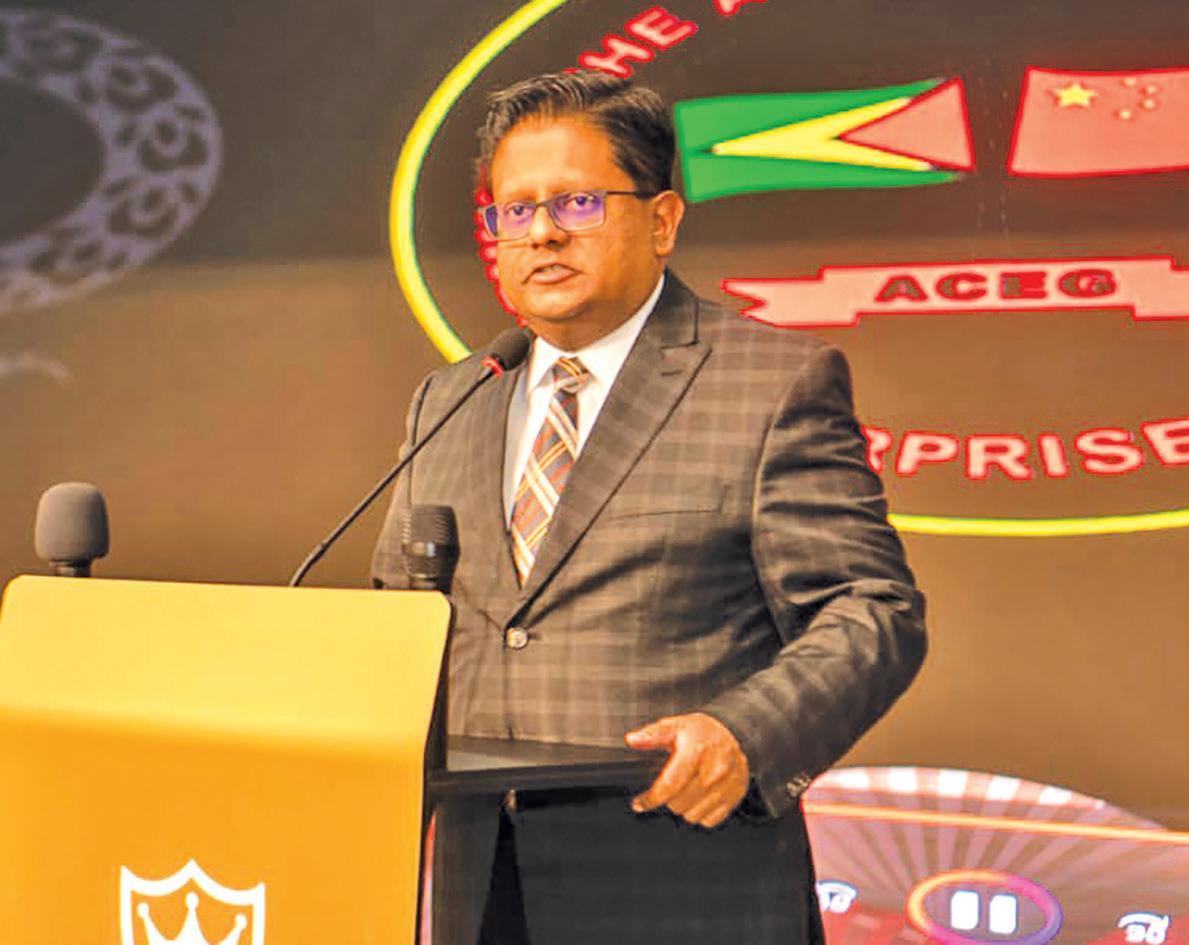
Senior Minister in the Office of the President with Responsibility for Finance
Dr Ashni Singh, on Friday last, represented His Excellency the President, Dr Mohamed Irfaan Ali, and delivered the feature address on his behalf at an Annual Dinner held by the Association of Chinese Enterprises in Guyana, commemorating the 2025 Chinese New Year and Spring Festival.
Dr Singh highlighted the fact that Guyana and China have a longstanding historic relationship rooted in the arrival of Chinese immigrants in 1853. Since then, the number of
Chinese nationals and persons of Chinese descent in Guyana has grown steadily, and persons of Chinese origin have contributed to every facet of human endeavour in Guyana.
According to a Ministry of Finance press release, he also emphasised the presence and significance of several aspects of Chinese culture in the diverse tapestry that comprises today’s Guyana. The Minister further noted that, in more recent years, in response to the rapid transformation that is taking place in the Guyanese economy, there has been a larger presence of Chinese companies in Guyana.
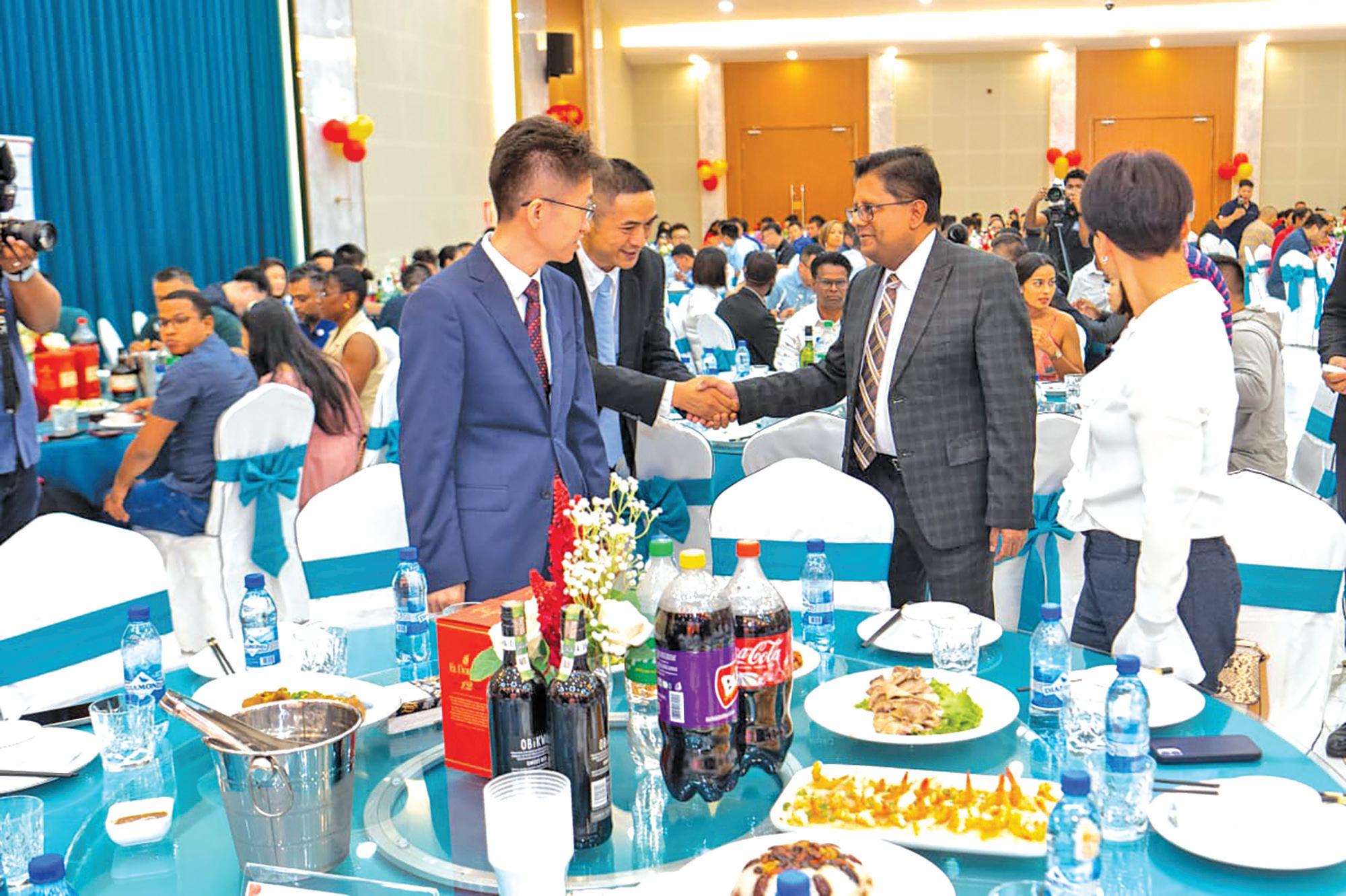
These include companies operating in the oil and gas sector, other extractive sectors, infrastructural construction, and commercial trade.
While Dr Singh reiterated that Guyana is open for business, he acknowledged the companies from all around the world present in the country as he emphasised that they are all welcome as long as these companies respect and comply with the laws of Guyana and create opportunities for Guyanese nationals.
Minister Singh reminded that Government’s pri -

Caribbean Community (CARICOM) Heads of Government will meet in Barbados, February 19-21, 2025, for their 48th Regular Meeting, which is being convened under the theme, ‘Strength in Unity: Forging Caribbean Resilience, Inclusive Growth and Sustainable Development’.
According to CARICOM, Heads of Government will discuss several pressing issues for the Community, including food and nutrition security; climate change and the climate finance agenda; the ongoing challenges in Haiti; security is-
sues; digital resilience; external relations matters and the CARICOM Single Market and Economy (CSME).
Other issues such as maritime and air transport, and reparations, will also occupy the attention of the leaders over the two-day period.
The Meeting’s Opening Ceremony will take place Wednesday, February 19, at the Lord Erskine Sandiford Centre, Bridgetown. Scheduled to deliver addresses are the Chairman, Hon. Mia Amor Mottley of Barbados; outgoing Chairman, Hon. Dickon
Mitchell of Grenada; the new Premier of Montserrat, Hon. Reuben T. Meade, and CARICOM SecretaryGeneral, Dr Carla Barnett.
Special guests at the ceremony include SecretaryGeneral of the United Nations (UN), H.E. Mr António Guterres, and President of the European Commission, H.E. Ms Ursula von der Leyen, both of whom will also deliver addresses.
The business sessions of the Meeting, February 20-21, will be held at the Wyndham Grand Barbados – Sam Lords Castle in St. Philip.
ority is to create opportunities for Guyanese nationals, including through creation of employment and entrepreneurial opportunities, with
the aim of generating incomes and improving livelihoods for all Guyanese. He then, on behalf of President Ali, wished the ACEG and all Chinese companies and nationals in Guyana, as well as all other Guyanese, a Happy Chinese New Year and Spring Festival.
The event was also attended by the Charge d’Affaires at the Chinese Embassy in Guyana, Guyana’s Ambassador to China, and the British High Commissioner to Guyana, as well as the heads and representatives of several Chinese companies operating in Guyana and their Guyanese partners and counterparts.
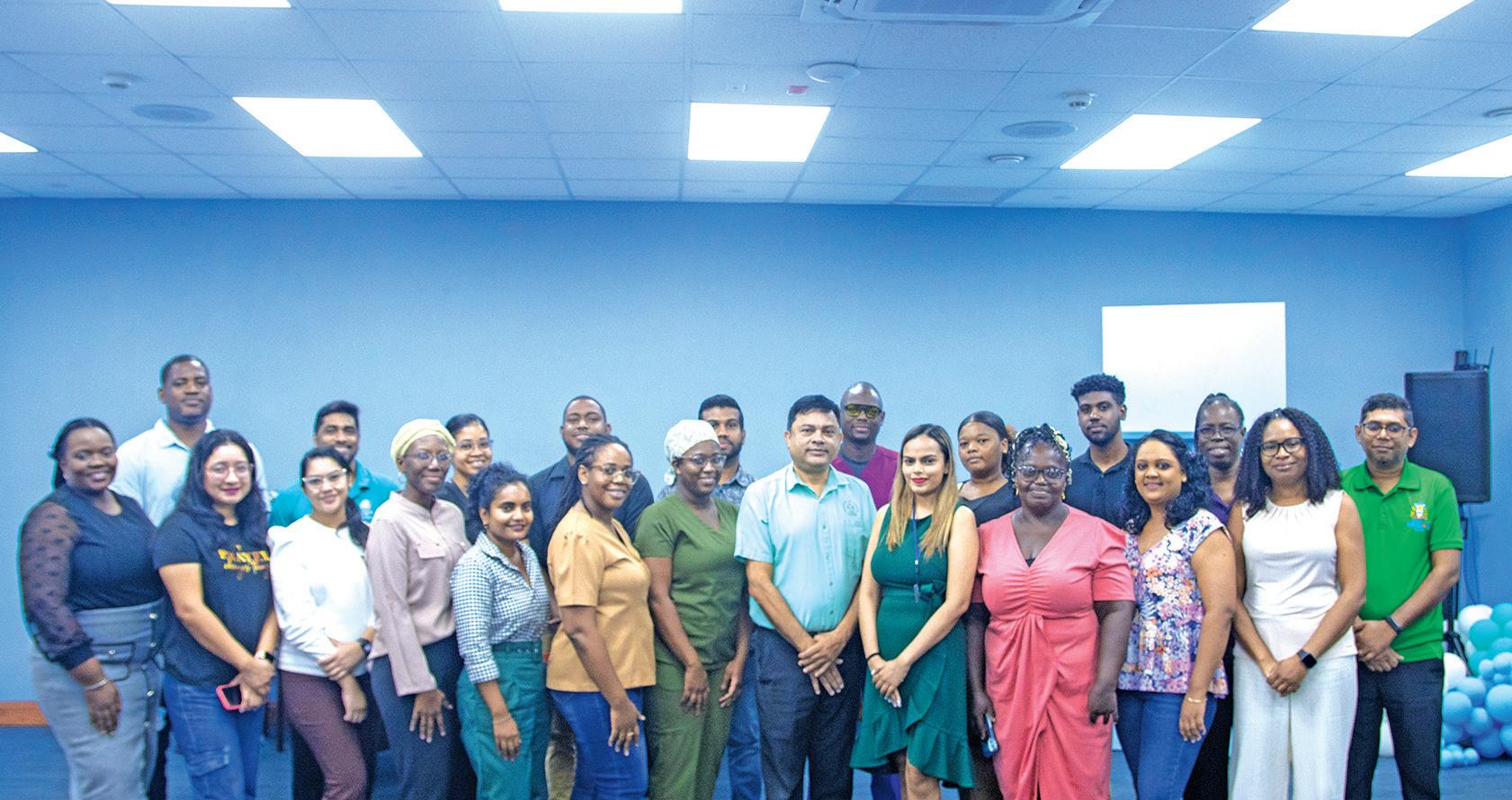
The Ministry of Health’s Chronic Diseases Unit, on Friday last, hosted a Review Meeting on Tobacco Cessation Clinics at the Ministry of Health Boardroom, Brickdam, Georgetown.
The meeting focused on evaluating the clinics’ progress, addressing challenges, and identifying strategies to enhance tobacco cessation services.
Key discussions included patient success rates, intervention effectiveness, and barriers to service delivery.
Healthcare professionals also explored solutions to improve clinic accessibility, resources, and public awareness efforts.
Currently, there are nine (9) tobacco cessation clinics operating in Regions Three and Four.
According to the Ministry’s press release, key
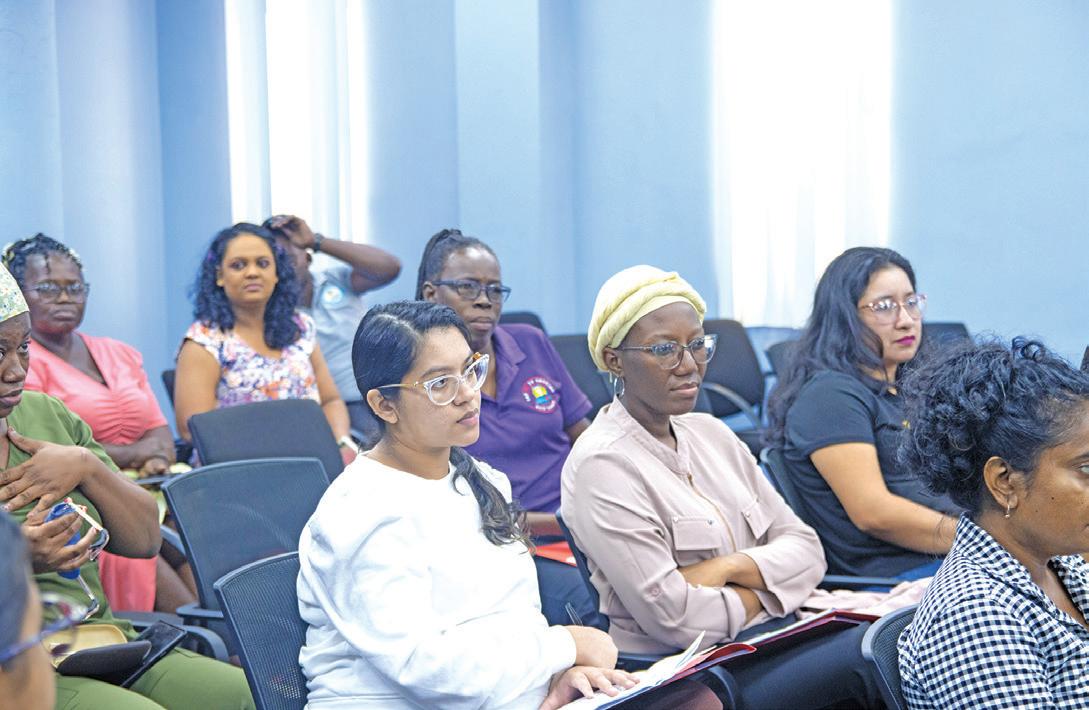
interventions provided at these clinics include brief tobacco intervention and nicotine replacement therapy, both of which have been instrumental in supporting individuals on their journey to quitting tobacco use.
Through ongoing evaluation and improvements, the Ministry aims to enhance the effectiveness of cessation clinics nationwide and
strengthen its commitment to reducing the impact of tobacco-related diseases. Among those present at this morning’s meeting were Chief Medical Officer Dr Narine Singh, Chronic Disease Unit Co-ordinator Dr Dianele Drepaul, and Tobacco Control Officer Dr Shelieza Gopie from the Ministry of Health.


On World Neglected Tropical Disease Day
2025, held January 30, the World Health Organisation (WHO) and the global partners’ community called on Government, leaders, communities and individuals to unite, act and eliminate Neglected Tropical Diseases (NTDs).
“On World Neglected Tropical Disease Day 2025, we urge unified action to eliminate NTDs, strengthen health systems and empower communities for sustainable solutions,” said Dr Ibrahima Socé Fall, Director, WHO Global NTD Programme.
According to WHO, this
year’s campaign stressed that combating NTDs not only reduces the burden of these diseases but also contributes to stronger health systems.
It noted that addressing the impact of climate change on NTDs is possible through a One Health approach that combines human, animal and environmental health, and that empowering people and communities will lead to person-centred, tailored, inclusive and impactful programmes, which will pave the way for sustainable and effective solutions to the challenges faced.
The health organisation added that 2024 was marked
by significant progress, though it ended with the demise of former US president Jimmy Carter, who has left a legacy of unwavering dedication and support to combating NTDs.
NTDs are a diverse group of conditions caused by a variety of pathogens (including viruses, bacteria, parasites, fungi and toxins) and associated with devastating health, social and economic consequences, the WHO noted.
NTDs are mainly prevalent among impoverished communities in tropical areas, although some have a much larger geographical distribution.
It is estimated that NTDs affect more than 1 billion people, while the number of people requiring NTD interventions (both preventive and curative) is 1.6 billion.
NTDs include leprosy, lymphatic filariasis, dengue and severe dengue; scabies and leishmaniasis.
The purpose of World Neglected Tropical Diseases Day is to raise the profile of NTDs, highlight the suffering they cause and garner support for their control, elimination or eradication.
They are termed ‘neglected’ as they generally affect poorer populations often living in remote rural or peri-urban areas in developing countries without adequate sanitation, in poor housing conditions and with little access to health services, and they are rarely given high priority by decision-makers in endemic countries.
In a recent Guyana Ministry of Health (MOH) interview, Dr Annastacia Sampson, Focal point for Neglected infectious diseases Vector Control Services MOH, noted that leprosy, leishmaniasis, Chagas, filariasis and soil transmitted helminth diseases, are types of NTDs present in the country.
Active programmes underway include lymphatic
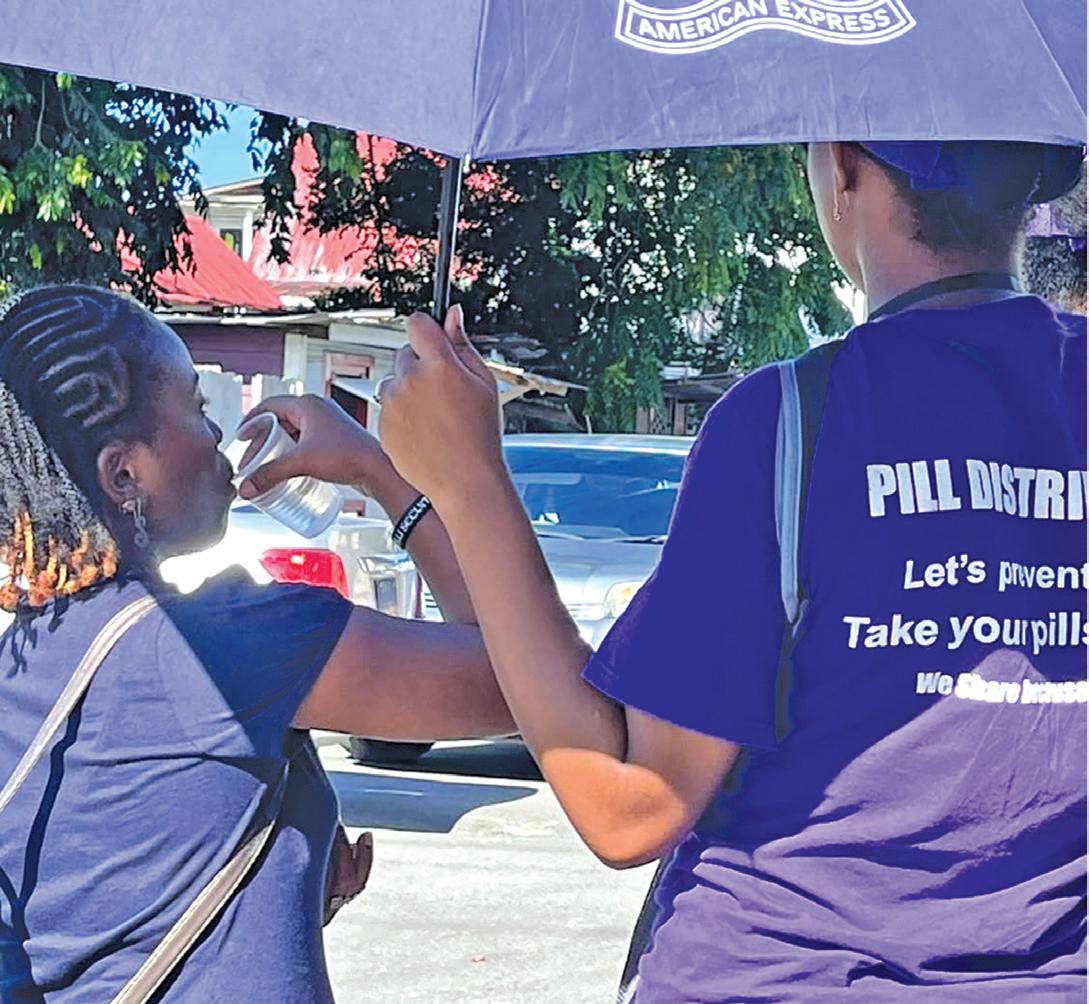
filariasis, leishmaniasis and leprosy disease programmes or projects, with significant improvement over the years.
Just last year, Health Minister Dr Anthony had stated that leprosy is on the decline.
Speaking on the filariasis programme, Sampson revealed that significant strides have been made after the programme was launched in 2000. Minister Anthony also noted in 2024 that instances of filaria have vastly declined.
Not many are educated on what is filaria, or how it’s caused, Sampson not-
ed, but despite a mixed response from public, though mostly good feedback, she is hopeful of a future campaign, planning for the second quarter of this year. Dermal leishmaniasis is caused by sandflies and progressively damages the skin, she explained. The disease remains present in Regions Seven, Eight, Nine, and Ten, as well as some areas in Region Two, she outlined. She noted that many miners, soldiers, and loggers are at risk of developing leishmaniasis (also known as bush yaws) due to their work in endemic regions.
Ahead of the Second World Health Organisation’s (WHO) Global Conference on Air Pollution and Health in March 2025, the global health community is making an urgent call to action for clean air.
The community is urging Governments, business leaders and policy-makers, to act swiftly to stop air pollution and save lives.
A WHO news release noted that air pollution is responsible for at least 7 million deaths each year, contributing to a growing global health crisis, with the vast majority of deaths caused by non-communicable diseases such as cardiovascular issues, respiratory diseases and lung cancer.
“Air pollution is a silent killer. On a global scale, air pollution trends remain largely unchanged in the last 10
years, impacting our health at each breath we take,” said Dr Maria Neira, Director, Department of Environment, Climate Change and Health, at the World Health Organisation.
She urged leaders to make “bold commitments”, and called on the health community to “continue advocating to protect our future.”
According to WHO, the good news is that air pollution deaths are preventable.
Health and care workers, patients, health advocates and civil society organisations are demanding bold, decisive actions from world leaders. Clean air is a human right and critical to the health and well-being of everyone.
The release noted that global health cost associated with exposure to air pollution is estimated at US$ 8.1 trillion
in 2019.
It added that the world is paying for the health consequences of air pollution, yet less than 1 per cent of global development aid is dedicated to action to improve air quality in low- and middle-income countries, home to the most vulnerable populations.
“Breathing clean air is undeniably essential for everyone to live, and essential for the right to a healthy environment,” said Astrid Puentes Riaño, UN Special Rapporteur on the human right to a healthy environment.
“Therefore, Governments and businesses must take pending urgent action to implement effective measures to guaranteeing it.”
Citing that now is the time to tackle this crisis, the WHO posited that investing in cleaner air is not only a mor-
al health imperative but also a sound economic strategy to reduce health-care costs, boost productivity and drive sustainable development while mitigating climate change.
According to the release, key actions the health community would like to see from world leaders and stakeholders, in order to safeguard public health and ensure clean air for all, include Governments enforcing strict air quality standards, reduce emissions at the source, and align with WHO’s global air quality guidelines.
The call to action also demands that Governments and businesses transition away from fossil fuels fairly and equitably, ensuring the clean energy transition is inclusive and accessible to all.
It also demands that leaders enhance monitoring sys-
tems and institutional capacity to effectively address air quality challenges, and increase funding, both domestic and international, to elevate clean air as a priority on global and national agendas.
It also advocated for the creation and support of interdisciplinary and multi-sectoral workforce development; awareness-raising and training initiatives that empower communities and stakeholders to tackle air pollution effectively.
The WHO added that the health community will continue to advocate for these urgent measures, emphasising that clean air is not a luxury but a necessity for public health and well-being. The time to act is now, and we cannot afford to wait any longer, it declared.
WHO’s Second Global Conference on Air Pollution
and Health, taking place in Cartagena, Colombia, 25–27 March 2025, will bring together global leaders, experts and advocates to discuss and advance solutions to the air pollution crisis.
It suggests that decision makers from countries, cities, private sector and donours, take bold and immediate action to secure clean air for all.
The Conference, the WHO release concluded, presents a key opportunity for Governments and other stakeholders to commit to transformative actions that will protect public health and the environment for generations to come.
In 2024, Guyana ranked 28th out of 180 countries on the Global Environmental Performance Index (EPI) for its air quality.
































Take care of domestic issues before someone criticizes you. Be realistic and make changes that help you live within your means. Tidy up, and you’ll find something you thought you lost.
Keep the momentum going. Make the domestic changes that will make your life easier. Refrain from letting uncertainty and hesitation cost you. Positive change requires action.
Lend a helping hand, and you’ll learn something about yourself and the people you encounter. A professional opportunity is apparent. Network and promote who you are and what you can do.
Rethink your approach to learning and networking. It’s time to be bold, show confidence and make suggestions. Your positive attitude and determination will be difficult to ignore.
Keep watching, but don’t bring about change until you can handle the outcome. Take your seat at the table, observe and remain calm. Your self-confidence, composure and ability to get things done will lead to victory.
Changing your surroundings will offer you a different perspective. A joint venture has more potential than you realize. Put a plan in place that distributes the workload and expenses evenly.
Use your intelligence and experience to talk through any situation dealing with sensitive issues. Anger won’t help you get what you want, but understanding and compassion will.
Take a break; lose yourself in something that brings you joy or allows you to be creative. Discovering unusual places and connecting with intellectually stimulating people will give you the boost you need.


Rethink your financial situation and how you earn your living and handle your cash flow. Say no to anyone who makes you feel inept. Associate with people who cheer you on.


Take control, and you’ll save yourself money and grief. If you give someone an inch, they will take a mile. Protect your position and reputation. Stay on top of the competition and the changes that benefit you most.



Focus on financial matters and budgeting to support your lifestyle. Getting upset over uncontrollable situations won’t help you get ahead. Discipline and hard work are your tickets to success.

An open mind and a kind word will help you find your way forward. Make a point to do your best and to have a positive impact on the people you love. Be the one to make a difference.




Abhishek Sharma demolished records left, right and centre – and with it England’s pace-laden T20I attack - -to power his way to 135 from 54 balls, the highest score ever made by an India batter in T20Is.
On his watch, India romped to a massive total of 247 for 9, which would prove to be overkill in a crushing 150-run victory, and with it a 4-1 series scoreline.
In response, Phil Salt reprised some of the form that had lit up last year’s Indian Premier League (IPL), to crack his way to a 21-ball fifty, but his was a lone hand in an overwhelmed England reply, as they stumbled to 97 all out in 10.3 overs.
Even after his commanding display, there was no keeping Abhishek out of the game. First, he was on hand in the covers to intercept Ben Duckett’s first-ball drive and hand Mohammed Shami the first of his three wickets.
And then, after Jos Buttler, Harry Brook, and Liam Livingstone had each fallen in their quest to stay in touch with a rate of more than two a ball, Abhishek was tossed the ball for the ninth over, and duly bagged two more in five balls, as Brydon Carse and Jamie Overton each holed out.
Abhishek tears it up
All of that, however, was somewhat superfluous to the day’s main ac-

David Miller’s 35-ball effort against Bangladesh in 2017 as the second-fastest in a contest between Full Member nations. On Abhishek’s watch, India romped to 95 for 1 in the six-over powerplay, another national record … and all this after being stuck in by Buttler, too.
At times, it was like watching a full-fidelity game of Stick Cricket, with Abhishek’s utter faith in the conditions, and in England’s often guileless lengths, encouraging him to plant his front foot to pace and spin alike, and launch even 150-kilometre-per-hour (mph) deliveries with impunity through the line.
At the 10-over mark of the innings, the sky was the limit for India’s ambitions.
tirely contained, however. Abhishek reasserted himself as Carse’s final over went for 17, and though a game of cat-and-mouse with Adil Rashid resulted in a miscued wrong’un to deep cover, that wasn’t until Abhishek had connected with two more sixes back over the bowler’s head.
Dube’s return to the fray
There was no shortage of needle after the events at Pune, where Harshit Rana’s



mitment to the rumpus.
The fact that Dube was back in action, just 48 hours after a heavy blow to the helmet from Overton, was further reason for England to look slightly askance at that call. But not only did Dube show no ill-effects, he underlined the fact that his own bowling – though noticeably less express than Harshit’s – was every bit as capable of making an impression.
His first delivery, at the start of the eighth over,
as their go-to third seamer in Test cricket, and many of those same big-hearted traits were on show in the gruesome match situation Sunday.
Carse began his spell with India rattling along at more than 15 runs an over, having reached 127 for 1 after eight, but from the outset, his ability to hit hard lengths with canny changes of pace set him apart from the more one-dimensional block-knocking approach that his colleagues had settled for.
thrilling to behold. Archer’s first-over duel with Sanju Samson featured two sixes, 16 runs, and a nasty cut to the finger from a third-ball lifter into the gloves; Wood’s follow-up barely dipped below 150kph, as Samson holed out to deep square leg – his fifth dismissal to the pull shot in as many innings this series.




Mark Wood and Jofra Archer set the tone for England’s approach with another deeply unsubtle powerplay display, albeit it was
Suryakumar Yadav had a similar experience – once again India’s Captain came a cropper to a leading edge as he finished his series with just 28 runs in five innings. But at the other end was Abhishek, and so it mattered little.(ESPNcricinfo)
India (20 ovs maximum)
Sanju Samson † c Archer 16
Abhishek Sharma c Archer b Rashid 135
Tilak Varma c †Salt 24
Suryakumar Yadav (c) c †Salt 2
Shivam Dube c Rashid 30
Hardik Pandya c Livingstone 9 Rinku Singh lbw 9
Axar Patel run out (Livingstone/†Salt) 15 Mohammed Shami not out 0 Ravi Bishnoi c Carse 0 (lb 4, w 3) 7 20 Ov (RR: 12.35) 247/9
Did not bat: Varun Chakravarthy
Fall of wickets: 1-21 (Sanju Samson, 1.5 ov), 2-136 (Tilak Varma, 8.6 ov), 3-145 (Suryakumar Yadav, 10.2 ov), 4-182 (Shivam Dube, 13.2 ov), 5-193 (Hardik Pandya, 14.4 ov), 6-202 (Rinku Singh, 15.5 ov), 7-237 (Abhishek Sharma, 17.6 ov), 8-247 (Axar Patel, 19.5 ov), 9-247 (Ravi Bishnoi, 19.6 ov) • O-M-R-W
Jofra Archer 4-0-55-1
Mark Wood 4-0-32-2
Jamie Overton 3-0-48-1
Liam Livingstone 2-0-29-0
Adil Rashid 3-0-41-1 Brydon Carse 4-0-38-3 England (T: 248
Duckett c Abhishek Sharma
b Mohammed Shami 0 Jos Buttler (c) c Tilak Varma
It was a points fiesta at on Saturday at the Cliff Anderson Sports Hall as spectators witnessed over 200 points scored in the Guyana Basketball Federation’s One Guyana Basketball Premier League. Region 10 sides Victory Valley Royals, Kwakwani Untouchables, and University of Guyana Trojans emerged victorious.
The opening game of the night saw the Royals, undefeated in their first pair of games, battling Black Caimans, who were still searching for their first win. From the jump ball, the Royals created huge separation between themselves and the Caimans

with the first-quarter scoreline reading 44-10.
The Royals' dominance did not stop in the second quarter, as they managed to put up 22 points to the Caimans’ four, resulting in a score of 66-14.
With the margin of difference already 52 points, it was a forgone conclusion that the Royals would secure the win, as the Caimans’ frozen offence showed little signs of warming up. The offensive and defensive play of the Victory Valley side continued to be spectacular in the third quarter, as they scored 26 points and kept the Caimans to 10 points, for a scoreline of 92-24.
The Royals headed
back to their hometown all smiles as they became the first team to record an astonishing 102-point win over the hapless Black Caimans.
The second game of the night would see Kwakwani Untouchables look to extend their unbeaten streak against an East Coast All-Stars side eager for their first points. The Untouchables led the way from the jump ball with a first-quarter margin of 308.
The second quarter saw the rampage of destruction continue, as Kwakwani put the ball through the net for 24 points while the All-Stars could only manage three.

India’s spin bowlers continued to be as brilliant as they’ve been throughout the tournament to take them to their second consecutive International Cricket Council (ICC) Under-19 T20 World Cup title. On the back of the efforts of Aayushi Shukla, G Trisha, Vaishnavi Sharma and Parunika Sisodia – who took nine wickets between them, India restricted South Africa to 82. Trisha then starred with the bat as well, helping chase down a simple target in 11.2 overs to leave a heartbroken South African side in tears at the Bayuemas Oval in Kuala Lumpur, Malaysia.
After Captain Kayla Reyneke opted to bat, South Africa started strongly in the first over with opener Jemma Botha belting two fours off VJ Joshitha. But trouble began as early as the second over with Sisodia having Simone Lourens bowled for a duck, with a skiddy delivery that deflected off the batter’s pads and onto the stumps.
India put the brakes on almost instantly after that, but Botha – South Africa’s top scorer of the tournament – once again displayed her quality, hitting Joshitha for a four down the ground. With Shabnam Shakil’s introduction in the fourth over came the crucial wicket of Botha, thanks to a stunning catch by wicketkeeper G Kamalini, who threw herself to the right to grab a onehander.
One brought two for India, as left-arm spinner Shukla struck first ball in the very next over, having Diara Ramlakan bowled with a straighter one for 3. At the end of the powerplay, South Africa were in trouble at 29 for 3.
India’s spinners maintained the stranglehold on their opposition, drying up the runs in the middle overs, with no boundaries scored between seven and 14. In that passage, two more wickets fell, with Trisha removing Reyneke for 7 and Shukla taking her second
by knocking Karabo Meso’s middle stump.
Mieke van Voorst, South Africa’s highest scorer in the game, broke the pressure with the team’s first boundary in 56 balls, and went on to hit a couple more. But Trisha’s double strike in the 18th over once again pegged South Africa back, with both van Voorst and Seshnie Naidu getting out trying to go for big shots.
Fay Cowling then hit the first and only six of the game, but Vaishnavi recovered very well removing Cowling and Monalisa Legodi, both bowled trying to sweep, in the same over. Sisodia removed Ashleigh van Wyk off the last ball of the innings as South Africa lost five wickets in 14 balls to crumble to 82 all out. India were also superb on the field, especially with their ground fielding, with only one difficult return catch missed by Trisha.
India charged at the total from the first over, with Trisha hitting three fours off the first five balls she faced. She took on legspinner Naidu for three fours in the fourth over as well. Reyneke then broke through, having Kamalini caught at long-on, but India did not slow down even then. Sanika Chalke joined Trisha and brought out a classy cover drive off her fourth ball as India mowed down more than half of the total within the powerplay.
Trisha was dropped on 38 in the covers in the 10th over, but even a wicket wouldn’t have made much of a difference, with India needing just 16 runs. Chalke wrapped it all up for India in the 12th over with a boundary and Trisha finished as the highest-run scorer of the tournament with 309 runs and was named the Player of the Match and the Player of the Tournament. (ESPNcricinfo)

South Africa Women Under-19s (20 ovs
b Shabnam Shakil 16 Simone Lourens
b Sisodia 0 Diara Ramlakan
b Aayushi Shukla 3 Kayla Reyneke (c) c Sisodia
b Trisha 7 Karabo Meso †
b Aayushi Shukla 10 Mieke van Voorst st †Kamalini
b Trisha 23
Fay Cowling
b Vaishnavi Sharma 15
Seshnie Naidu
b Trisha 0
Ashleigh van Wyk c Vaishnavi Sharma
b Sisodia 0 Monalisa Legodi
b Vaishnavi Sharma 0 Nthabiseng Nini not out 2
Extras (lb 5, w 1) 6
Total 20 Ov (RR: 4.10) 82
Fall of wickets: 1-11 (Simone Lourens, 1.6 ov), 2-20 (Jemma Botha, 3.6 ov), 3-20 (Diara Ramlakan, 4.1 ov), 4-40 (Kayla Reyneke, 11.4 ov), 5-44 (Karabo Meso, 12.4 ov), 6-74 (Mieke van Voorst, 17.5 ov), 7-74 (Seshnie Naidu, 17.6 ov), 8-80
With no competition truly being offered, the Untouchables went through the All-Stars' defence effortlessly, putting together powerful attacks for 21 points versus their opponents’ five points with a third-quarter score of 7927. The Kwakwani Untouchables eventually recorded a 78-point victory.
Linden side Kings did not follow in the footsteps of their fellow Region 10 sides as they plummeted to a 34-point defeat at the hands of an unbeaten University of Guyana Trojans with the scoreboard reading 63-29 at the end of the game.

(Fay Cowling, 18.3 ov), 9-80
(Monalisa Legodi, 18.5 ov), 1082 (Ashleigh van Wyk, 19.6 ov)
Bowling O-M-R-W
VJ Joshitha 2-0-17-0
Parunika Sisodia 4-0-6-2
Shabnam Shakil 2-0-7-1
Aayushi Shukla 4-2-9-2
Vaishnavi Sharma 4-0-23-2
Gongadi Trisha 4-0-15-3
India Women Under-19s (T: 83 runs from 20 ovs)
G Kamalini †c Lourens b Reyneke 8
Gongadi Trisha not out 44 Sanika Chalke not out 26
Extras

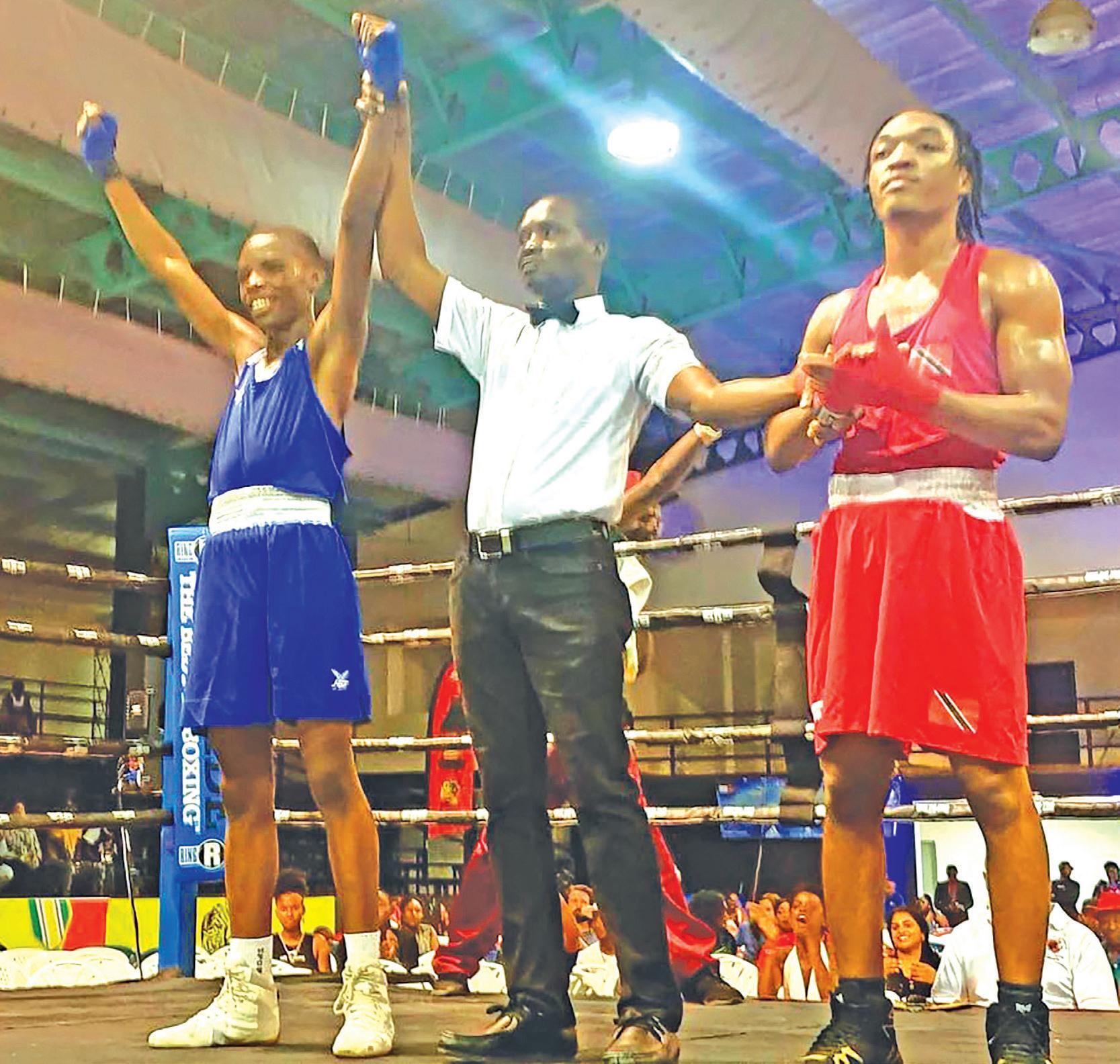
The Andrew “Six Head”
Lewis Gym was a cauldron of youthful energy and fierce competition on Saturday, as the Pepsi Michael Parris Under-16 Boxing Tournament delivered an evening of fistic fury.
Hosted by the Guyana Boxing Association (GBA), the event saw promising young pugilists step into the ring, eager to showcase their skills, resilience, and hunger for victory.
Leading the charge was Ken Harvey of the Andrew Lewis Boxing Gym (ALBG), whose dominant performance against Khumda Alexander of P&P Boxing Gym earned him the title of best boxer.
Harvey demonstrated superior ring generalship, using crisp combinations, excellent footwork, and a
rock-solid defence to outpoint his opponent.
His tactical precision and relentless aggression kept Alexander on the back foot throughout the bout, securing a well-earned decision victory.
Harvey’s standout performance was a testament to the exceptional coaching of Lennox Daniel, who was later recognised as the best coach of the tournament.
The Andrew Lewis Boxing Gym celebrated further success, clinching the Best Gym award, reaffirming its status as a powerhouse in Guyanese amateur boxing.
Meanwhile, the Rose Hall Jammers Boxing Gym emerged as the runner-up gym, proving its depth of talent and commitment to nurturing young fighters.
The tournament, named
in honour of Guyana’s only Olympic medallist, Michael Parris, continues to serve as a crucial proving ground for the nation’s next generation of boxing stars.
Given the mix of sharp jabs, thunderous hooks, and tactical brilliance on display, the event highlighted the growing talent within the local boxing scene under the GBA.
GBA President Steve Ninvalle disclosed that Saturday’s Under-16 tournament is the first of 24 planned for this year.
Final results:
Best Boxer: Ken Harvey (ALBG)
Best Coach: Lennox Daniel
Best Gym: Andrew Lewis Boxing Gym
• Runner-up
Gym: Rose Hall Jammers Boxing Gym
The ExxonMobil Guyana Global Super League (GSL) 2025 has been confirmed to run from July 8 to July 18, 2025, organisers confirmed on Sunday.
All 11 matches of the tournament will, again, take place at the iconic Guyana National Stadium, Providence, East Bank Demerara (EBD), as five elite T20 teams from around the world compete for the coveted trophy.
The 2025 edition will mark the second instalment of this exciting tournament. The inaugural event in 2024 was won by the Rangpur Riders of the Bangladesh Premier League, who defeated Cricket Victoria in the final.
GSL’s first season will be remembered for thrilling cricket as well as confirming Guyana as a premier destination for world-class sporting events. Sir Clive Lloyd, GSL Chairman, expressed his enthusiasm for the upcoming tournament:
“The first GSL was a resounding success, with all five participating teams praising the exceptional facilities and warm hospitality they experienced in Guyana. We are excited to build on this momentum in 2025 and are delighted to confirm the tournament dates. The GSL continues to position Guyana as a key destination for international cricket and sports tourism.”

Olympic Kremlin, the star of Slingerz Stables, was named Horse of the Year at the One Guyana Thoroughbred Racing Awards held on Friday evening in Berbice.
The Brazil-bred champion’s dominance throughout the 2024 season made the recognition almost inevitable, as Olympic Kremlin completed an undefeated run with victories in the President’s Cup, Guyana Cup, and Showdown of Champions.
“We’re doing it all over again this year,” Slingerz Stable owner Javed Ali stated.
According to Ali, his aim to compete this year outside of Guyana, as he’s confident in the horse doing well against some of the top thor-
oughbreds in the Caribbean.
Olympic Kremlin arrived in Guyana as an already promising contender.
Bred in Brazil, this thoroughbred quickly made a name for itself in the South American racing circuit before being acquired by Slingerz Stables.
Known for explosive finishing speed and remarkable endurance, the horse seamlessly adapted to the Guyanese racing scene, establishing itself as the most formidable competitor of the year. Its unbeaten streak in 2024 not only solidified its status as the best horse in Guyana but also reaffirmed Slingerz Stables as the premier force in local horse racing.
With Olympic Kremlin
leading the charge, the stable continues to set the gold standard in horse racing in Guyana.
“When we got into horse racing, like we do in everything else at Slingerz, we wanted to dominate, so we made the investment and [it] has been paying off,” Ali noted.
The One Guyana Thoroughbred Racing Awards recognised not just individual brilliance but also the collective efforts of trainers, jockeys, and owners in elevating the standard of horse racing in the country.
According to Ali, Olympic Kremlin’s Horse of the Year title is a fitting tribute to a season of pure excellence –one that will be remembered for years to come.




